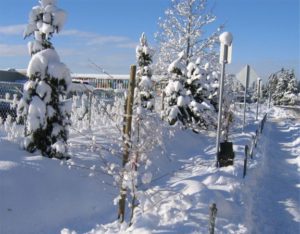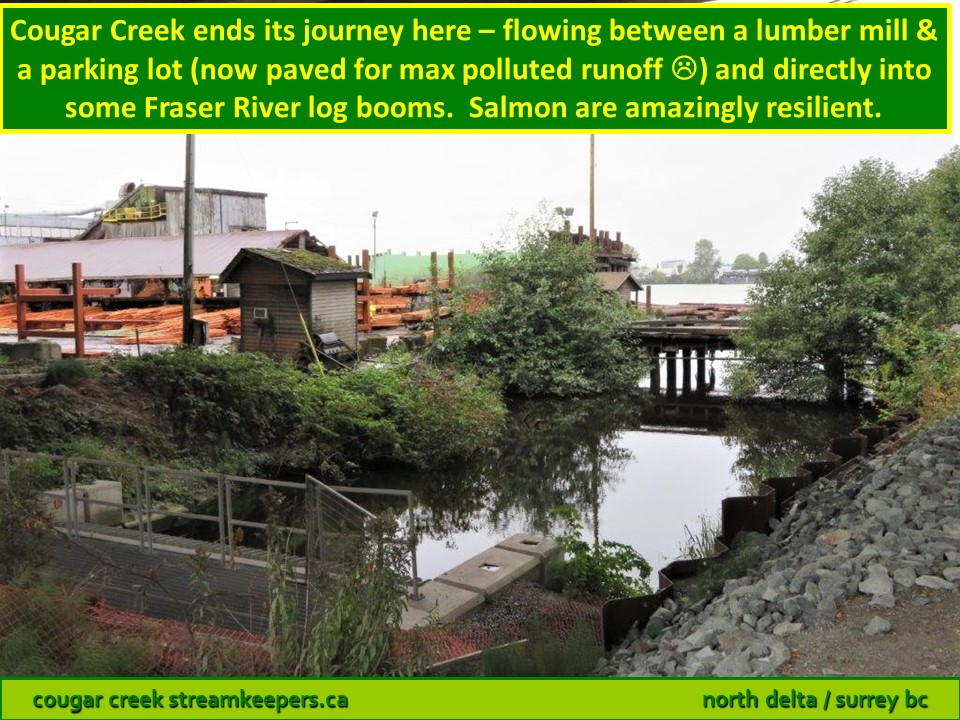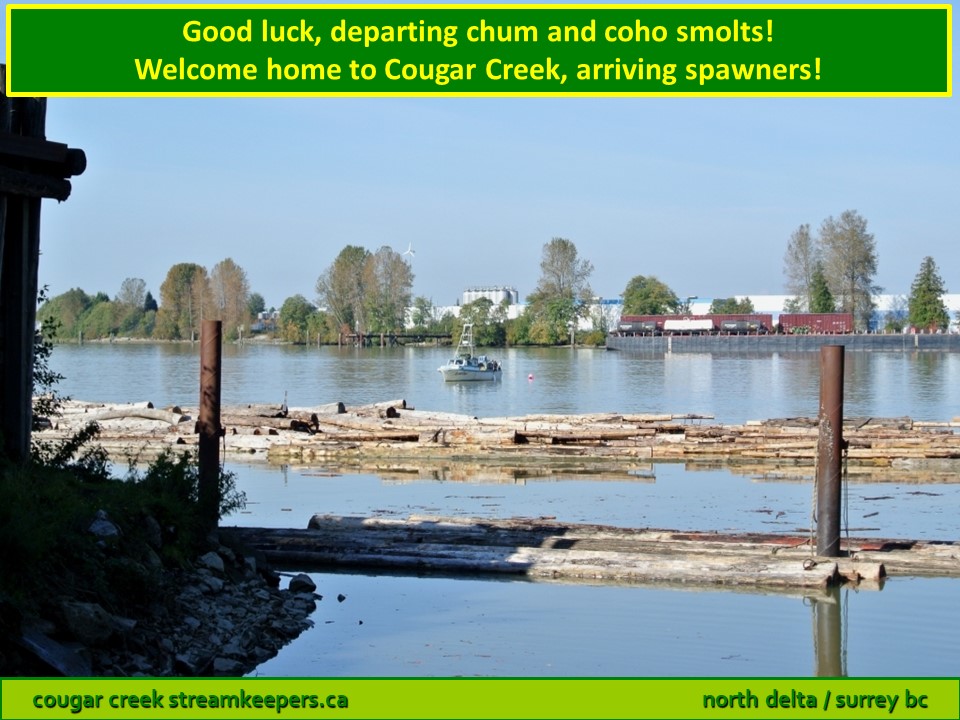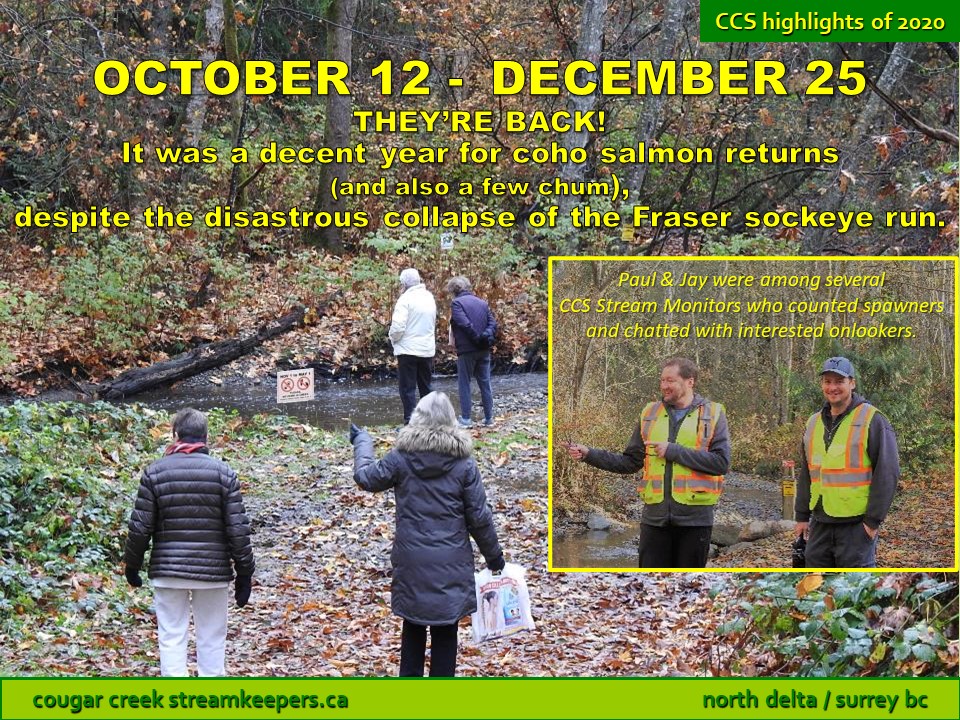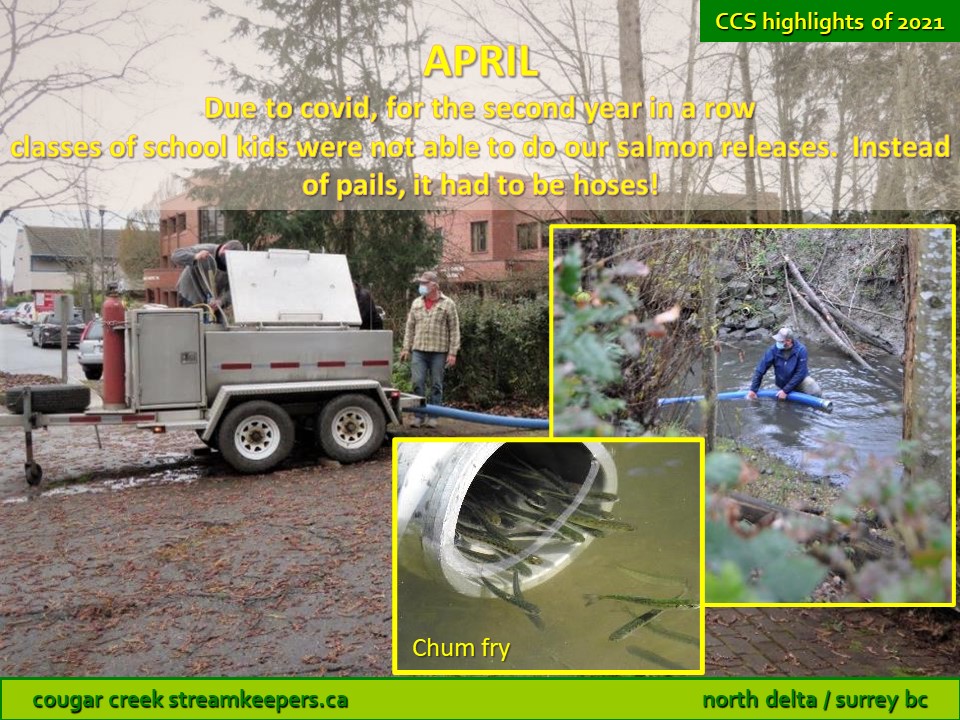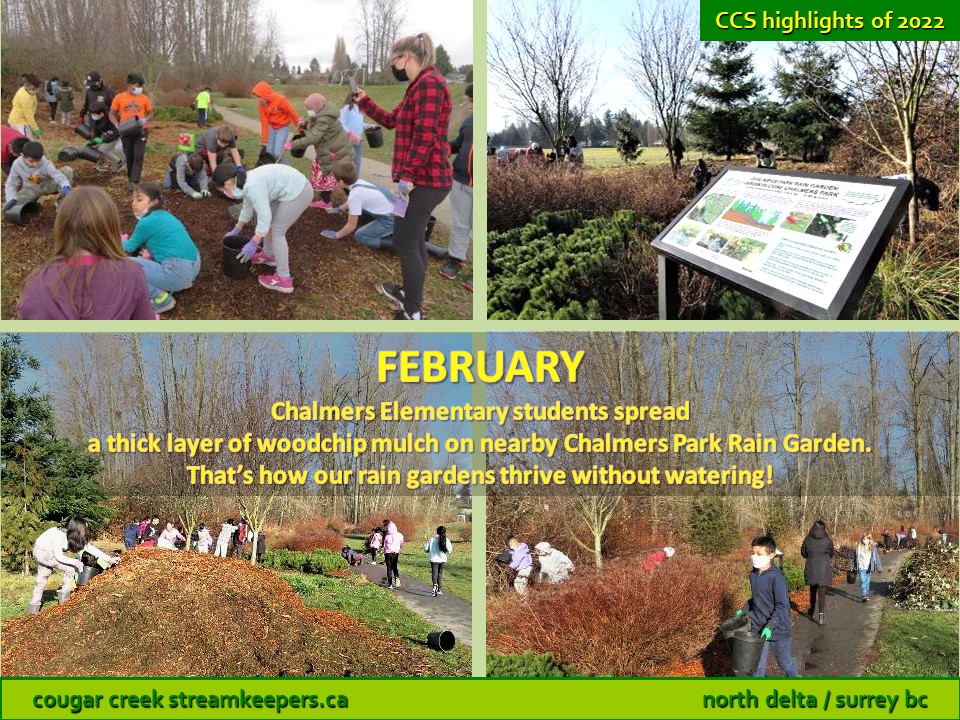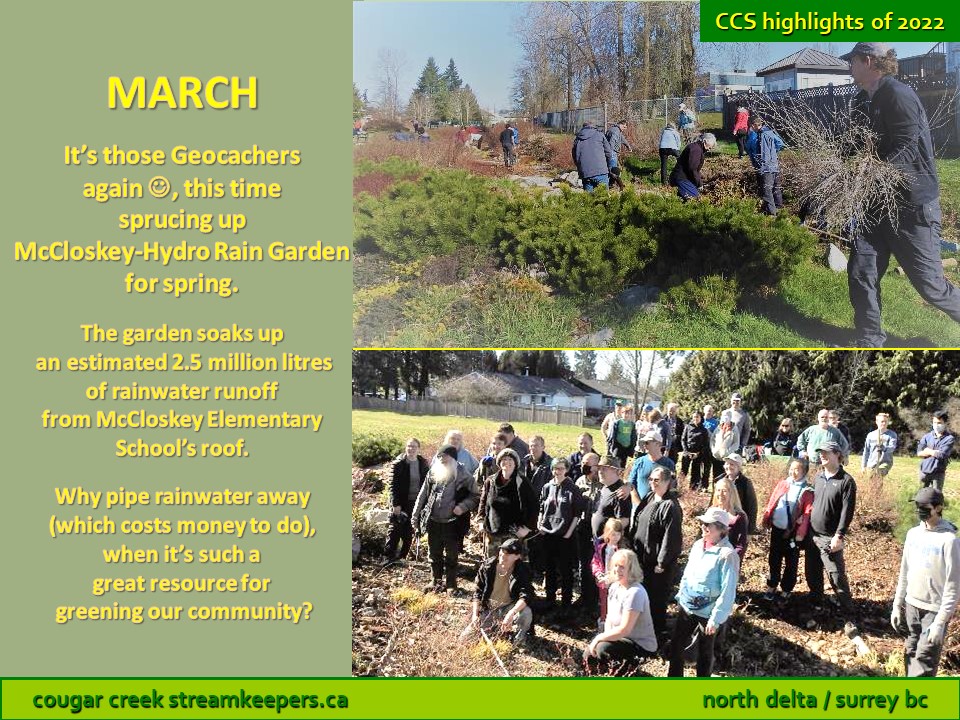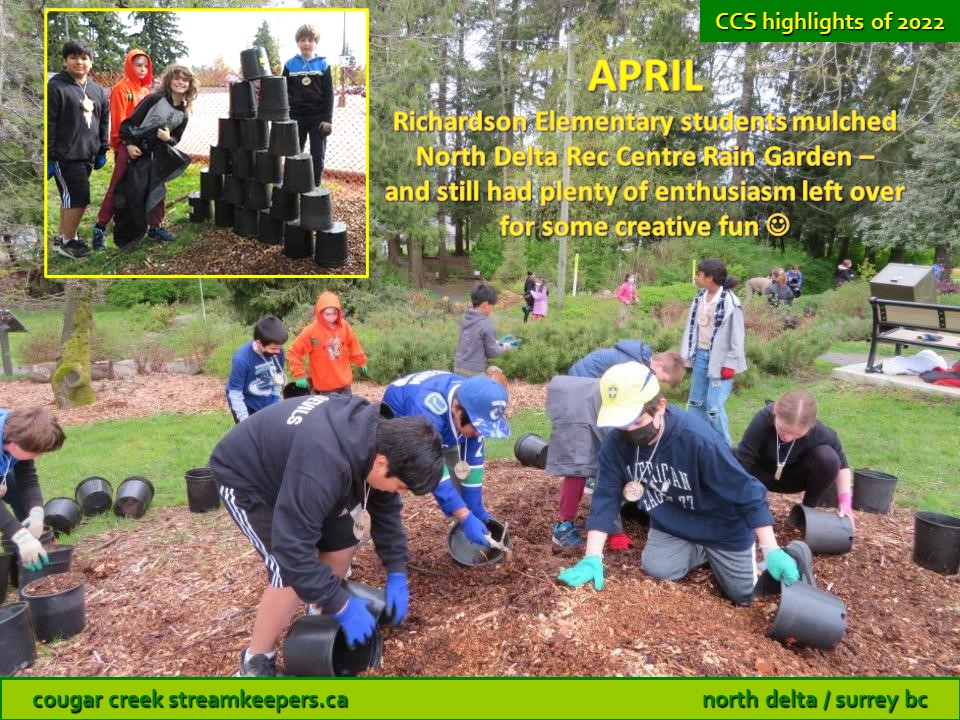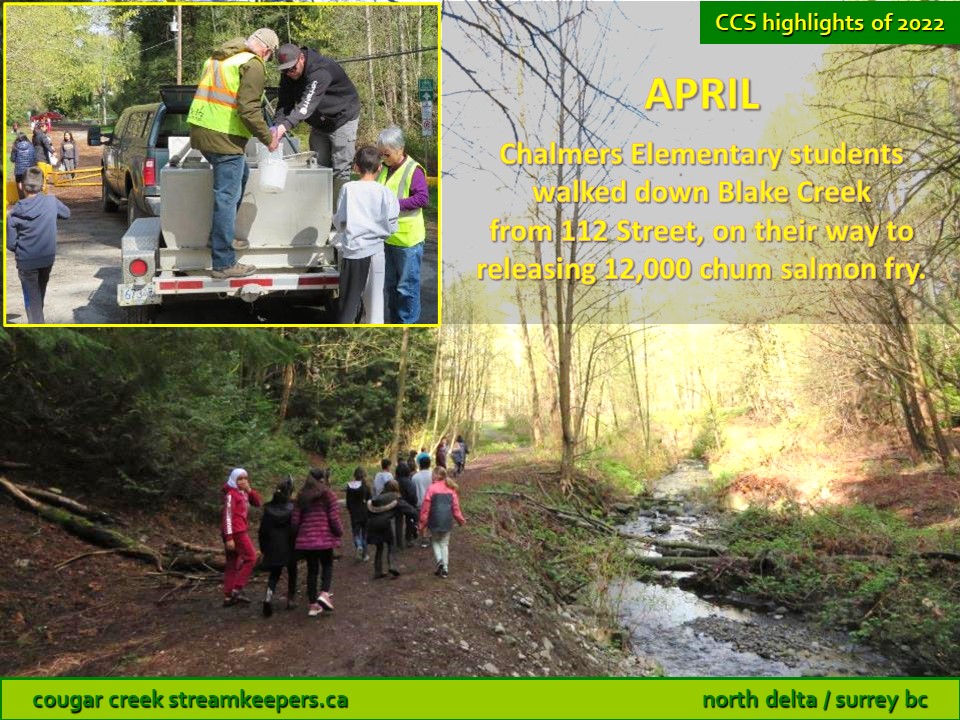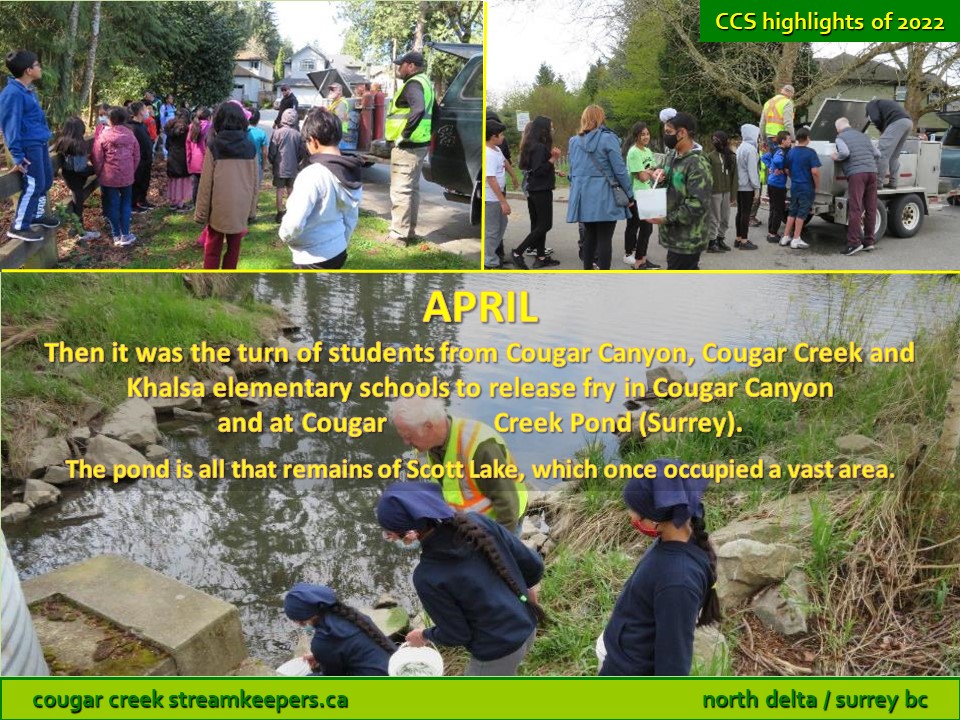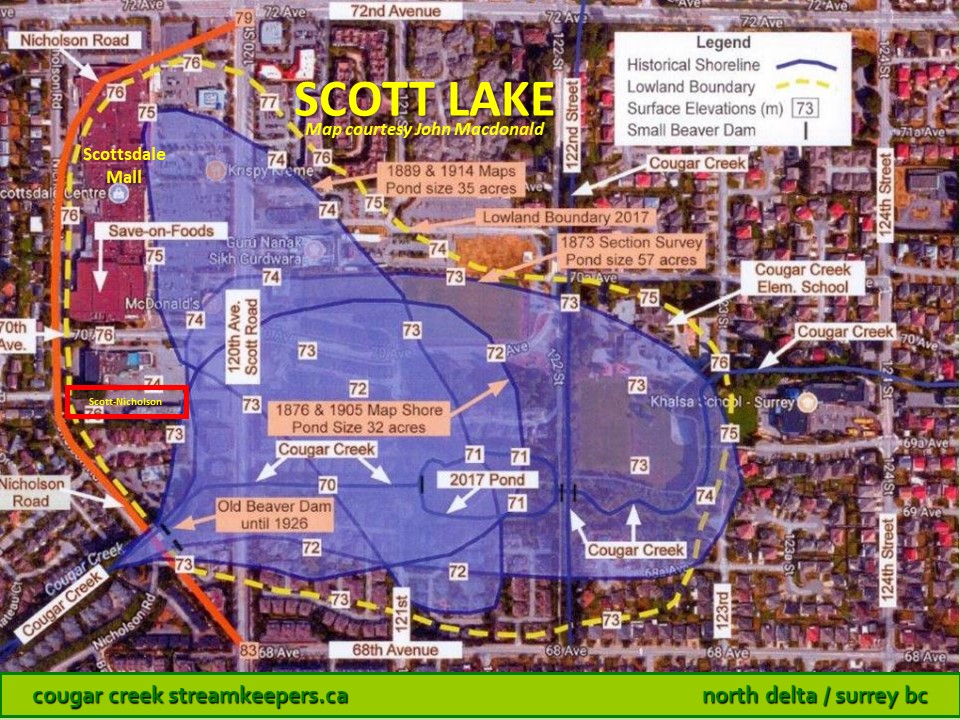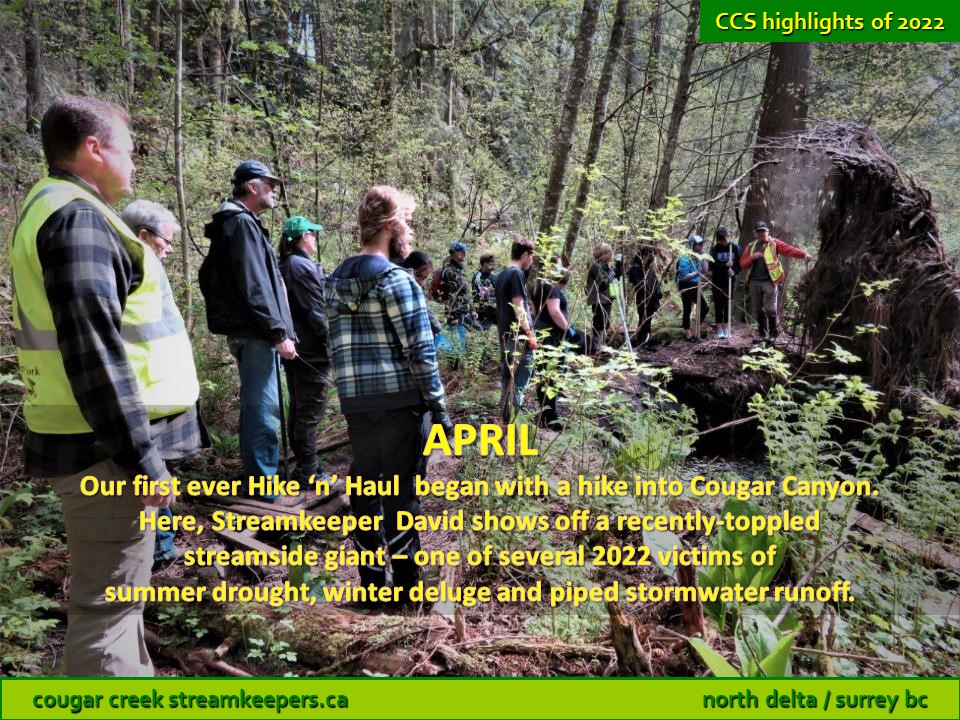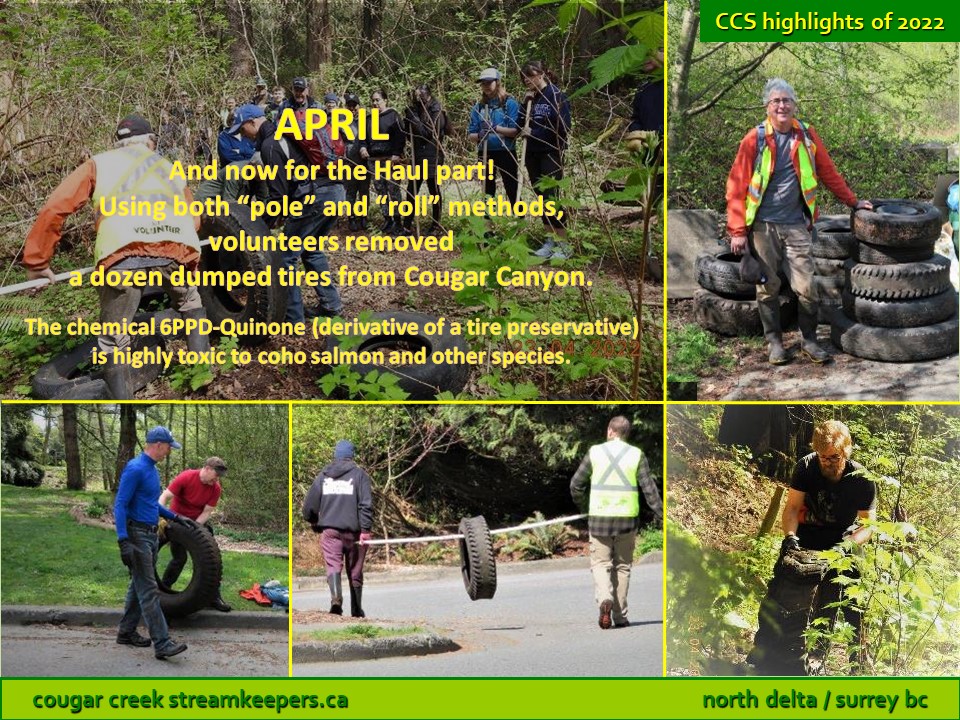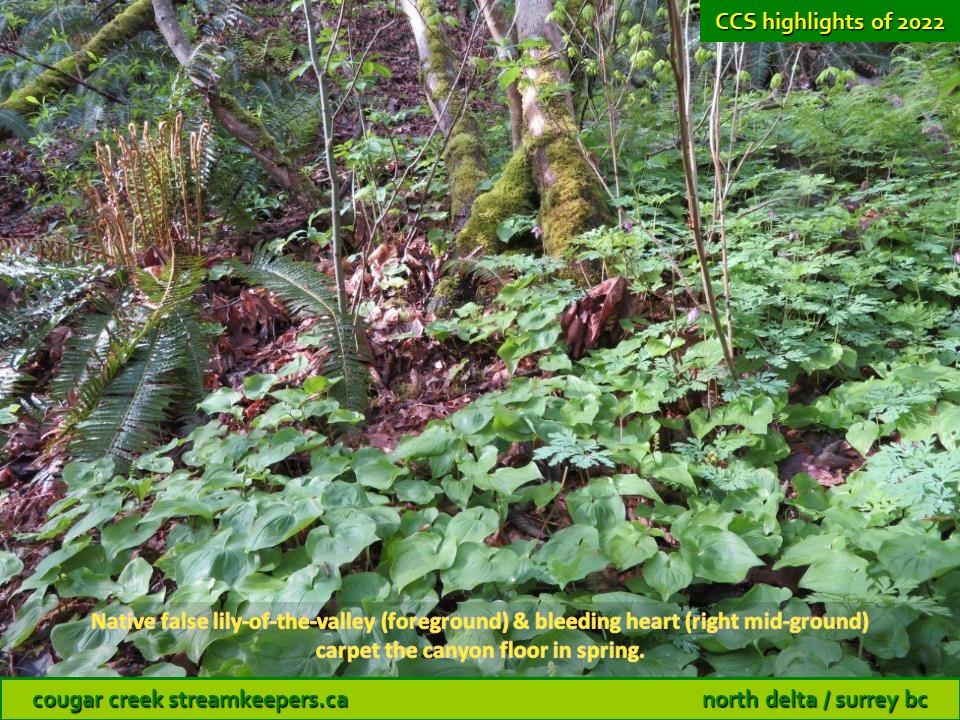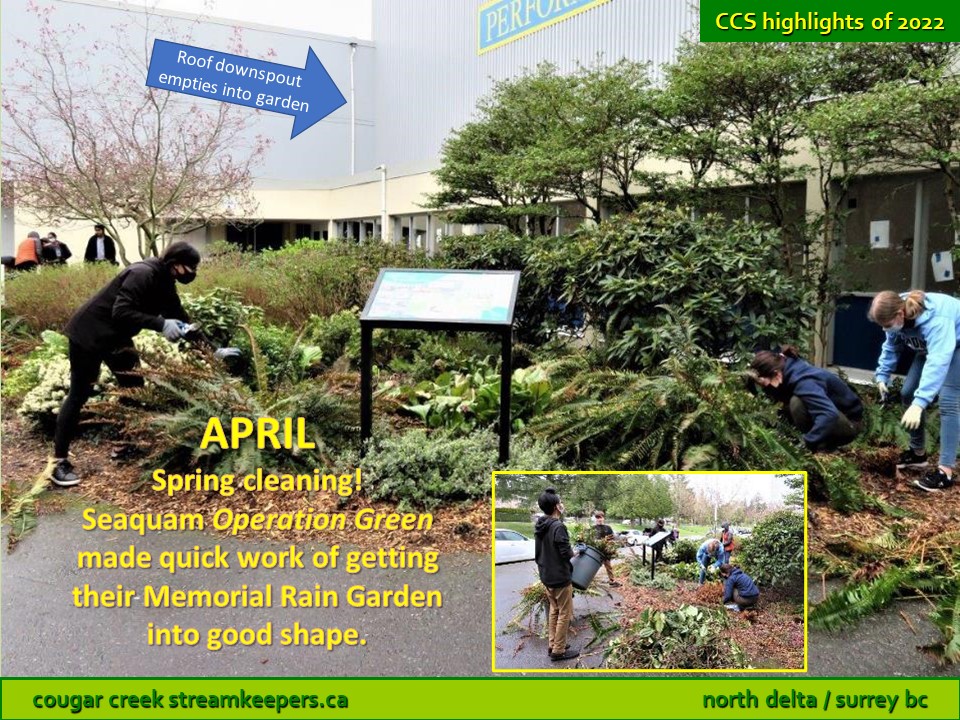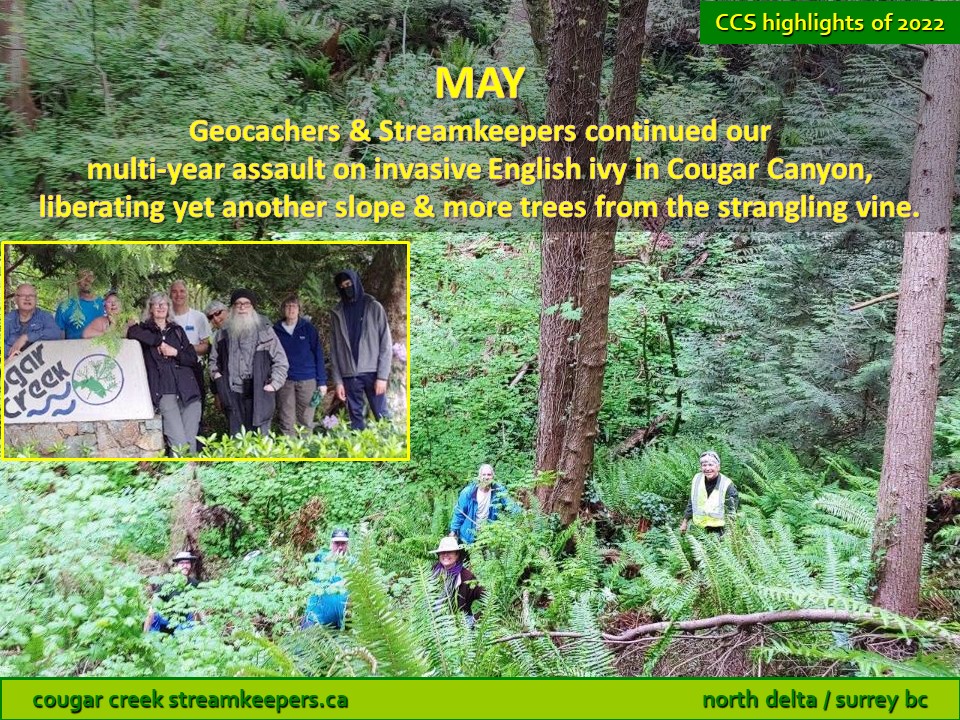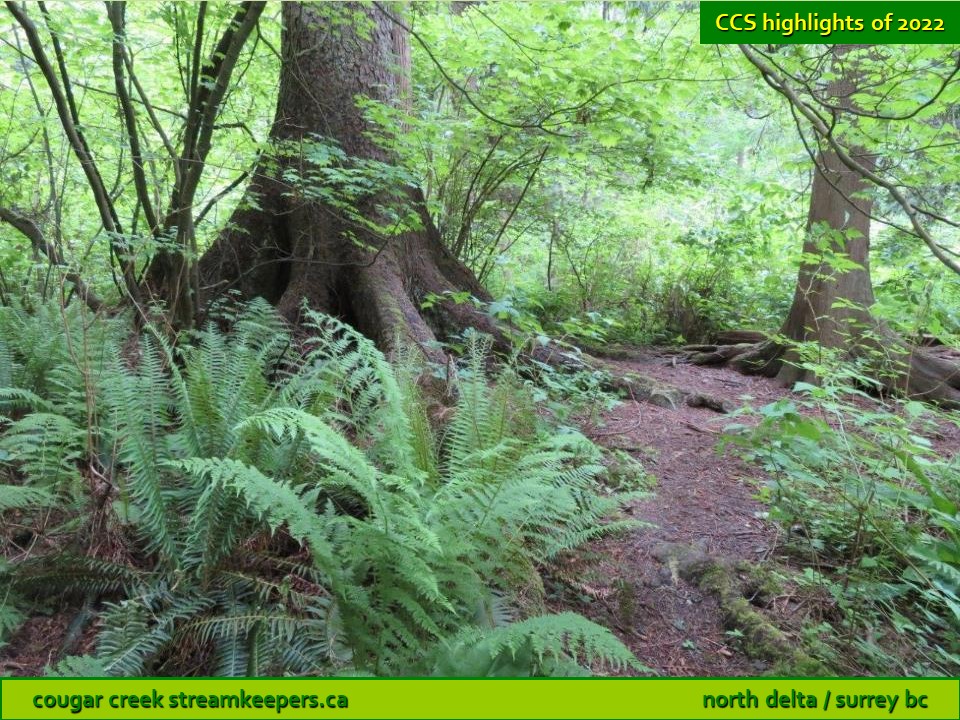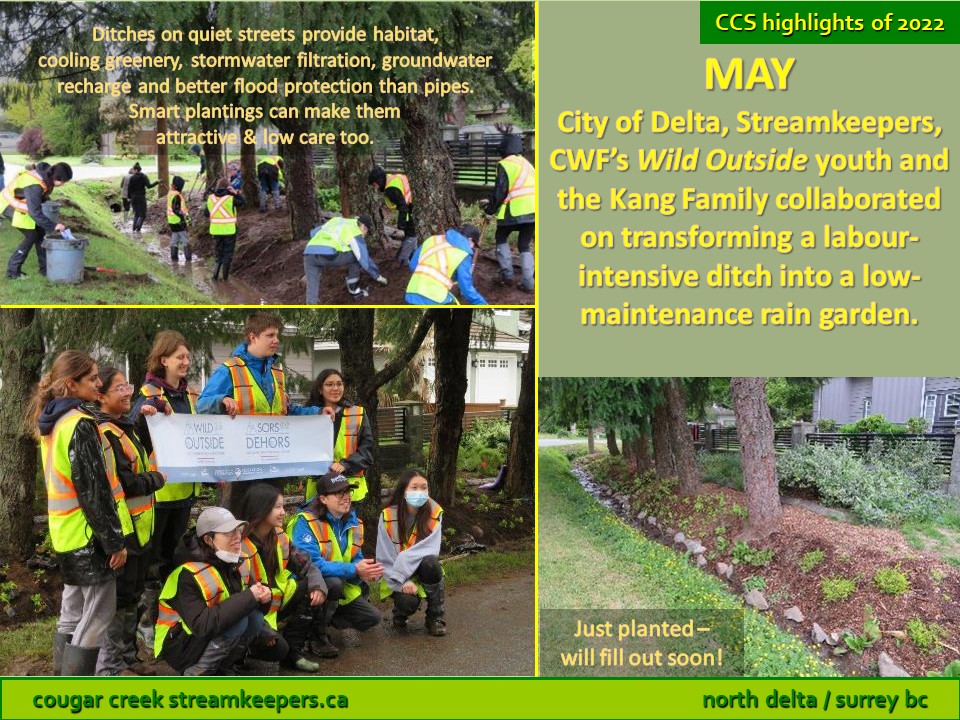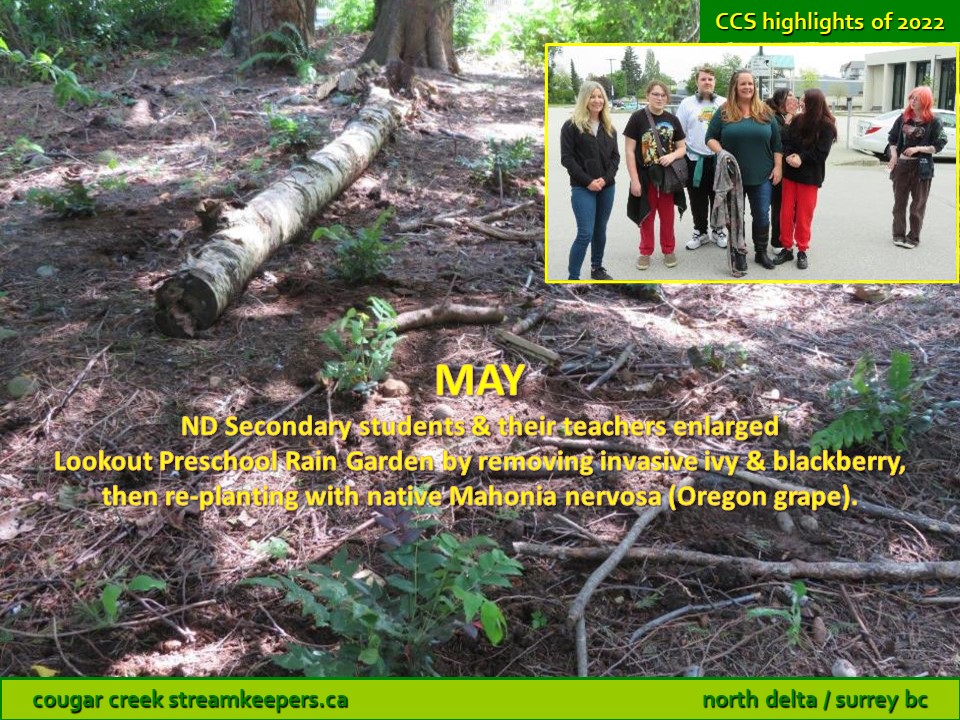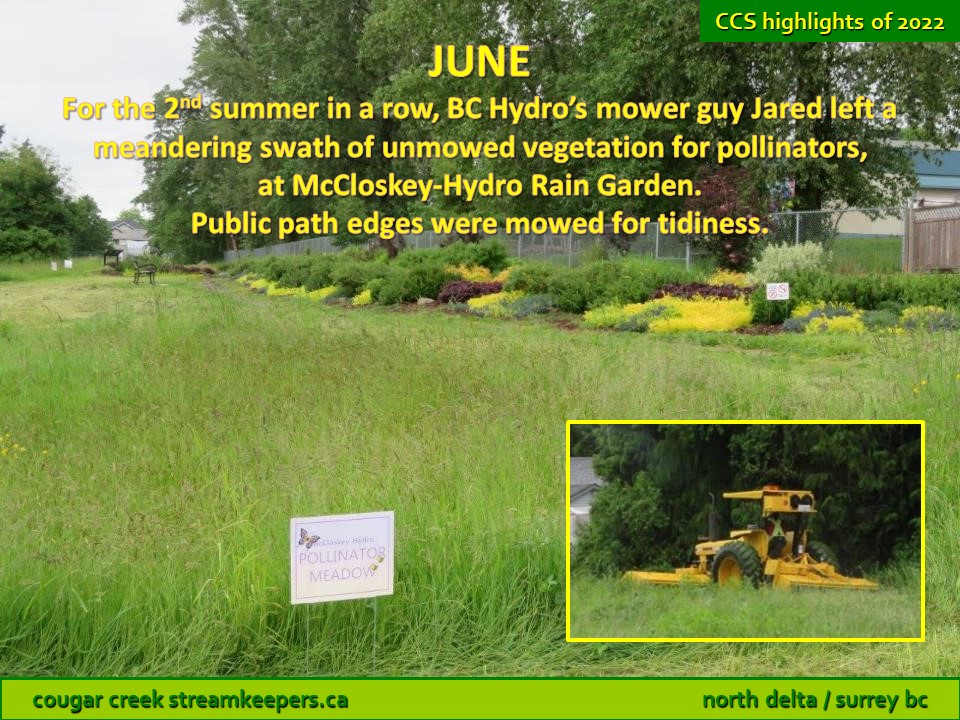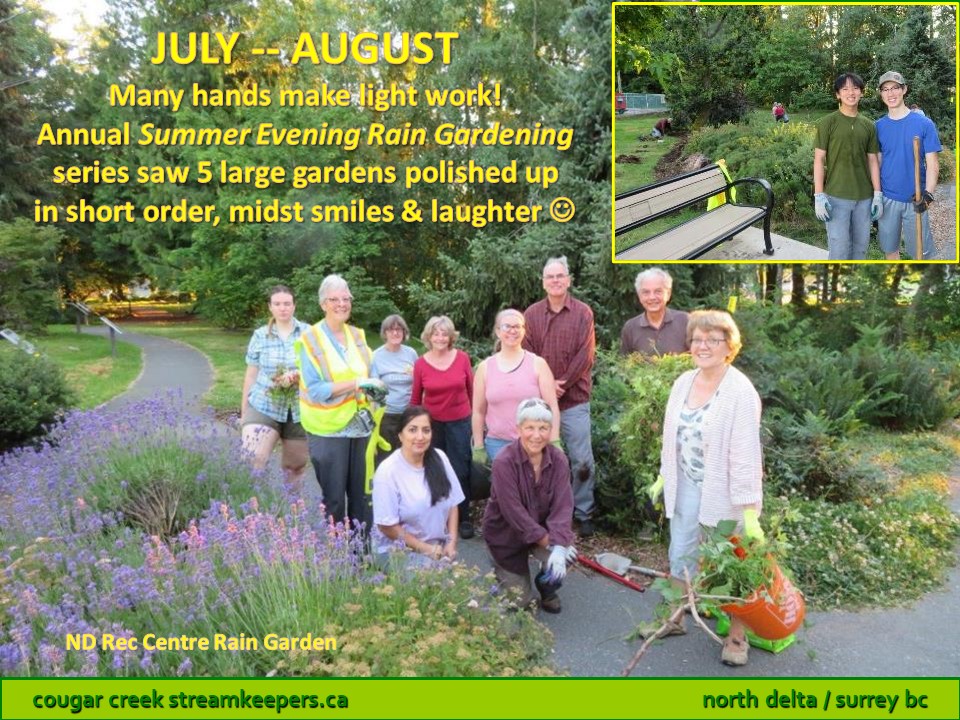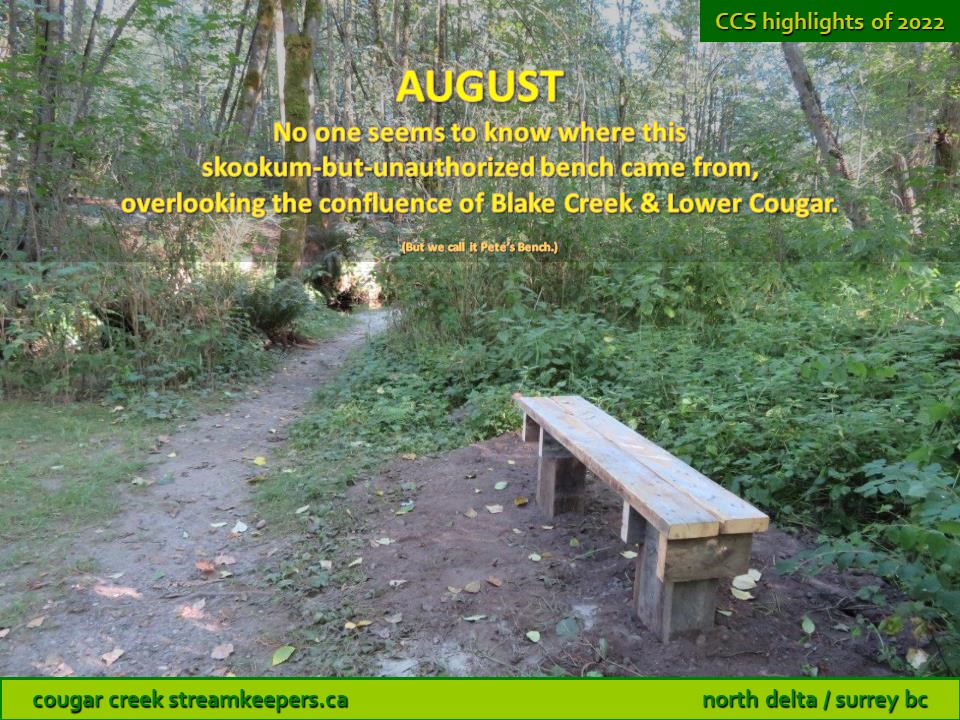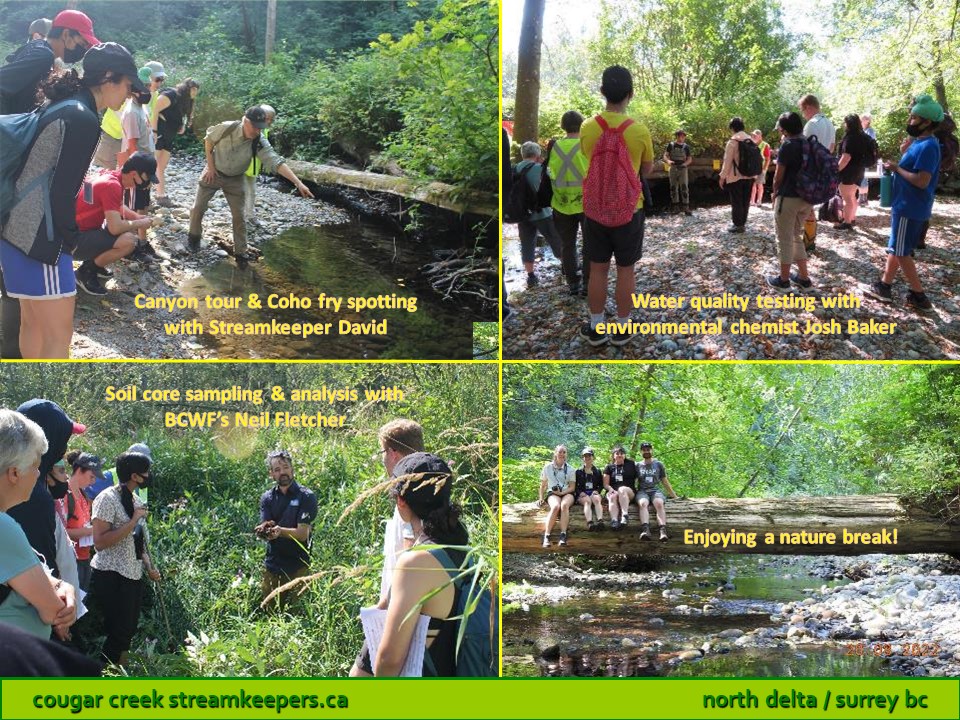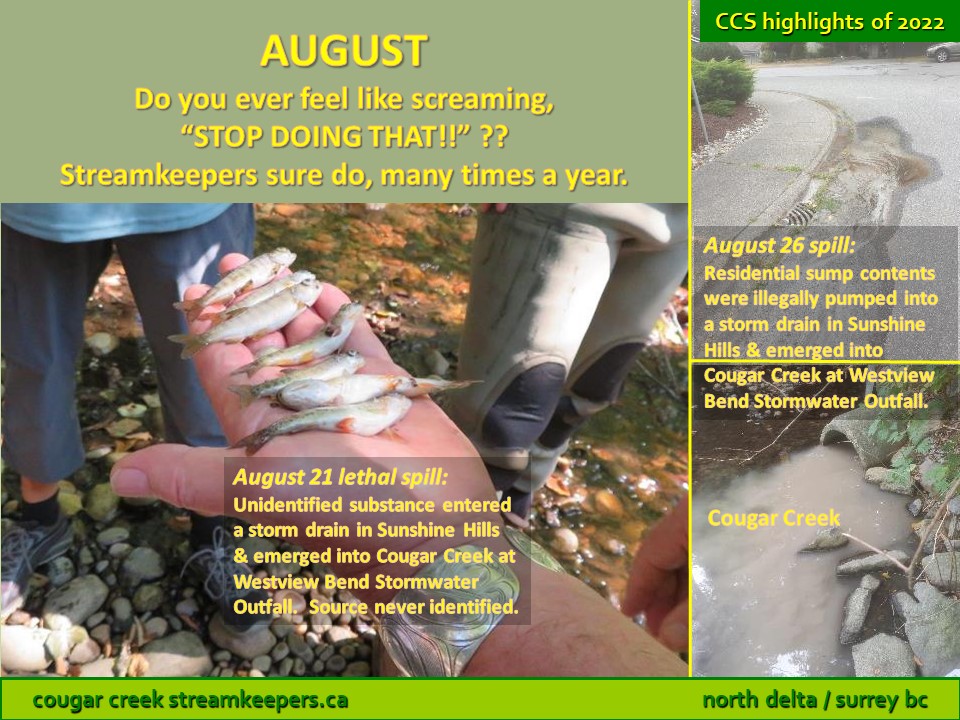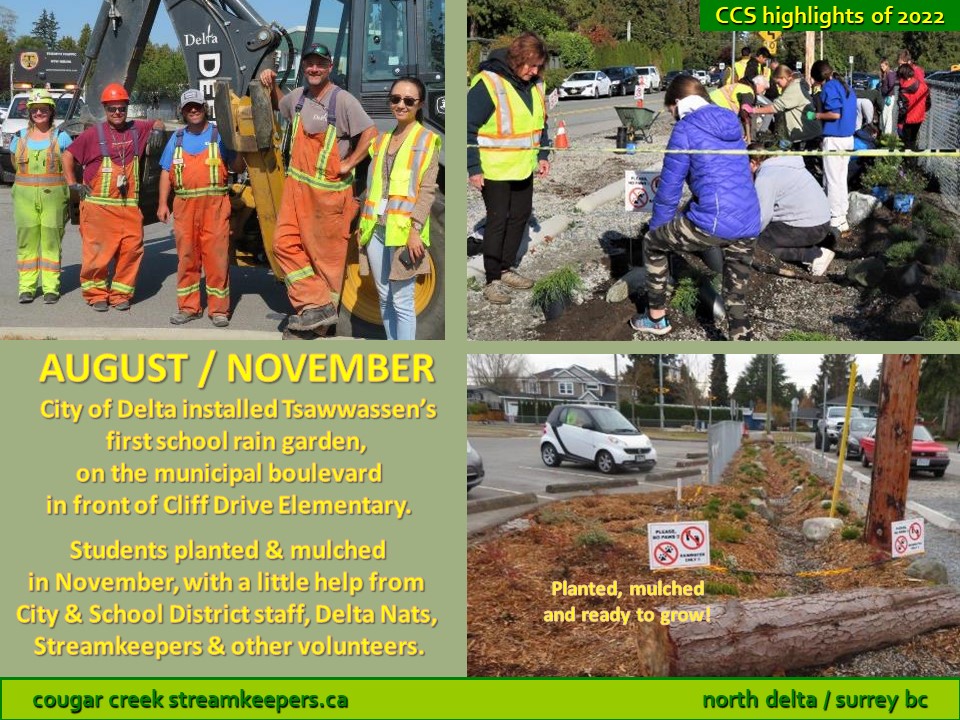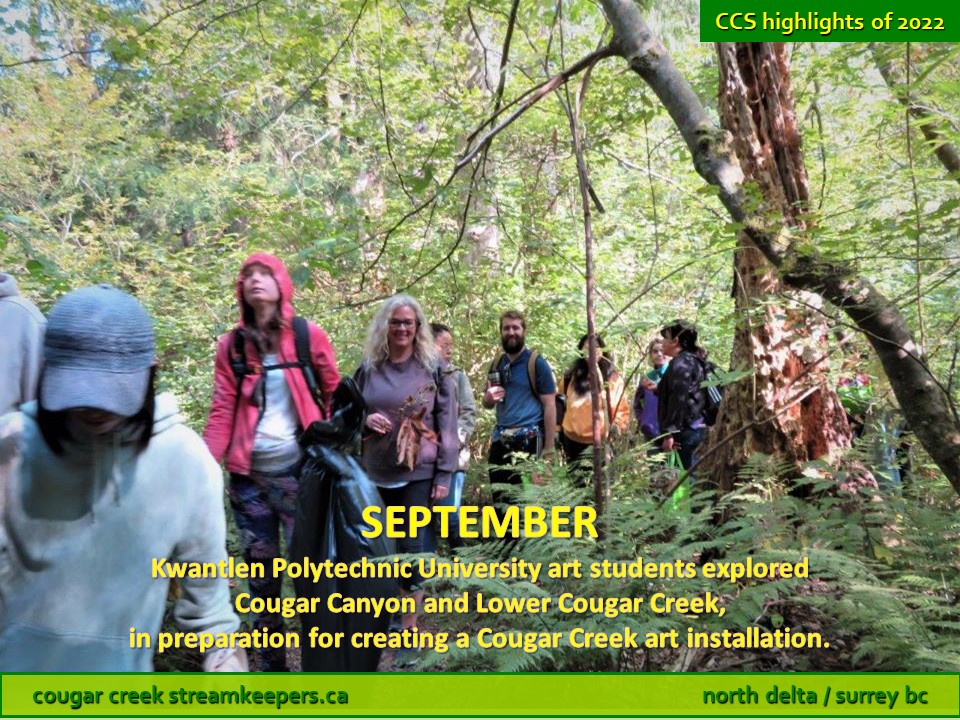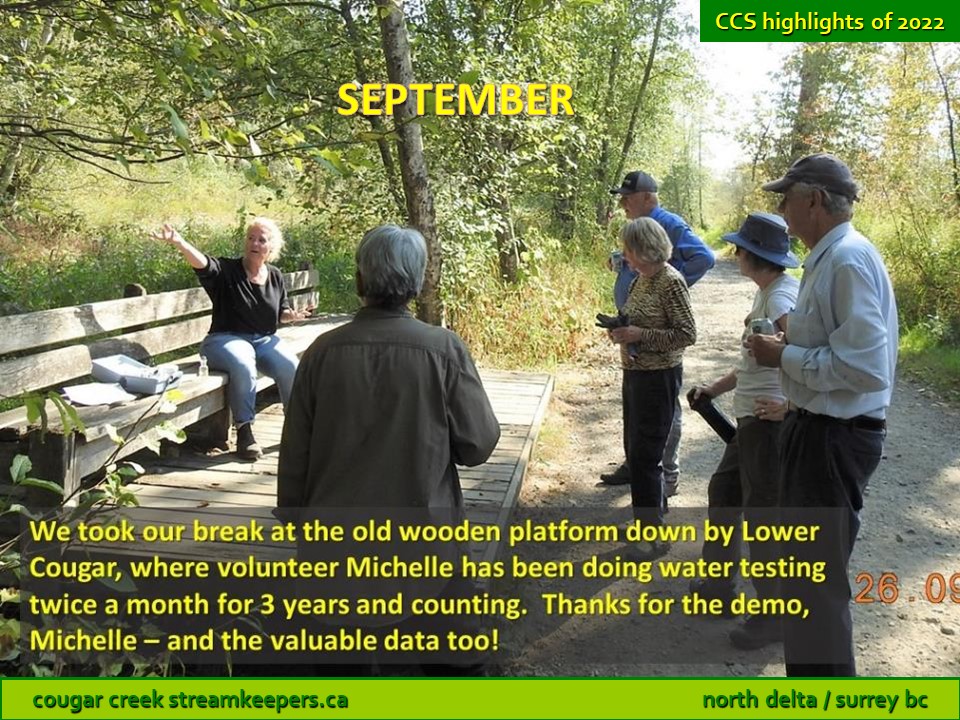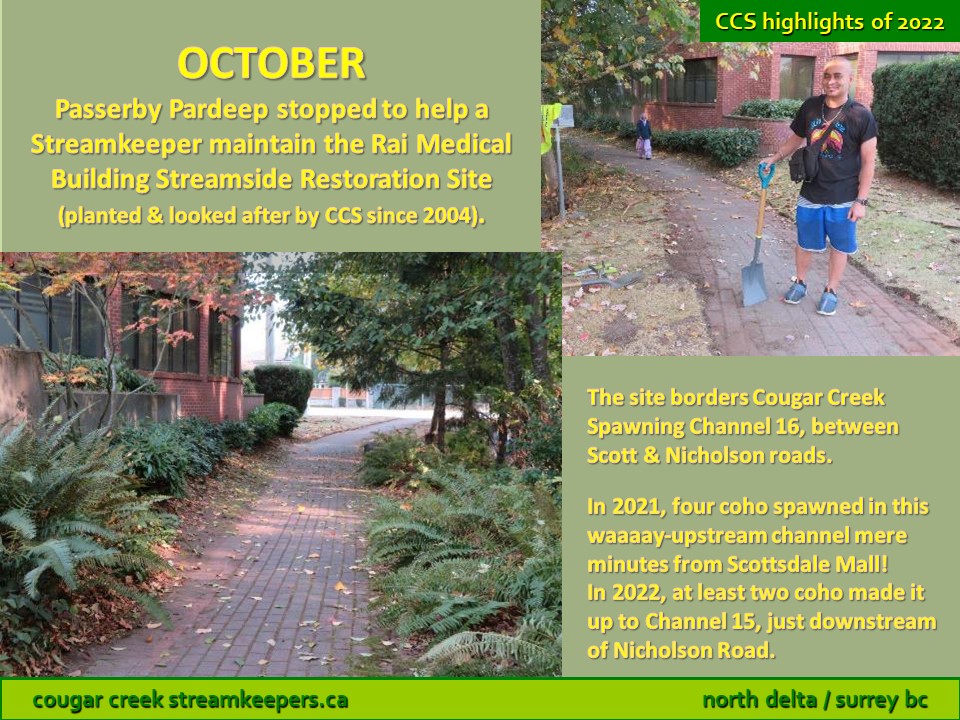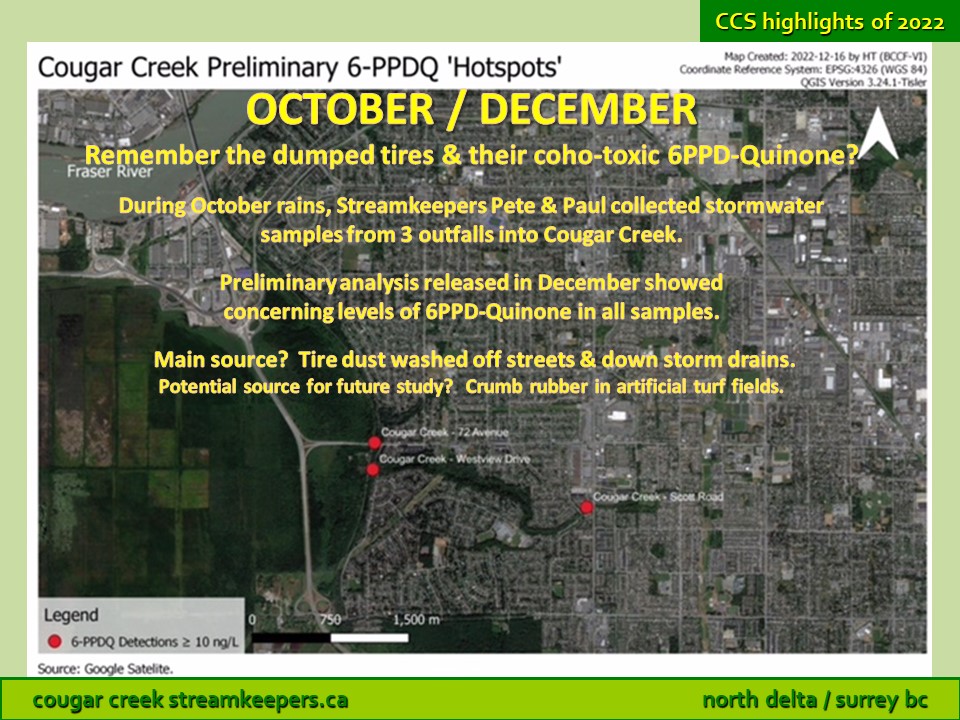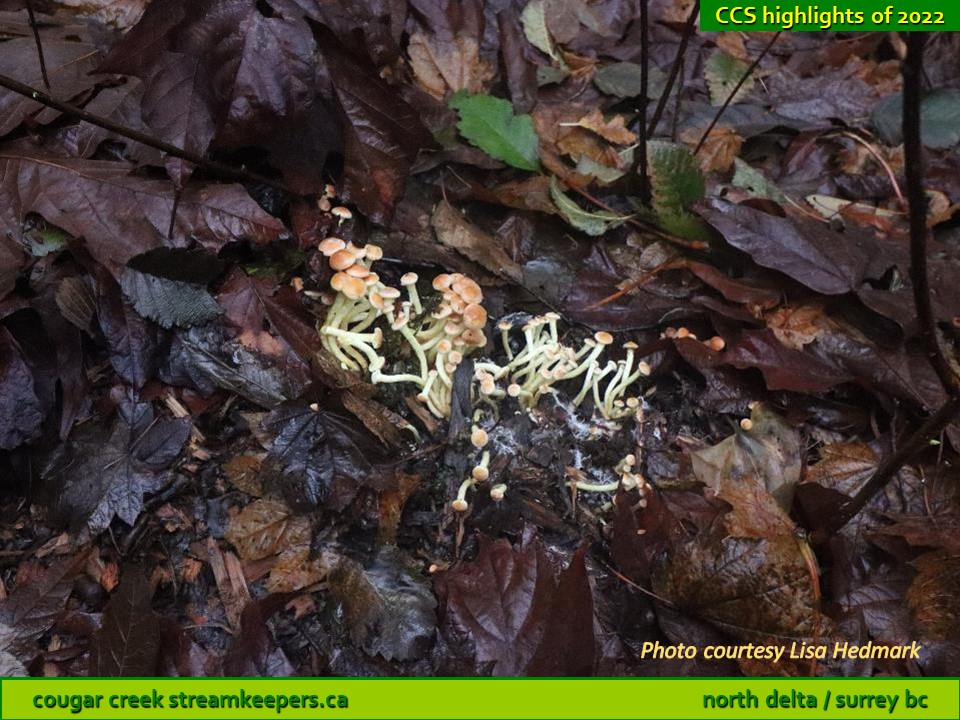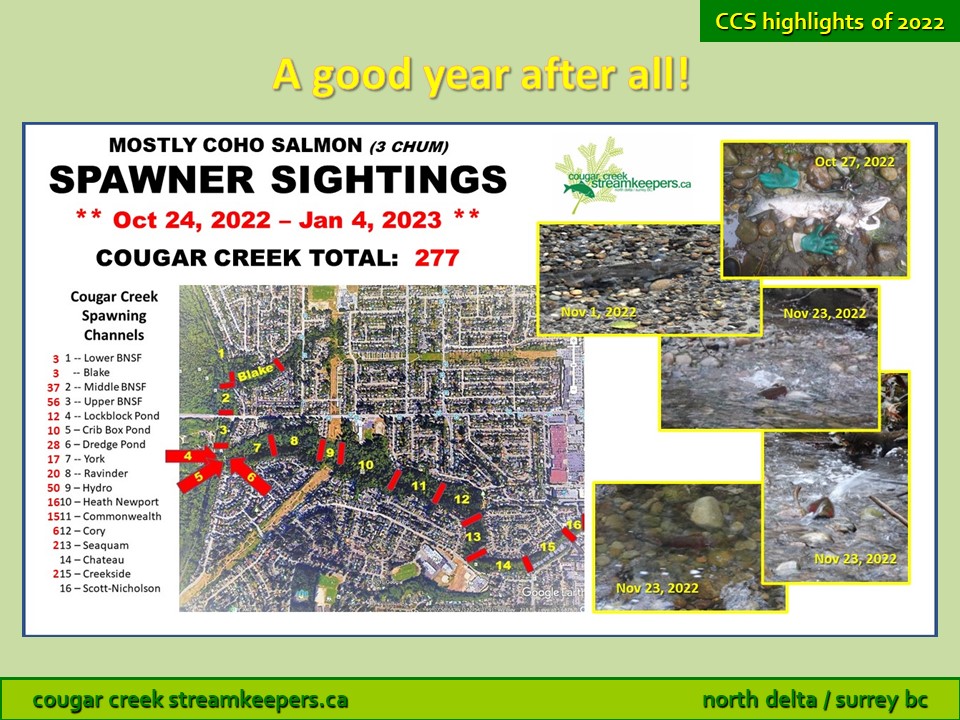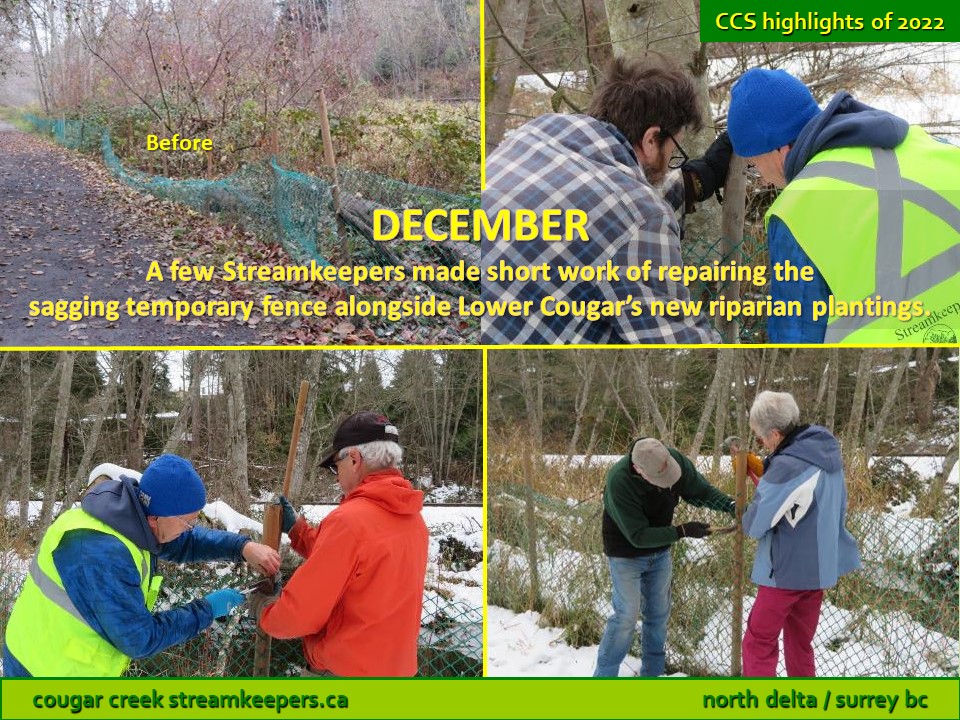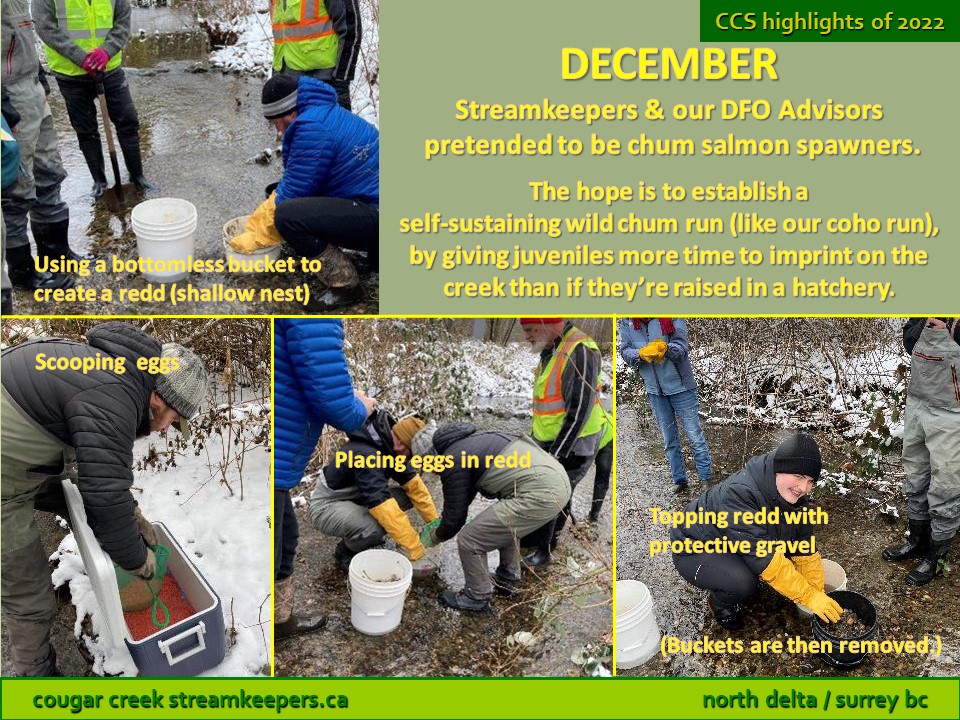Google Map
Alphabetical list of rain gardens
9240 – 112 Street, North Delta












A historic community
The community of Annieville, like much of North Delta, used to be covered by dense forest that soaked up rainwater like a sponge. Water not needed by the forest moved slowly through the soil, being cleaned and cooled, before reaching Annieville’s many streams such as McAdam, Collings, Norum, Honeymushroom, Kendale and Knudson.
With such a good water supply, salmon thrived in these streams, and in the Fraser River where the streams empty. Annieville’s First Nations and new settlers alike enjoyed the abundance of salmon in the area. In 1870, Annieville became the home of the very first salmon cannery in BC. During its first season, the cannery shipped over 30,000 pounds of salmon!
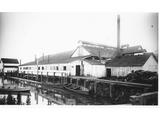
Since the 1960s, Annieville has grown rapidly. Most of the forest has been replaced by buildings and pavement – impervious surfaces that can’t absorb rainfall as the forest once did. Instead, rainfall runs off these surfaces, down storm drains and straight into salmon habitat. Warm polluted water has replaced the cool filtered water that once entered Annieville’s streams. Not surprisingly, salmon populations have plummeted. The salmon cannery is long gone.
One small step for salmon
In 2010 – 140 years after the opening of the old cannery – Annieville Elementary School became home to Delta’s third school rain garden (following Cougar Canyon in 2006 and Chalmers in 2009). Streamkeepers and Grade 4-7 students planted 300 shrubs and ground covers (purchased with funds from Delta, the Pacific Salmon Foundation, and Coast Capital Savings). The primary grades then mulched the entire garden with woodchips, which maximize water absorption and also protect against soil compaction, erosion and weeds. Almost immediately after planting, the garden began to do an excellent job of filtering and absorbing rainwater runoff from the school parking lot.
Functional limitations
Budget was not sufficient to allow for installing a new emergency overflow drain at the far end of the garden (as far away as possible from the water intake area). So instead, Delta crews installed a riser on a pre-existing drain located at the intake. The riser allows water to pool to a depth of about 5 centimeters; if it gets any deeper, it overflows down the emergency drain.
As the plants matured, the garden was able to absorb not only light to moderate runoff, but also quite heavy flows. Unfortunately, when Delta School District repaved the parking lot in 2014, the new pavement was sloped such that a large portion of runoff flowed away from the rain garden and into an old-fashioned storm drain! Ingrained habits are not easy to change!
The rain garden continues to do an excellent job nonetheless. As for the runoff that now needlessly goes down a storm drain, we’re hopeful that the School District will eventually cut openings in the parking lot curb, to divert that water into the adjacent wide grass boulevard. Simple as can be, no repaving necessary, boulevard trees will appreciate the additional water!
8718 Delwood Drive, North Delta








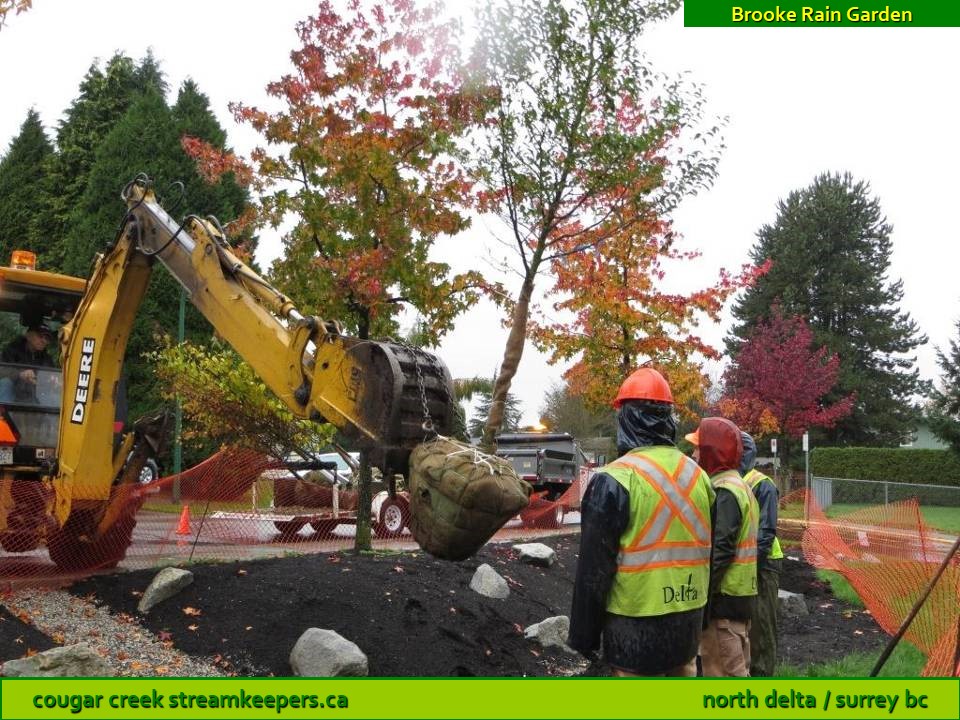







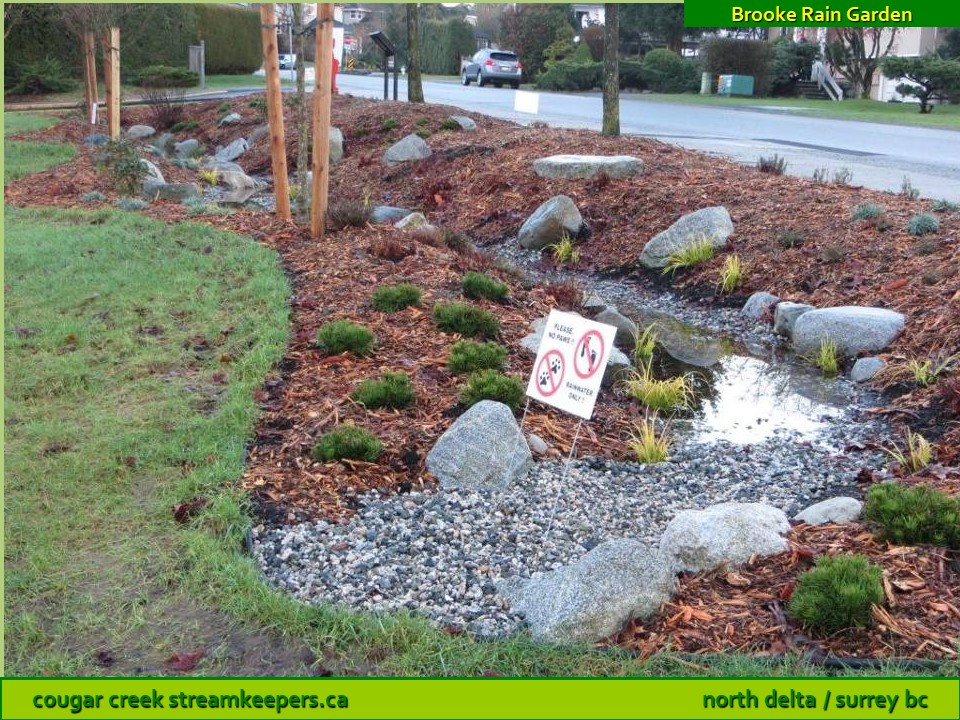

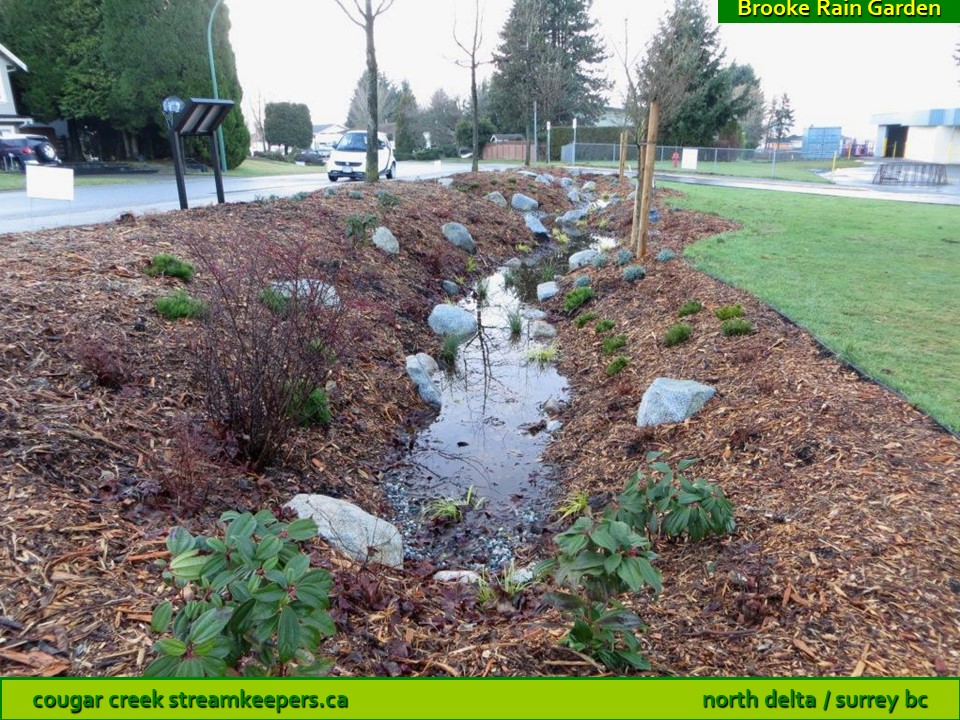
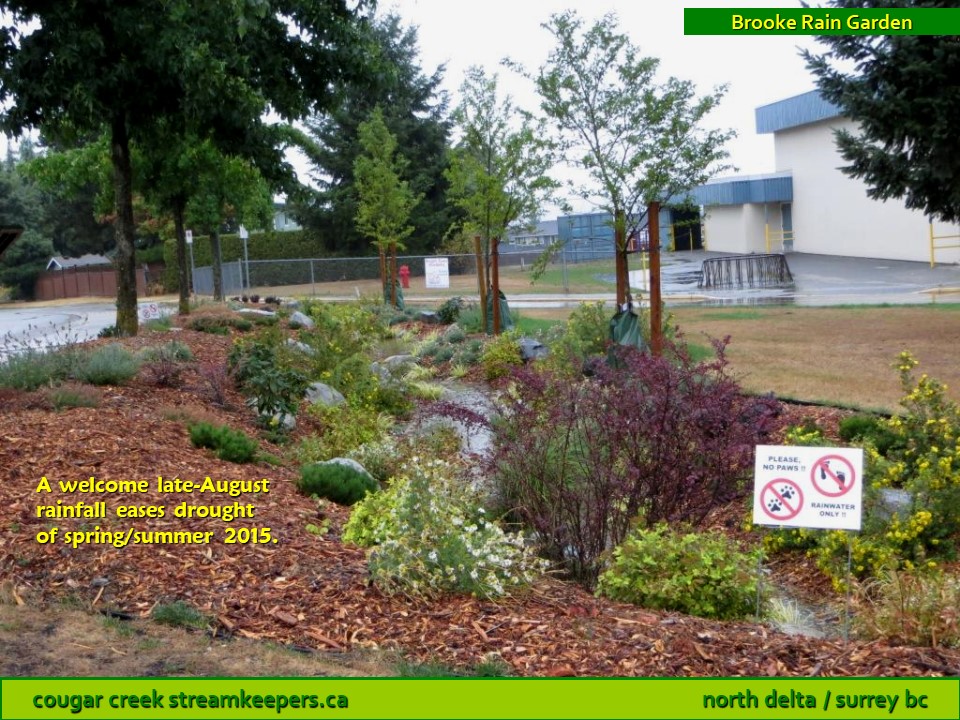
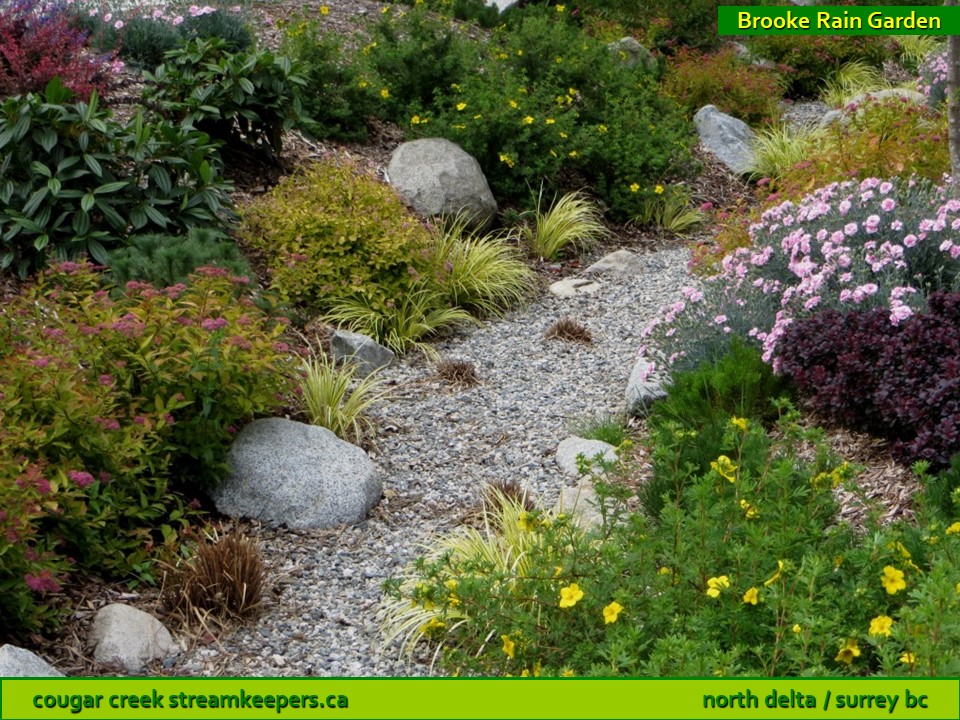

At the Delwood Drive entrance to Brooke Elementary School there’s a large sloping lawn, with 4 street trees and 2 mature evergreens on it. What a perfect space for soaking up rainwater runoff from a pavement! Not only is there lots of room, but also all those trees (especially the large evergreens) are very good at soaking up water.
But the lawn is uphill from the school parking lot. Water doesn’t flow uphill, it flows downhill! What to do?
That’s easy! Delwood Drive is higher than the lawn – so instead of receiving rainwater runoff from the school parking lot, this rain garden receives runoff from the street.
The main challenge was figuring out how to get the water across the sidewalk. An attractive trench drain and some skilled concrete work by Delta staff have done the trick.
Brooke Rain Garden receives about 210,000 litres of rainwater runoff per year from Delwood Drive. This water used to be wasted down a storm drain, through a pipe, into Sunbury Creek and out to the Fraser River and the ocean. Now, the water helps to grow a beautiful garden. The nice thick layer of woodchips that students spread on the garden holds moisture in the soil, so that plant roots still find water even during a long summer dry spell.
With such a large lawn acting as an additional “sponge” right next to the garden, there’s no need for an emergency overflow drain. Whenever there’s a heavy rainfall and the garden can’t soak up water fast enough, any excess water flows out onto the lawn and gets soaked up there.
7658 – 112 Street, North Delta









Blake Creek, a tributary of Cougar Creek
Like nearby Chalmers Elementary School, Burnsview Secondary lies in the watershed of Blake Creek, a tributary of Cougar Creek. Though Blake is culverted along much of its upper reaches, it opens out into a beautiful little ravine that has some excellent spawning habitat. From there, it flows into Lower Cougar Creek.

Environmental Science student project
Students of Mr. Benoit’s Environmental Science class approached Cougar Creek Streamkeepers to help them create a rain garden on their campus, as their Grade 11 project. Their proposed site was a muddy area adjacent to the school’s driveway and bike racks. Shortcutting across the site had seriously compacted the soils (and thus reduced their porosity) over many years.
Playing in the dirt
While a Delta School District crew tackled the main excavation with mechanized equipment, students picked up shovels to dig the small area around the flagpole. Including the flagpole within the rain garden has made lawn-mowing a little easier (fewer obstacles to mow around).
Steps through the garden
After much discussion, students and Streamkeepers alike agreed that it would be best to respect the traditional student shortcut diagonally up the slope to the sidewalk. Streamkeepers provided some ultra-heavy recycled plastic landscape ties, to serve as steps up through the garden. With much hammering and pounding, in went the steps and the rebar posts that hold them in place.
Total success: The steps are heavily used, and they help provide a sense of ownership as students are welcomed into the garden rather than being expected to simply look at it or go around it.
No more mud puddle, and it looks good too!
11315 – 75 Avenue, North Delta

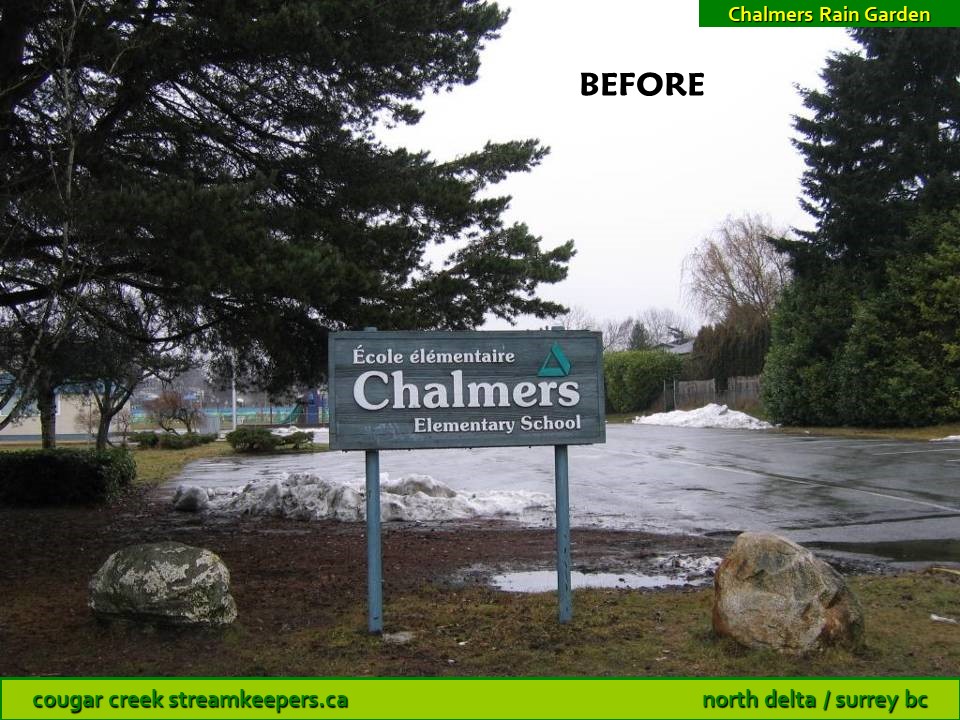
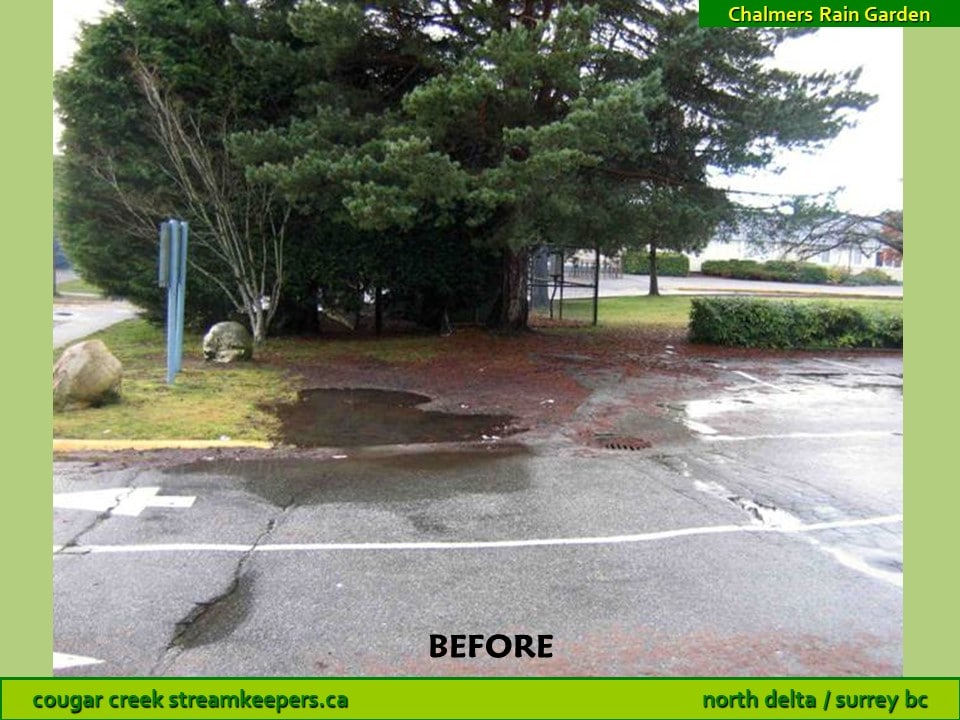

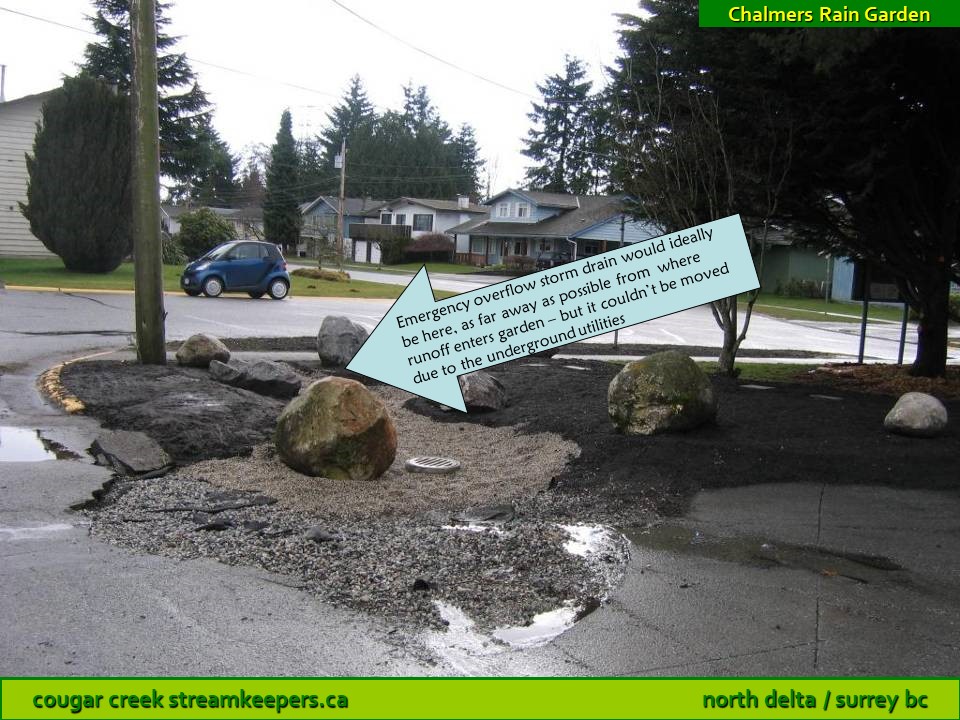
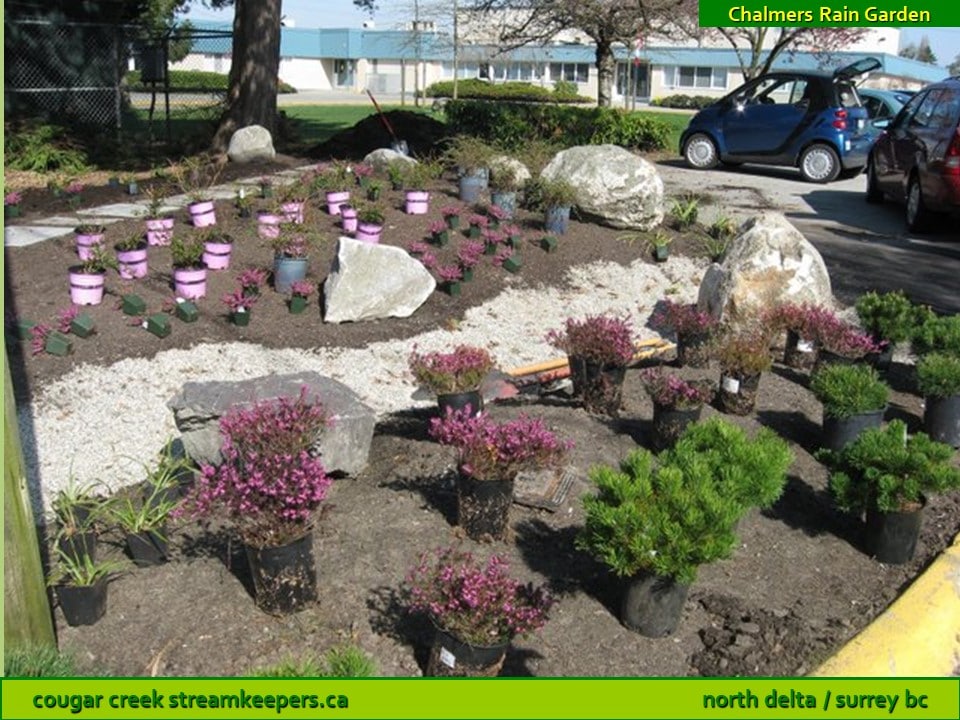

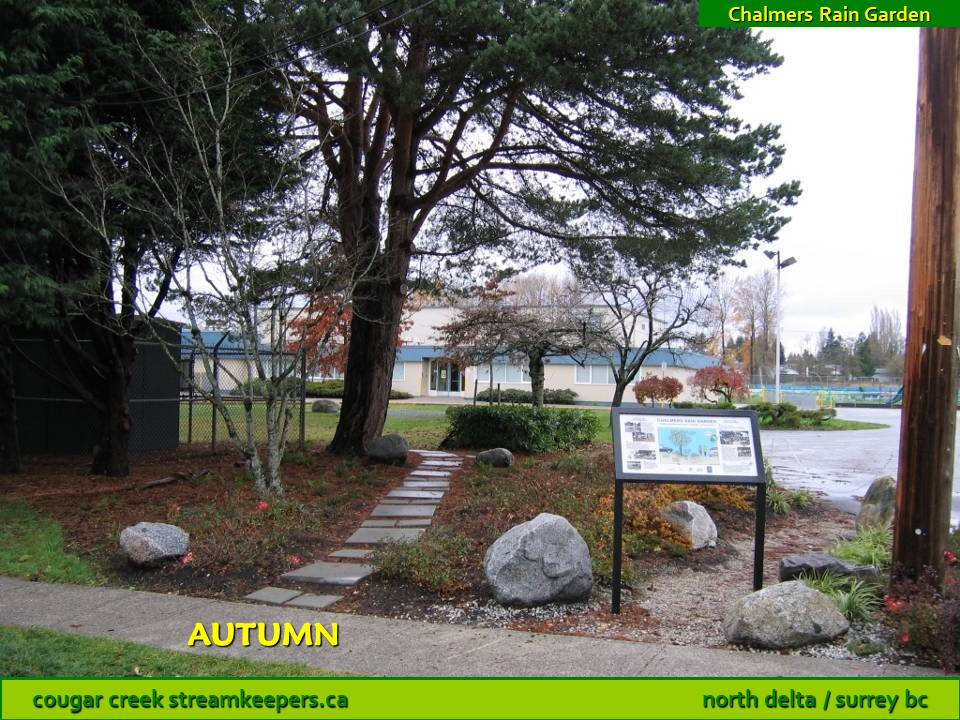
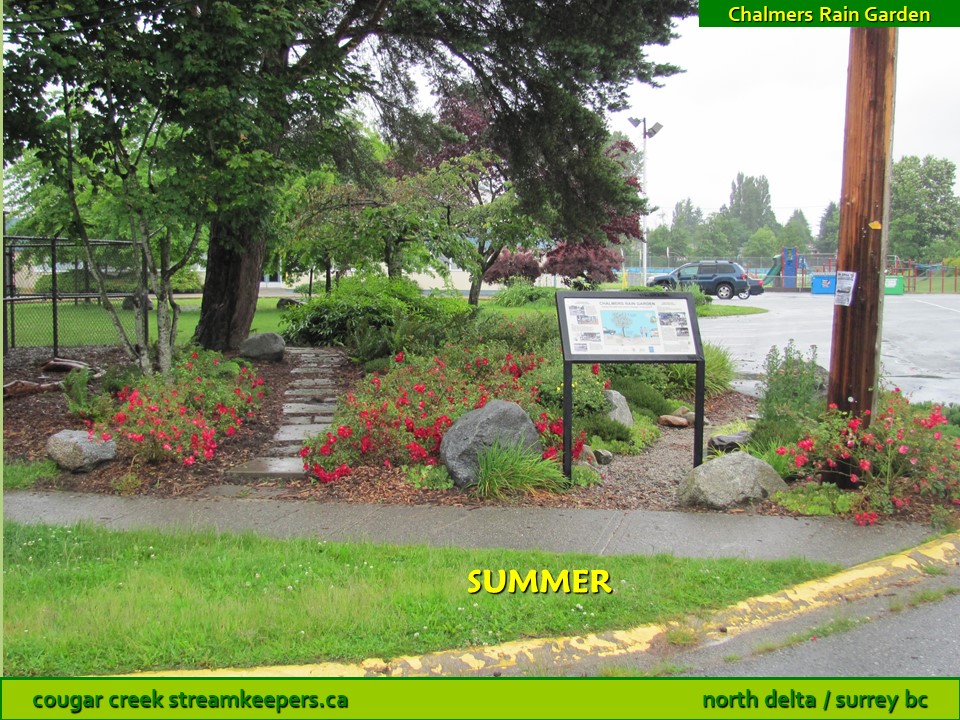

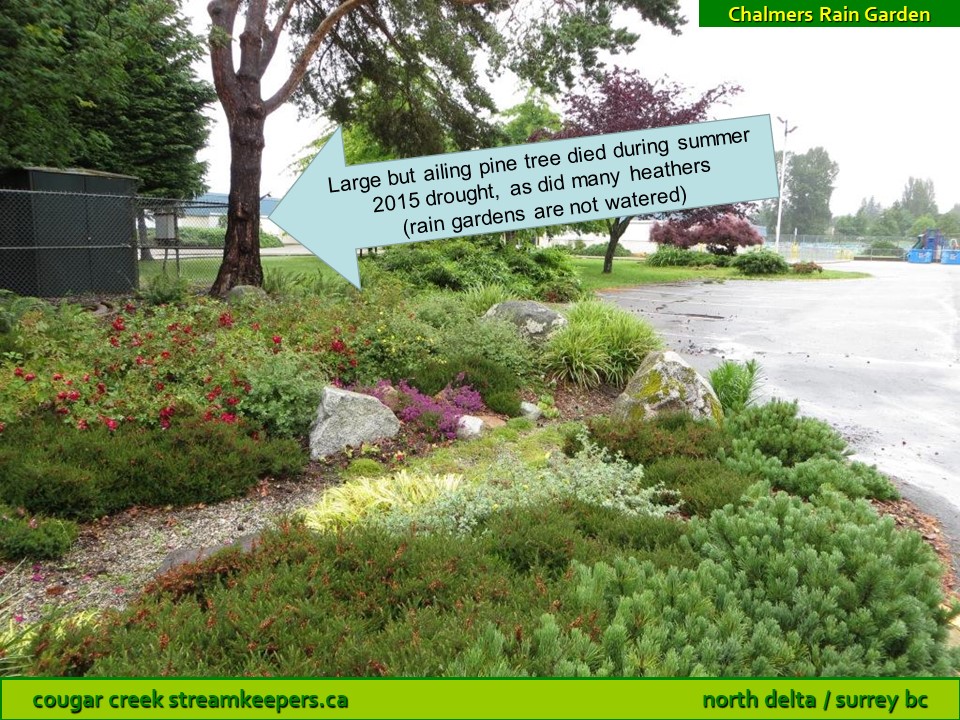



A drainage problem
In addition to being environmentally friendly, rain gardens are also an economical way of dealing with drainage problems. Case in point: the entrance to the parking lot at Chalmers Elementary School in North Delta.
Years of car and foot traffic had caused settling of pavement and compaction of bare ground, with the result that large puddles of rainwater and snowmelt regularly formed right beside the parking lot storm drain.
Despite the puddles, the storm drain nonetheless still managed to take in plenty of dirty runoff from the parking lot and pipe it directly into Blake Creek, a tributary of Cougar Creek.
In short, it was a situation of inadvertent “stormwater retention” that managed to cause significant inconvenience yet still didn’t protect the receiving creek from stormwater runoff.
A rain garden solution
Delta’s Engineering Department excavated a sunken garden to receive and absorb parking lot runoff. They re-positioned the storm drain – with a raised lip and surrounded by the rain garden – so that now it sends only excess water (if any) down the pipe to Blake Creek.
The garden design features a raised path of stepping stones, following the shortcut route established by generations of students as they walk to and from school.
The students themselves planted the mugo pines, heathers, sword ferns, sedges, potentillas, roses and hens-&-chicks which fill their rain garden. Neighbours too volunteered their services, helping out with the planting and occasionally with maintenance (weeding, light pruning and litter patrol).
Garden performance improves with age
Unlike engineered stormwater management structures, which deteriorate over time, rain garden performance improves as plants mature. Denser plant canopies trap more rainwater before it even reaches the ground, and much of that water evaporates back into the atmosphere. Expanding roots and their associated soil organisms constantly create new porosities in the soil, making it capable of soaking up more water.
Chalmers Rain Garden, our 2nd oldest school rain garden in North Delta (after Cougar Canyon 1), is quite a small one. Nonetheless, its performance has steadily improved as the plants have grown and thrived with minimal care from Streamkeepers and students.
7658 – 112 Street, North Delta

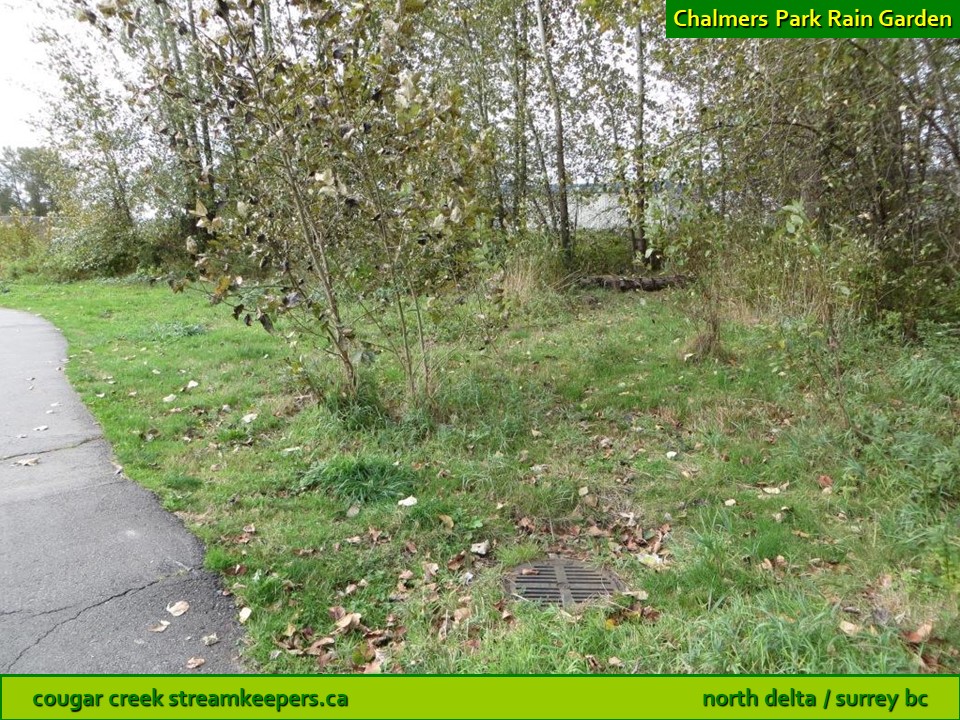
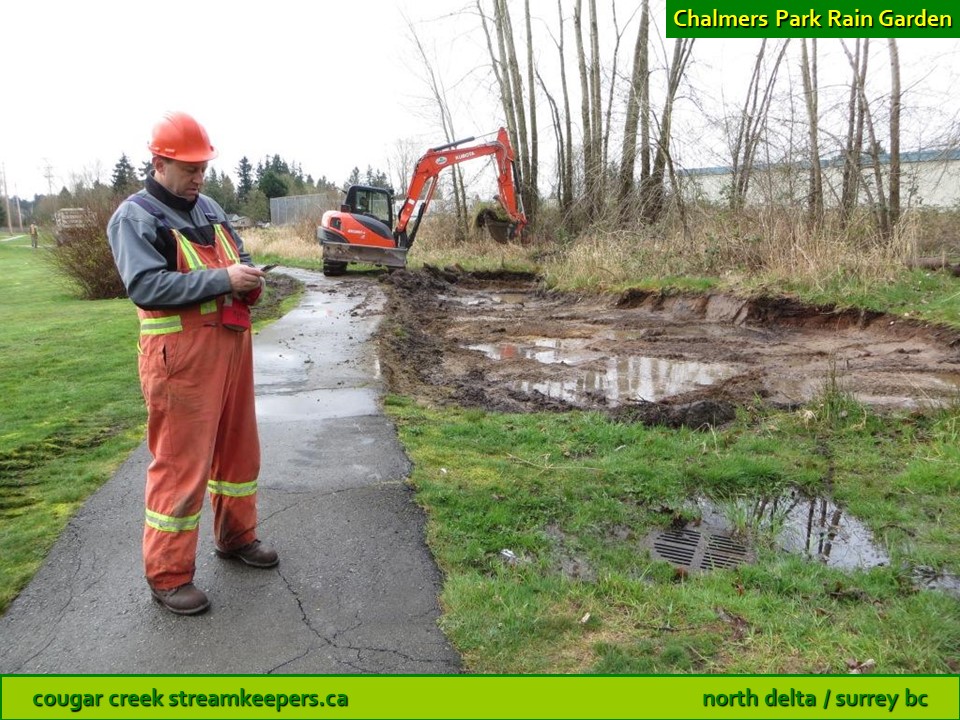
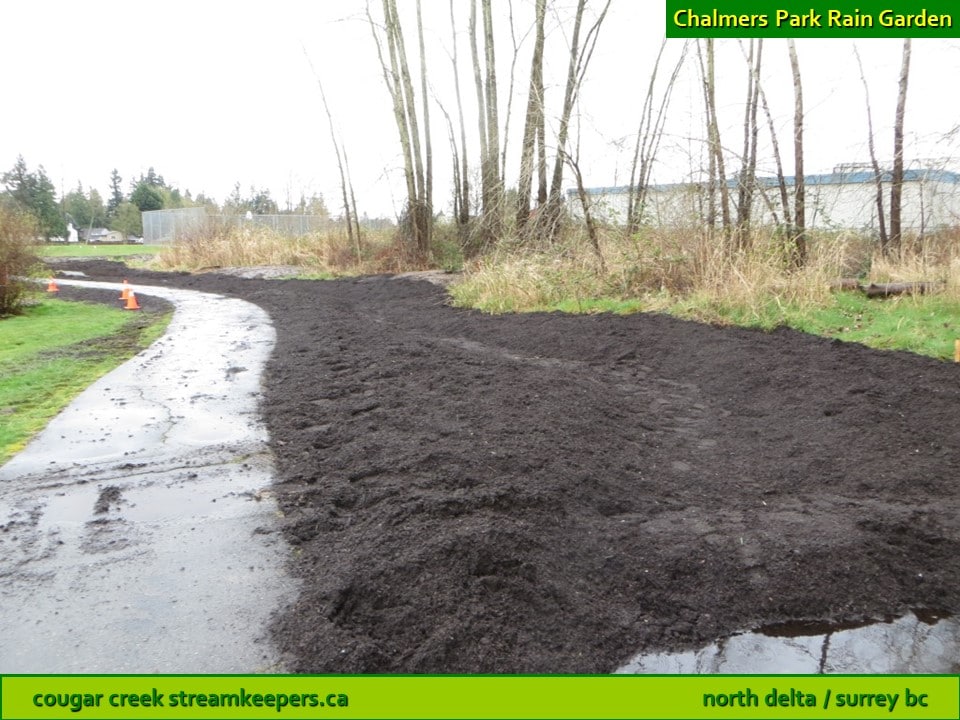

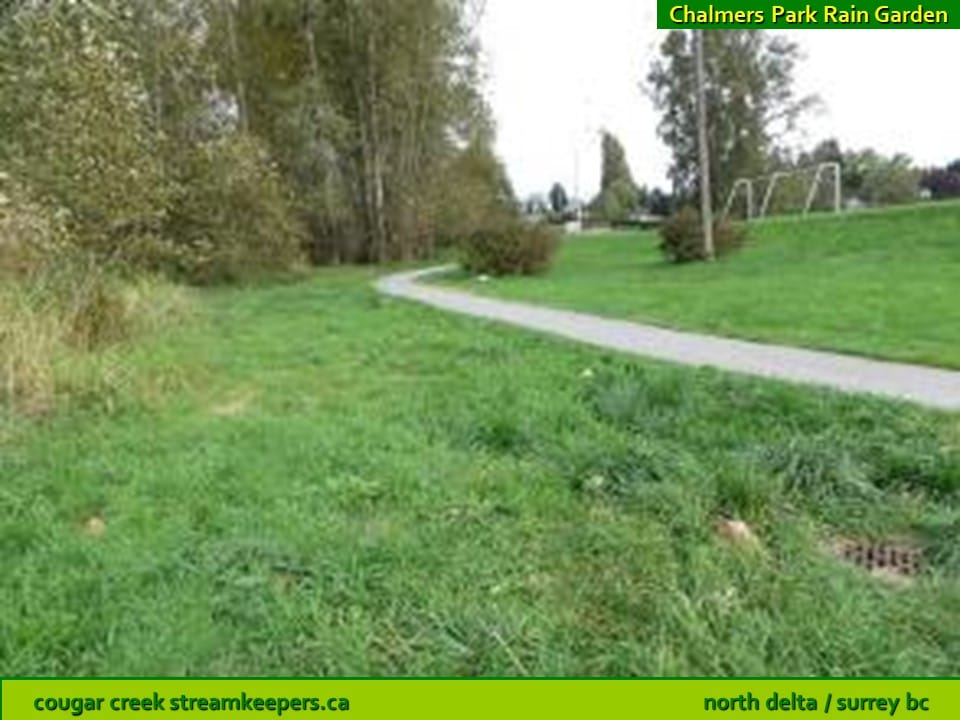
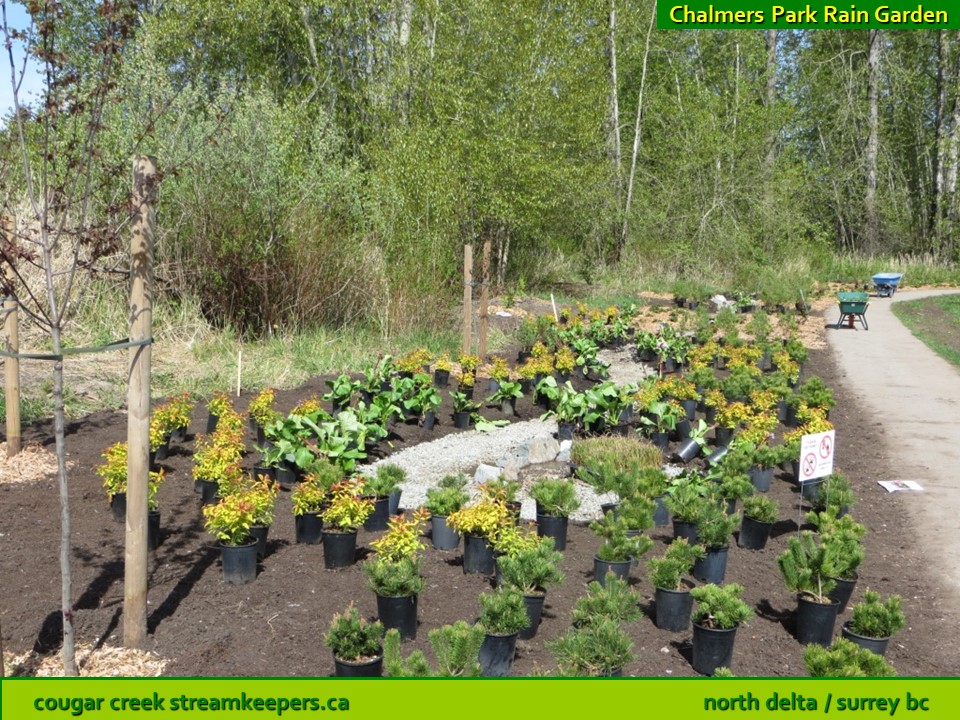

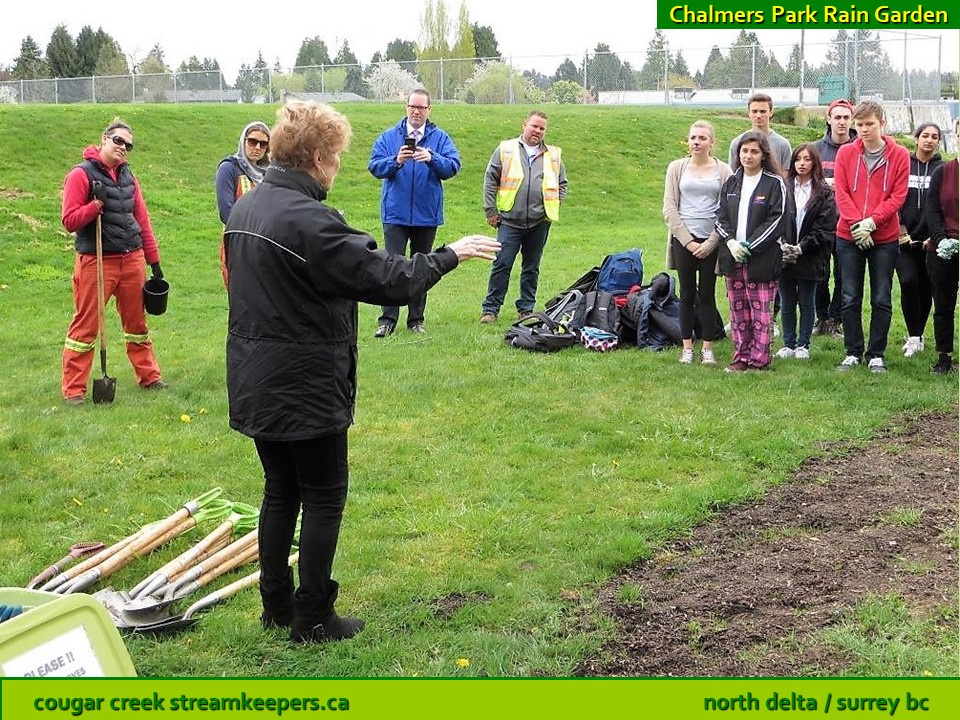
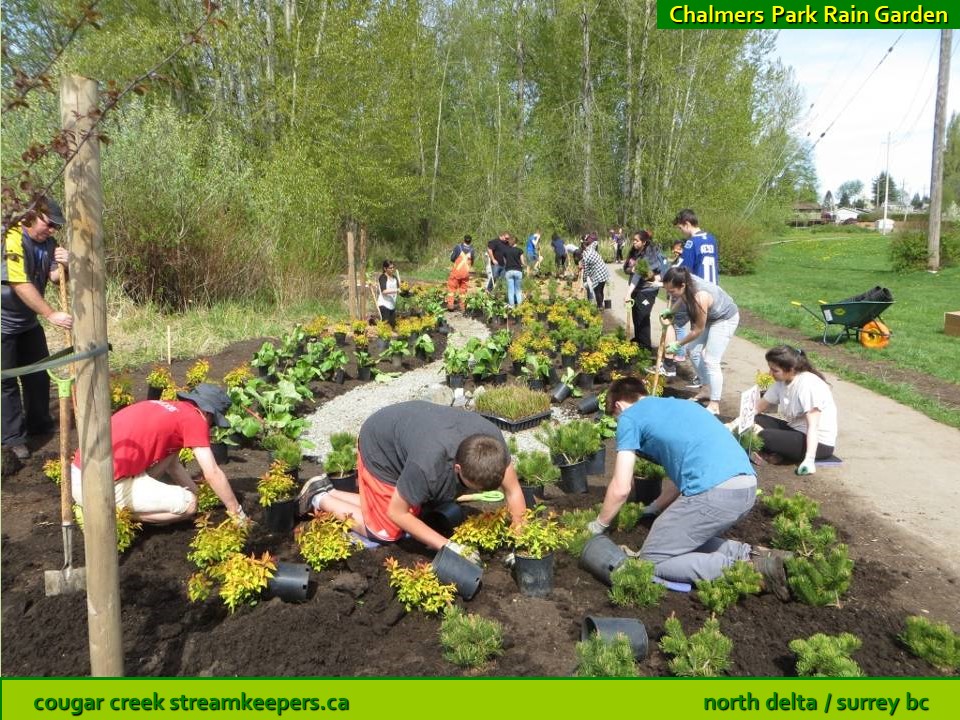

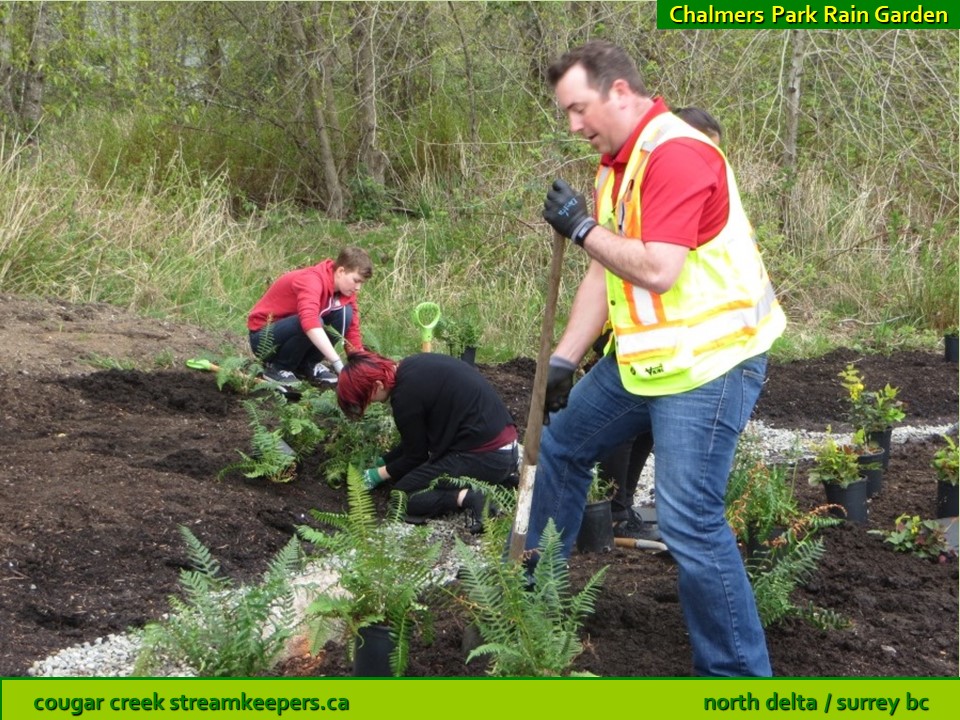
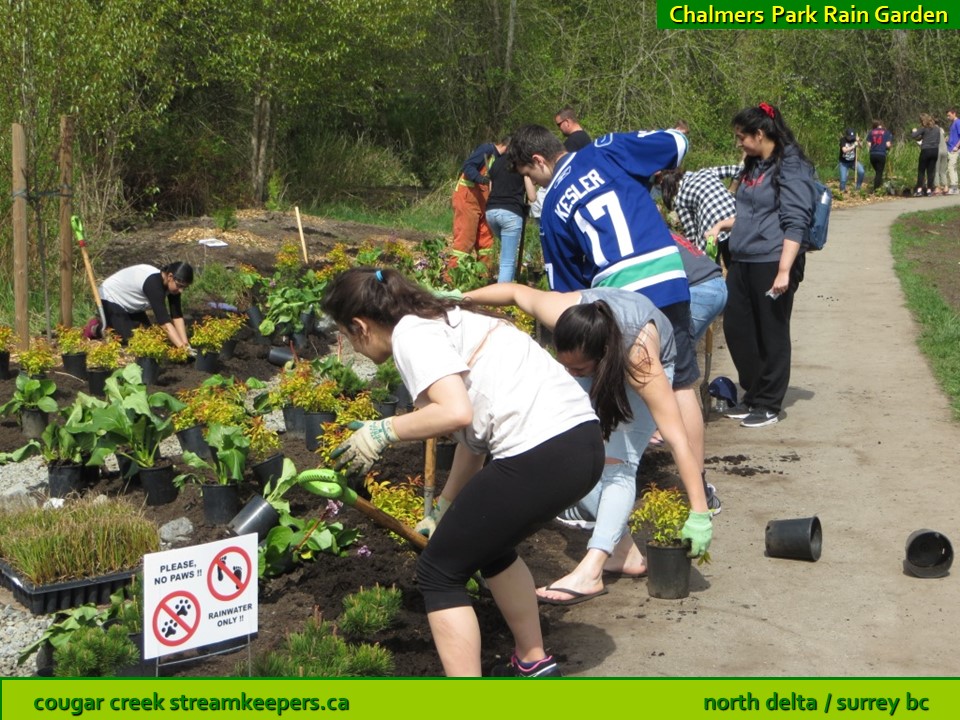

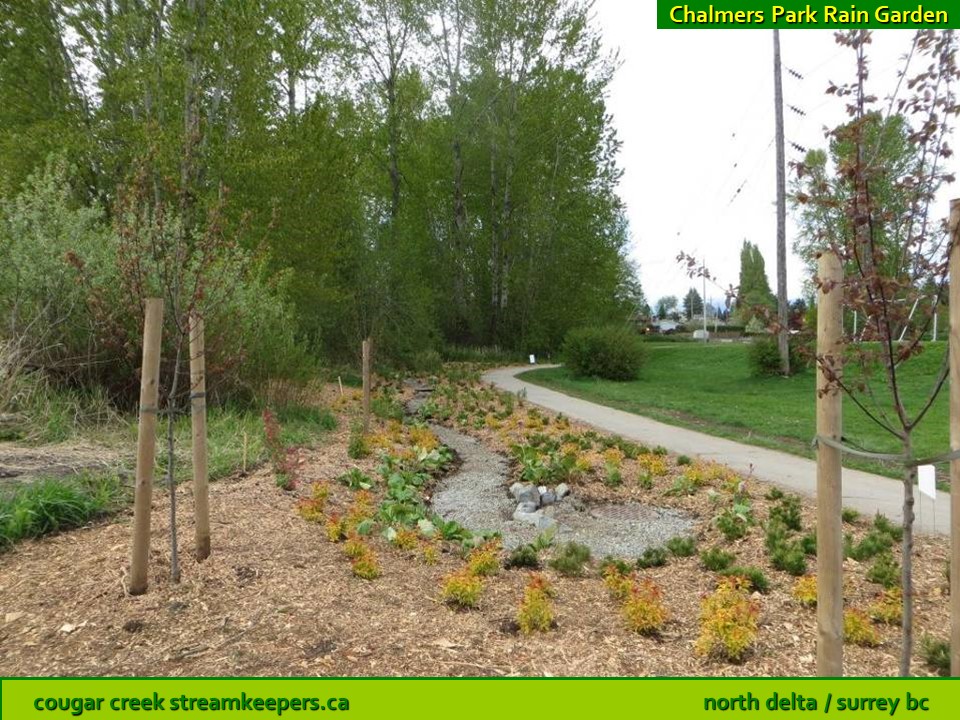
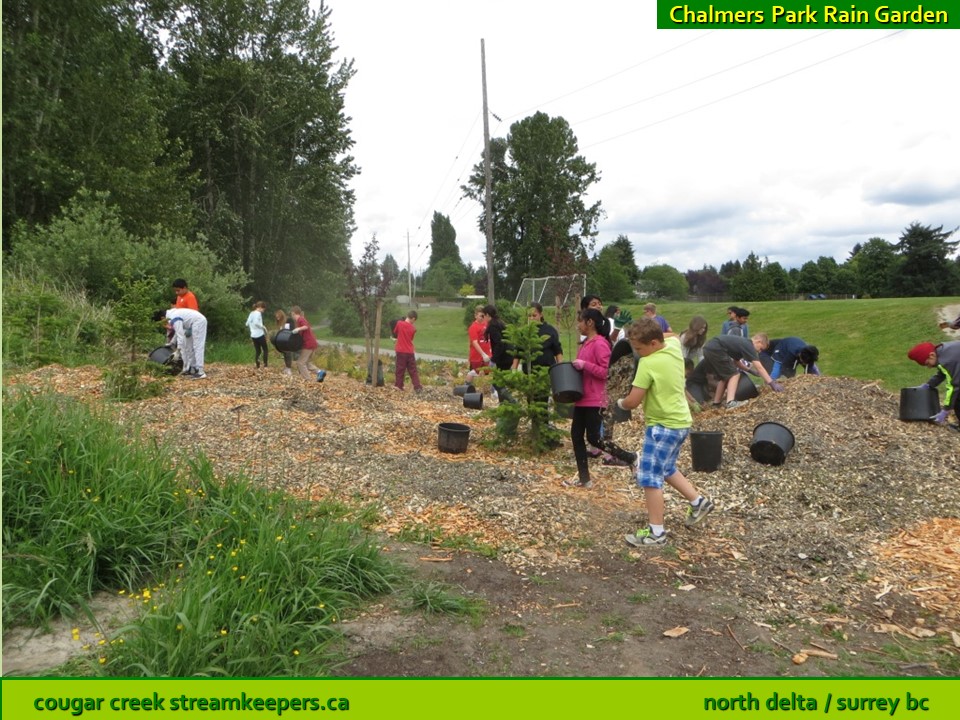





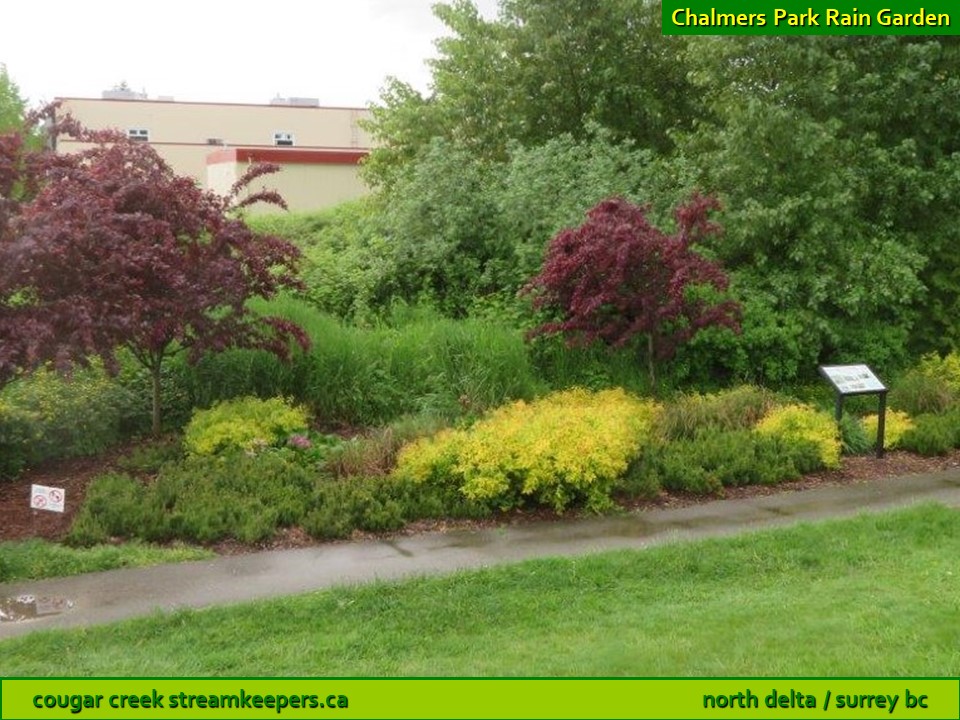
Rainwater infiltration for drought-resistant creeks and forests
At first glance, the heart of Chalmers Park seemed an unlikely location for a rain garden. There was no pavement to send polluted rainwater runoff down a pipe and into the nearest stream (Blake Creek, tributary of Lower Cougar Creek). But on closer inspection, Streamkeepers and Burnsview Secondary students from Mr. Benoit’s Environmental Studies class found 2 storm drains in the grass, that were serving to pipe away naturally-occurring “nuisance” seepage.
Water is not a nuisance, it’s a resource! Whenever possible and safe (not near a steep slope, for example), it should be infiltrated into the ground. Every additional drop in the ground means better summer flow in our creeks, and better-hydrated trees and forests that are less likely to burn during our increasingly hotter, longer, drier summers.
With financial assistance from North Delta Rotary and Nature Trust of BC, plus engineering and earthwork donated by the City of Delta, Burnsview students and Streamkeepers created a linear rain garden that has brought additional beauty and biodiversity to the park. The uphill of the 2 storm drains was closed off, and the downhill one (at the lowest end of the garden) now serves as emergency overflow only. Though it’s impossible to measure the amount of natural seepage now flowing into the rain garden, clearly a significant volume of winter rainwater is being “banked” in nature’s free reservoir, the ground. Seepage from this groundwater “savings account” helps streams and forests survive dry spells.
11664 Lyon Road, North Delta
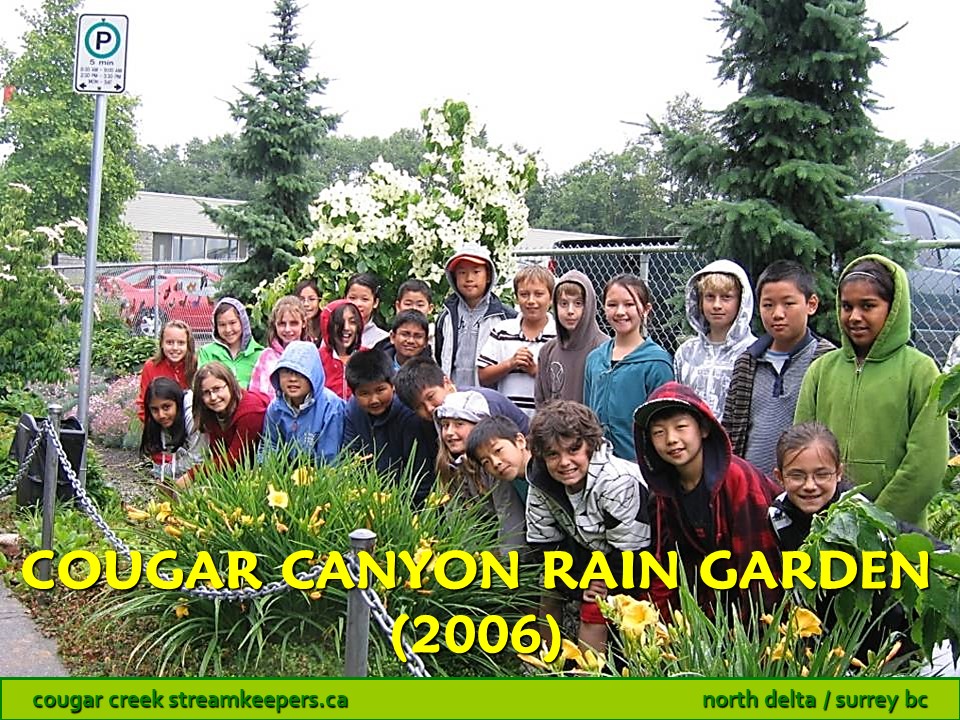

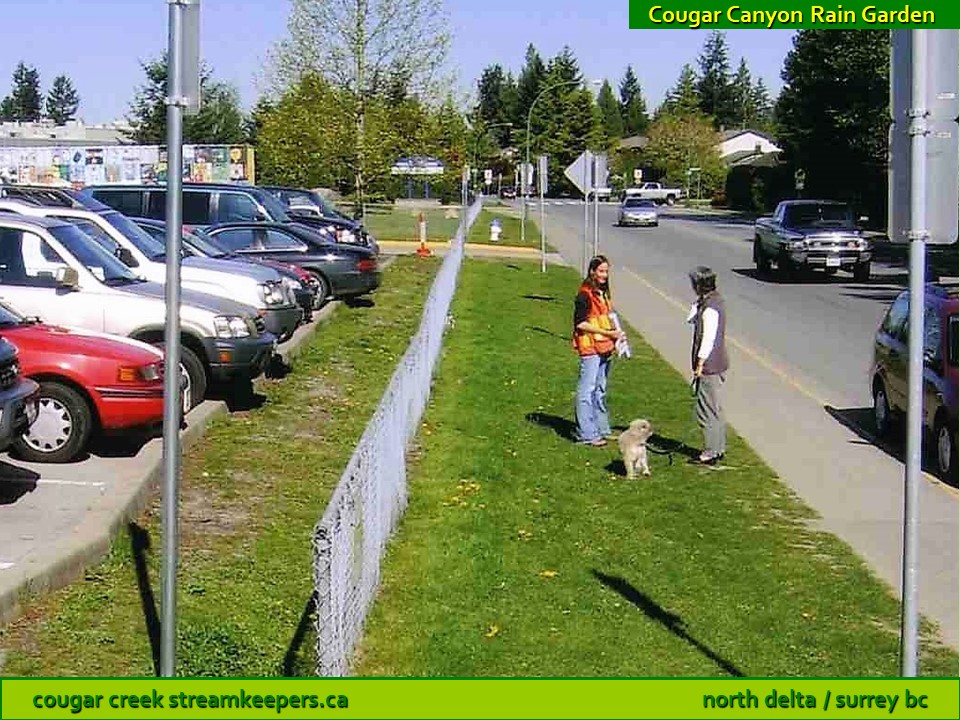

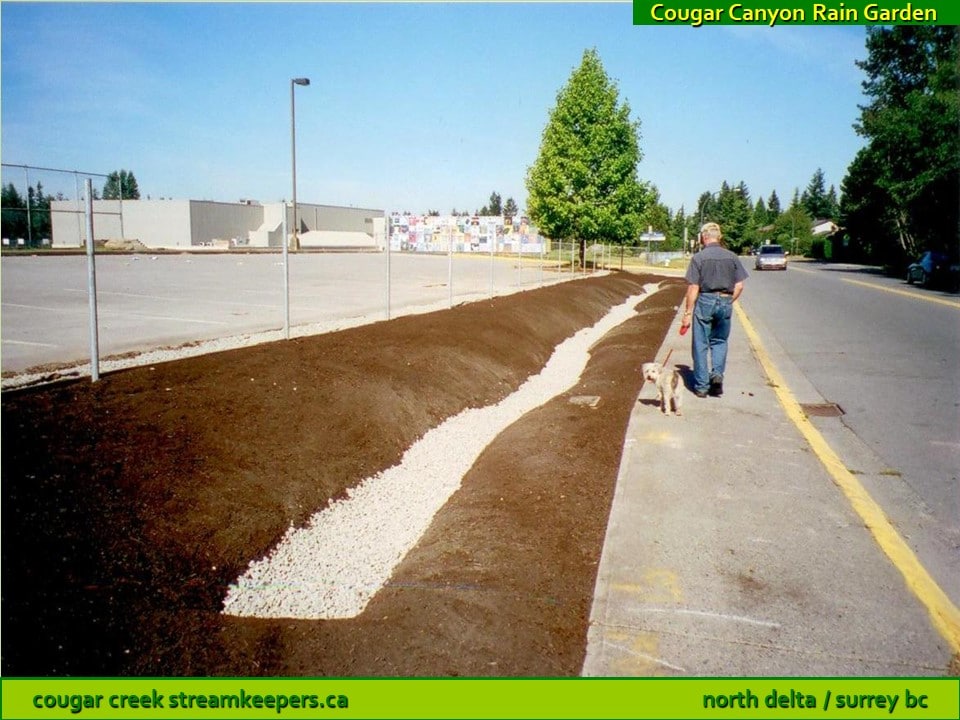
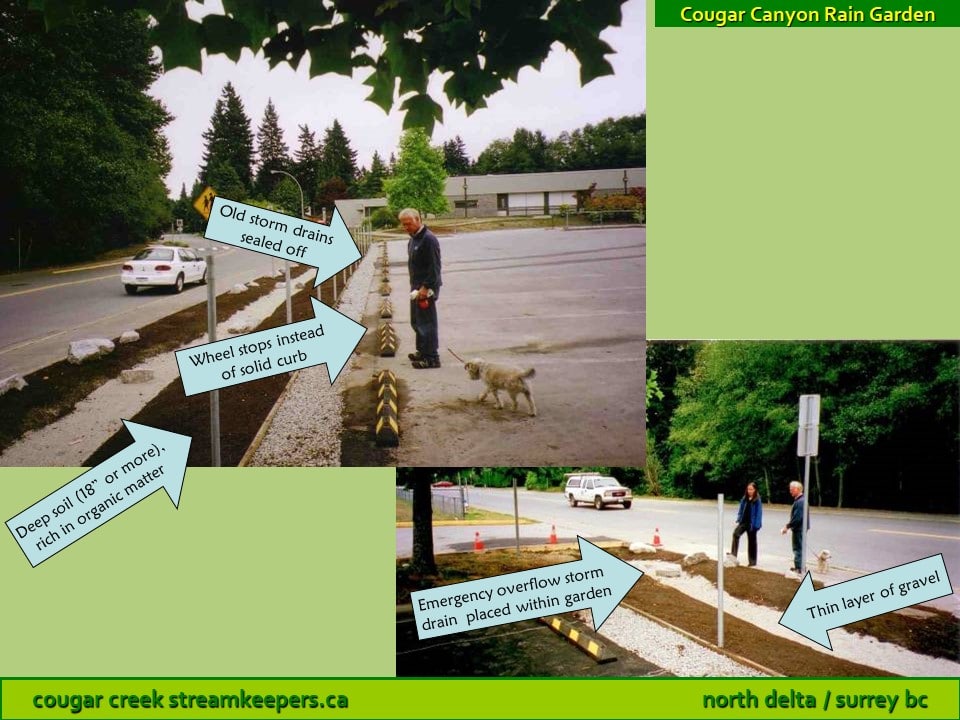



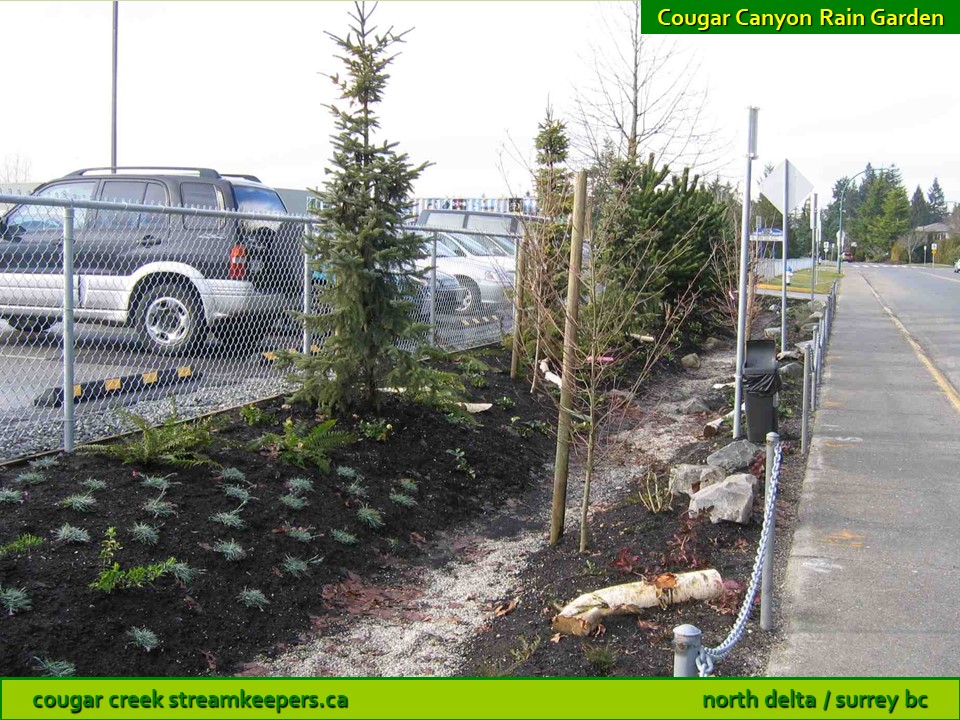

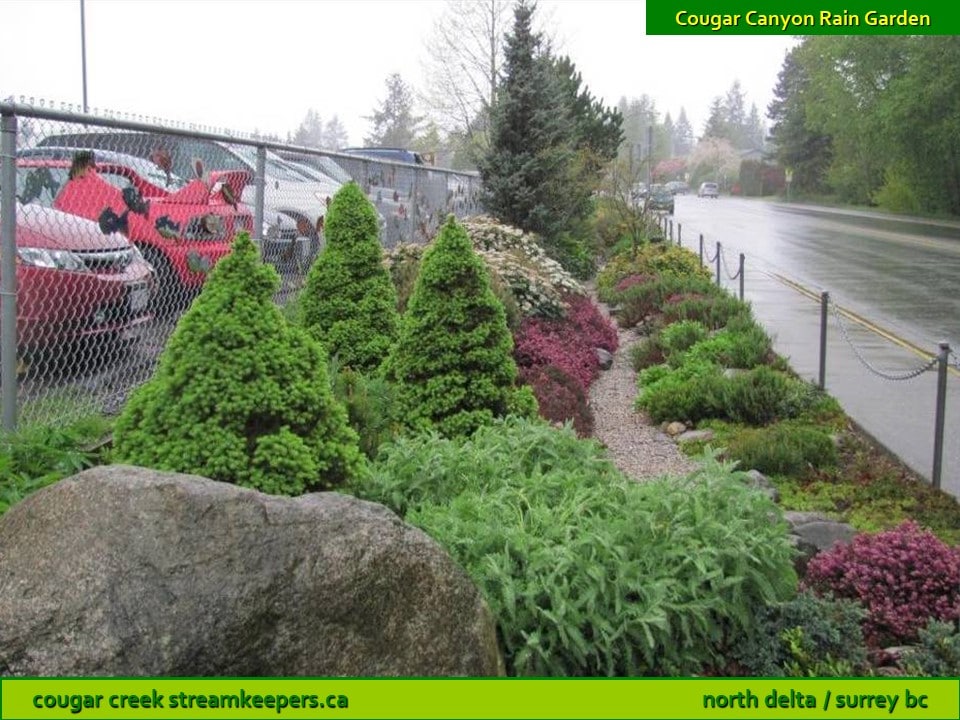
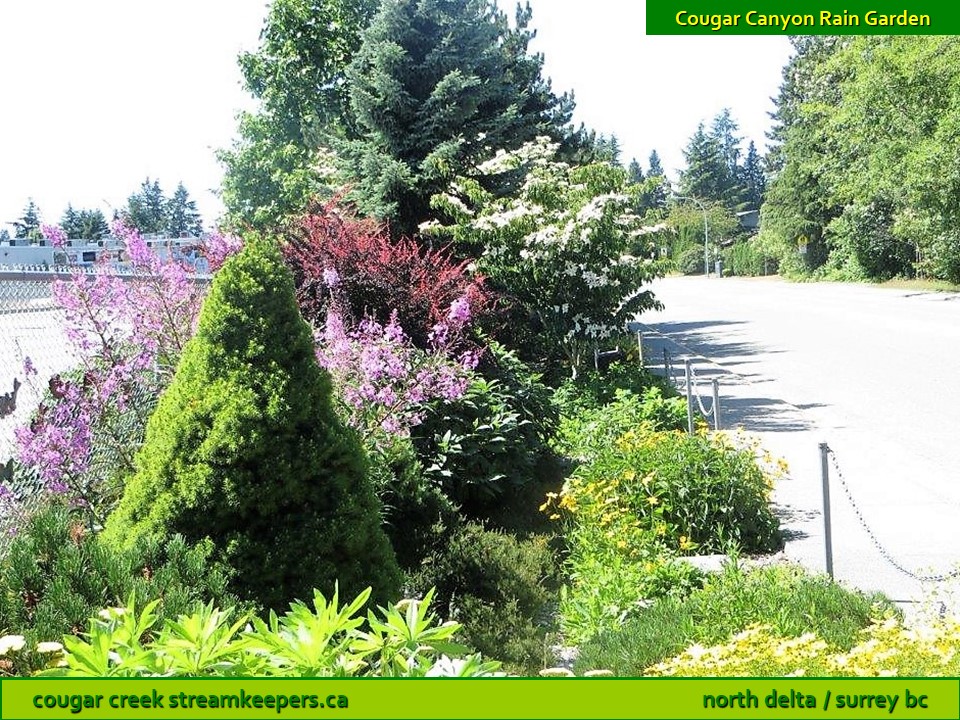
North Delta’s first school rain garden project
In 2006, Cougar Creek Streamkeepers, in cooperation with the Corporation of Delta, the Delta School District, and Stream of Dreams, applied for and received a $12,300 grant from the Pacific Salmon Foundation to install a demonstration rain garden at Cougar Canyon Elementary School, 11664 Lyon Road, North Delta, just across the street from the creek. The purpose of the rain garden is to absorb rainwater runoff and snowmelt from the school parking lot, and perhaps eventually from the street as well.
In late summer of 2006, Delta Engineering decommissioned two storm drains in the parking lot, replaced the solid curb with wheel stops, and excavated a sunken garden along the full length of the lot. They then installed highly absorbent soils, decorative boulders and a thin layer of gravel (imitation streambed), and planted a dozen trees.
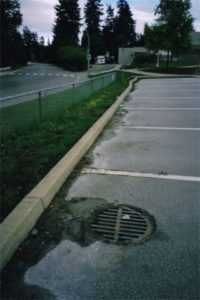


The remaining 600 rain garden shrubs and ground covers were planted by students themselves (Seaquam Secondary’s Volunteer Club, plus every one of Cougar Canyon’s nearly 500 K-7 students), under the supervision of the Streamkeepers. Lawrence, a well-known and popular canine streamkeeper, served as Project Manager!


Stream of Dreams
In conjunction with the rain garden planting, Joan Carne of Stream of Dreams presented her highly informative and entertaining program on watershed health and stormwater management, to every class at Cougar Canyon Elementary. Thanks to Joan’s efforts, students were well-informed, enthusiastic and also respectful of their new rain garden. To this day, neighbours comment on the remarkable absence of litter from the garden, compared to other areas (playing field, playground, etc).

Off to a good start
Shortly after the garden was installed, heavy rains and winds arrived, followed by heavy snow. The rain garden performed perfectly, absorbing virtually all of the rainwater and snowmelt. Grit, salt and other pollutants from the parking lot were filtered out by the garden, whereas before they would have gone down the drain and been piped directly into Cougar Creek.
Since its creation in fall 2006 …
Cougar Canyon Elementary School Rain Garden has become a well-known and popular neighbourhood feature. Grade 4-5 maintenance teams are enthusiastic about weeding, trimming, and just hangin’ out in the garden chatting and looking at bugs and worms. Passersby often stop to admire the garden and compliment the kids on their success.

11664 Lyon Road, North Delta



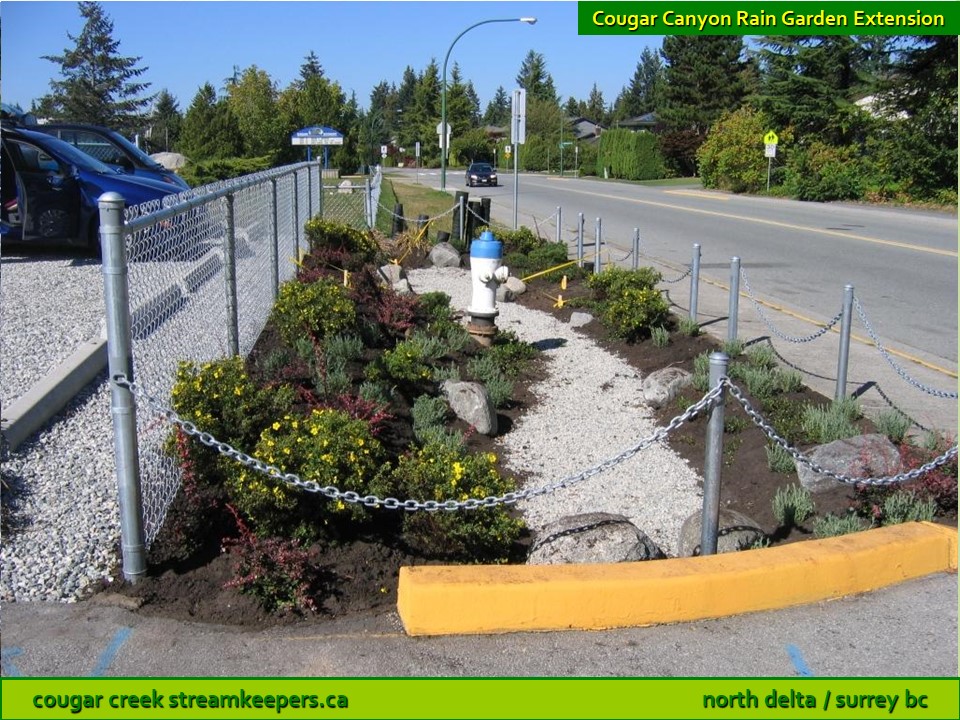
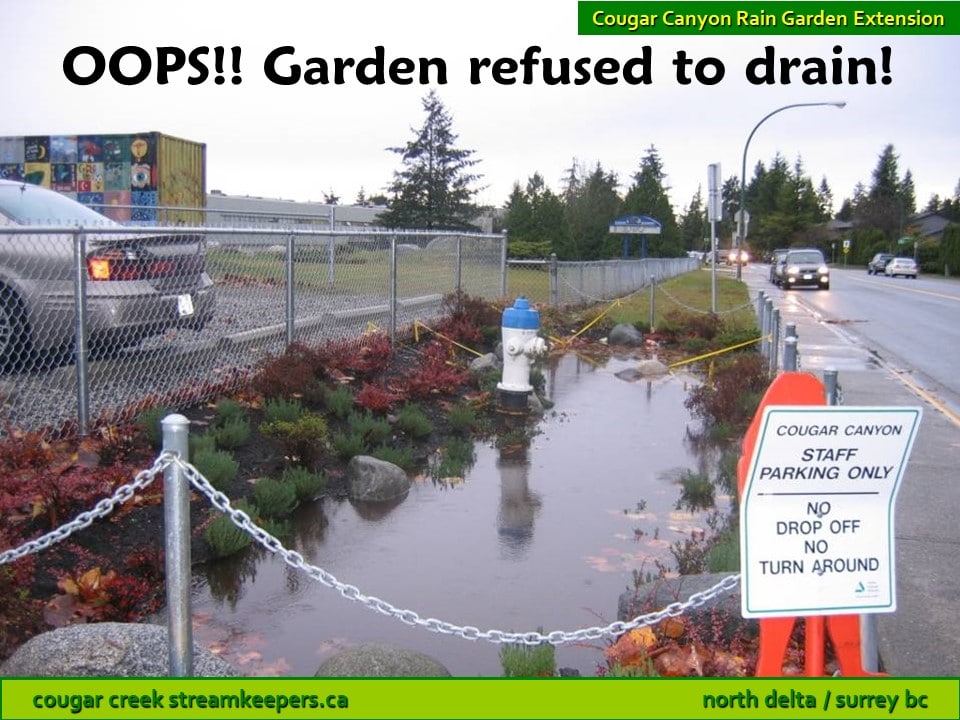
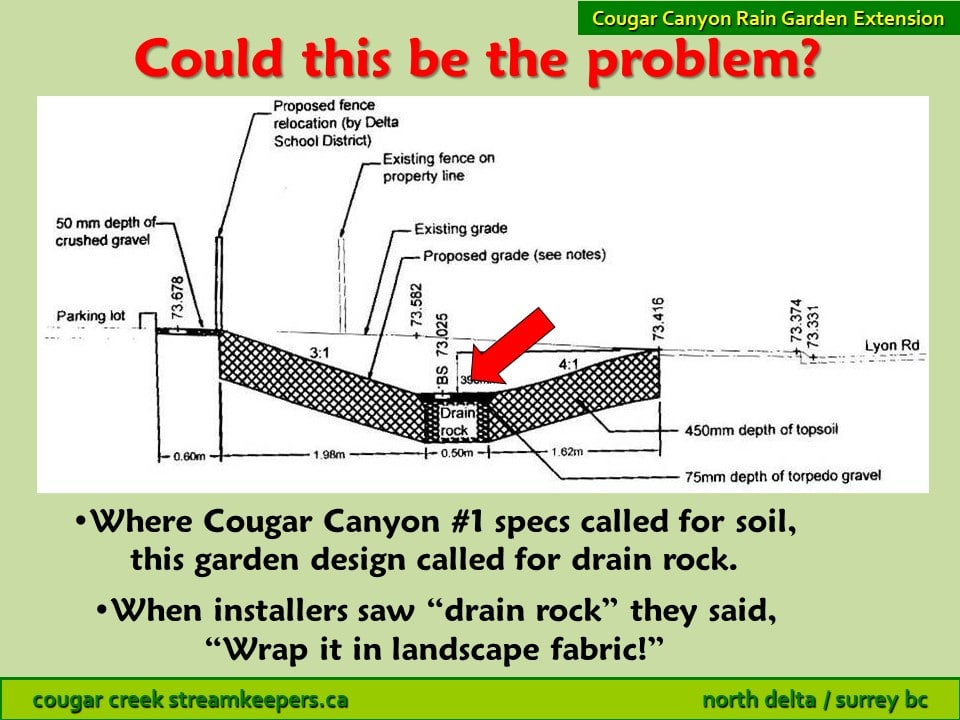



From the rain garden “live & learn” files
Cougar Canyon Elementary School Rain Garden had always functioned so perfectly, that when it came time to create a second one just the other side of the parking lot driveway, we were confident that it would work fine. So confident, in fact, that no overflow drain was provided.
Delta Engineering created their usual (or so we thought) imitation streambed, contoured the banks for planting, and arranged for safety fencing to be installed. In September 2009, students planted the garden with a generous supply of shrubs and groundcovers, purchased by Delta. Three deciduous trees were slated for later planting, once the weather became cooler and wetter.
All appeared to be fine. Until the first heavy rains, that is.
Oops! What was this lake? Why wasn’t the garden absorbing water quickly, as the first one had? Was it the absence of trees? (8 evergreens and 3 deciduous in the first garden, none yet in the second one) Did we need more evergreen sedges and shrubs? Was the fire hydrant leaking?
While we pondered the possibilities, we also learned from Delta that the structure of the Rain Garden Extension was actually quite different from that of the main rain garden, despite their similar appearance. The Extension featured a very large volume of drain rock, wrapped in geotextile (landscape fabric), down the centre of the garden. By contrast, the main rain garden had been entirely filled with highly absorbent compost/soil – with just a skim coat of gravel on top.
But aren’t rocks good for drainage?
The accepted wisdom is that lots of “drain rock” is good for drainage. So it was with great trepidation that Streamkeepers and students set about the exhausting task of manually removing the tons (or so it seemed) of drain rock and their geotextile wrapper. Then we backfilled with highly-absorbent landfill compost, topped with just a thin layer of gravel. To our relief, this fixed the problem!
We’ve learned that rocks aren’t so good for drainage after all – at least not infiltration drainage. If the water has somewhere to go, then a thick layer of rocks can keep our feet dry while the underlying water flows away. But if we need to absorb water on site, rocks are not the best answer.
Do crows know best?
Rocks displace water. Every smart crow knows this! Just read about Aesop’s fable “The Crow and the Pitcher” – a story confirmed by experiments with modern-day corvids.
In contrast to rocks, soil with lots of organic matter does not displace water, instead it soaks up water like a sponge. The more roots and soil organisms, the more water the soil can soak up, and slowly release down to the subsoil and groundwater.
Beware the overuse of rocks in rain gardens!
In addition to displacing water, overuse of rocks may perhaps also inhibit absorption in 2 additional ways:
(1) Their sheer weight may compact the underlying soil so tightly that millions of small porosities are squeezed shut, thus preventing water from trickling down easily.
(2) Rocks (and geotextile) are not nearly as good habitat as soil and compost, for the countless roots, invertebrates and micro-organisms that also contribute to creating porosities into which water can trickle.
A surface cover of gravel and/or boulders is great for aesthetics, and for protection against erosion in places where water may flow vigorously. It’s also good as a maintenance path, from which weeding and trimming can be done.
But underneath that thin layer of rock, soil rich in organic matter makes for the most effective rain gardens.
9111 – 116 Street, North Delta

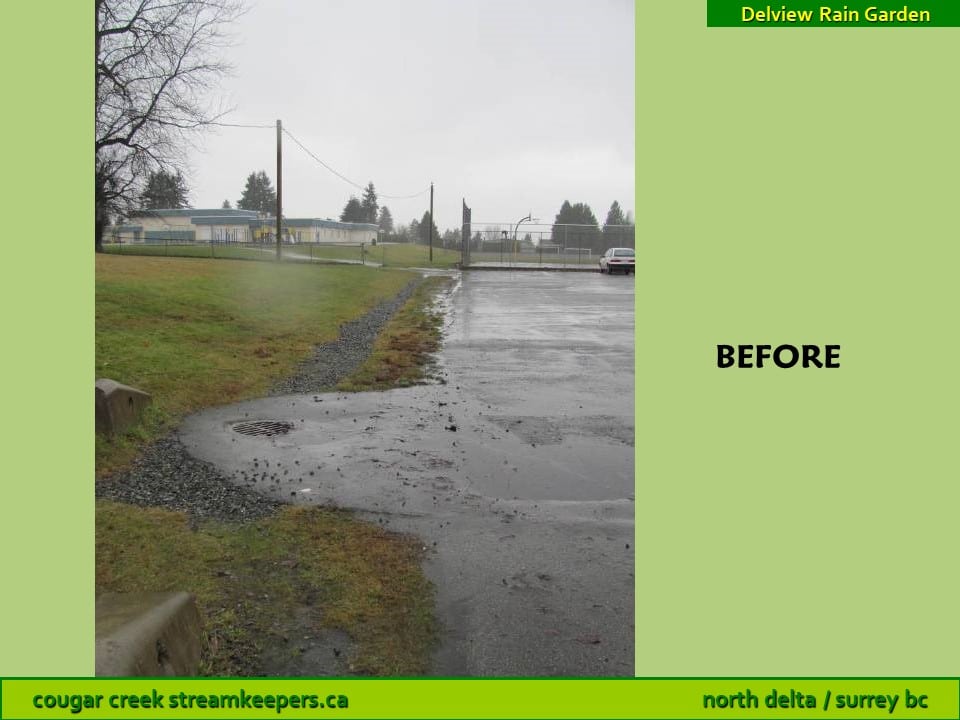
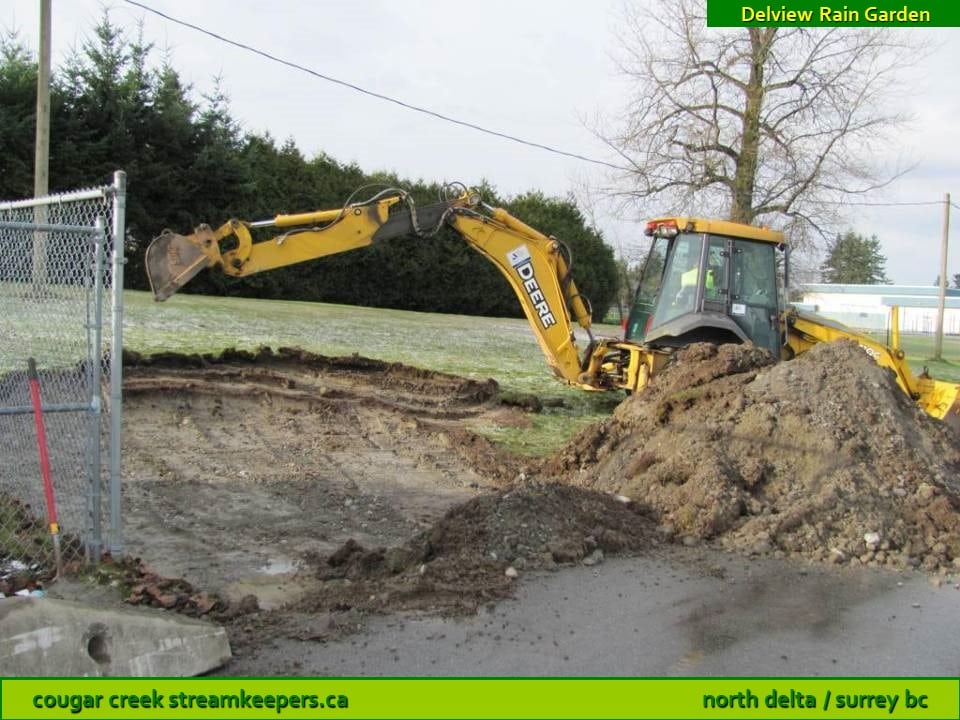
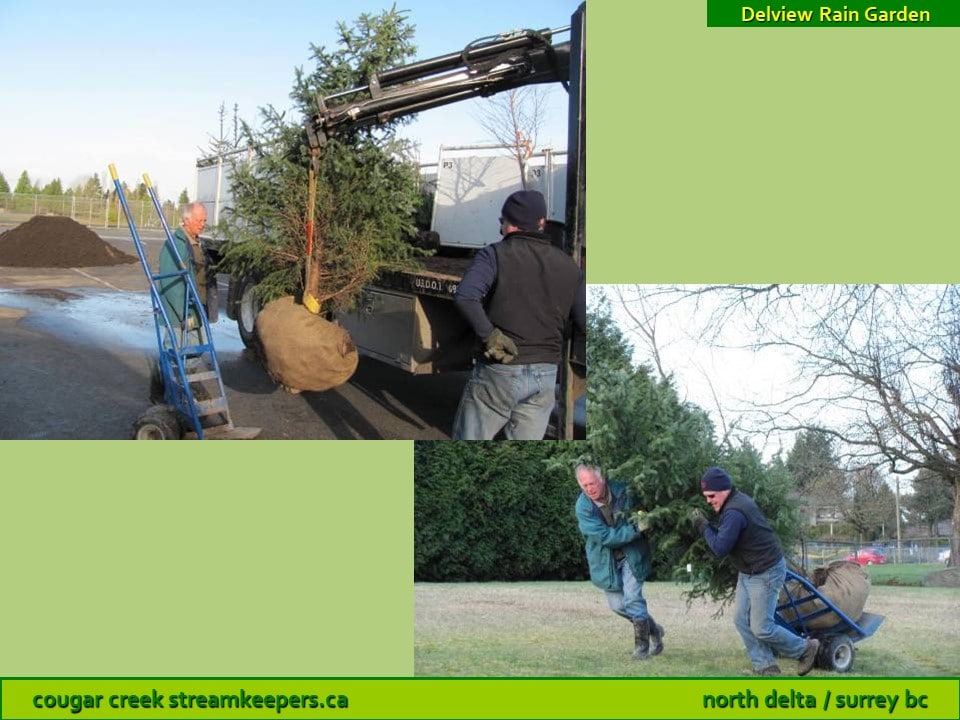
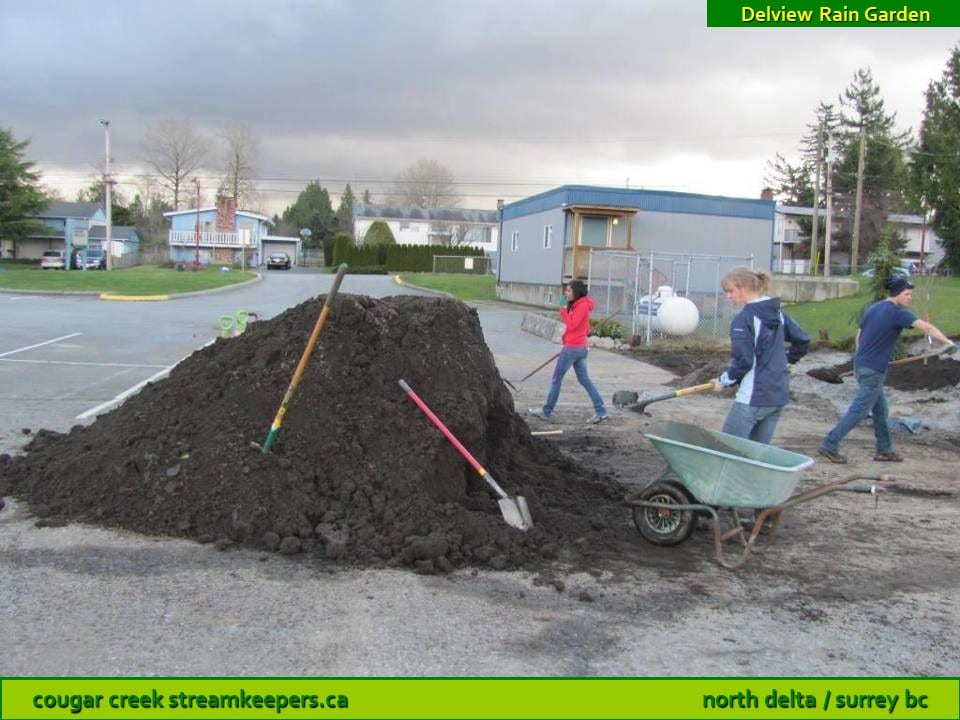


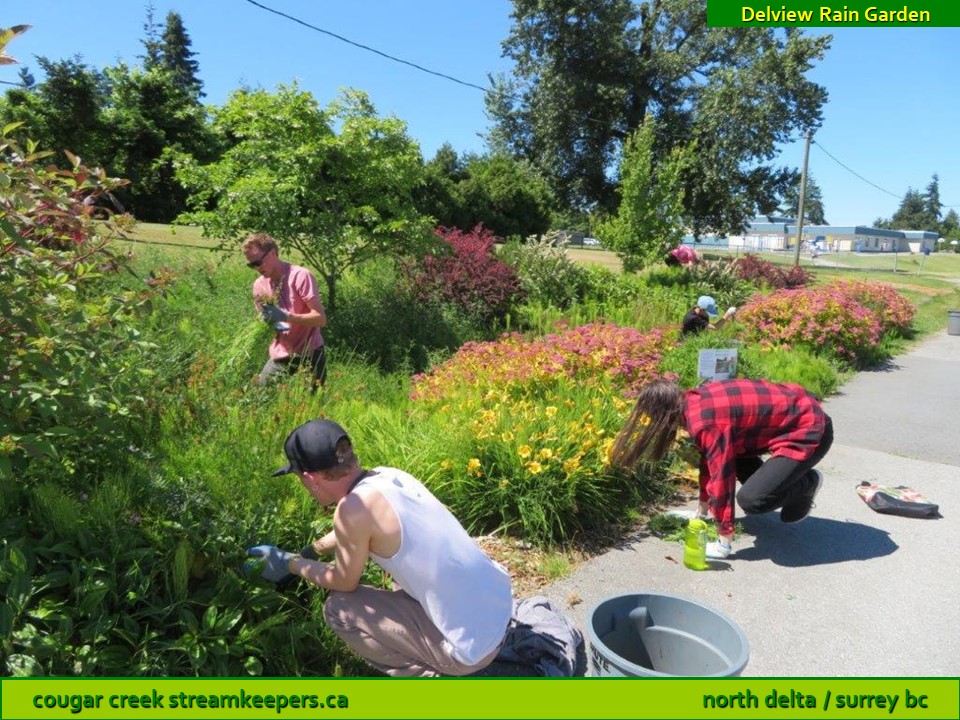

Never doubt the power of a few committed people …
One teacher, one student – that’s all it took to make Delview Secondary School Rain Garden a reality. From selecting an excellent site at the south edge of the school parking lot, to getting permission from Delta School District and a grant from The Nature Trust of BC, to corralling a few family members and friends to move a small mountain of compost into the garden and then plant trees and shrubs – all this was initiated at Delview by just one teacher and one student.
The garden itself is a great success, absorbing all the parking lot runoff that drains into it, and sending not a drop down a pre-existing storm drain that now serves as emergency overflow. And not only does the garden absorb runoff, it also absorbs the flow from a natural seepage on the garden slope. All this, with a poorly-draining clay layer just 20 to 50 centimeters (8 to 20 inches) underneath the soil ….
Delview Rain Garden clearly demonstrates the impressive ability of plants, organic mulches, soils and soil organisms (macro and micro) to help us manage rainwater in an economical and environmentally-beneficial way.
8884 Russell Drive, North Delta
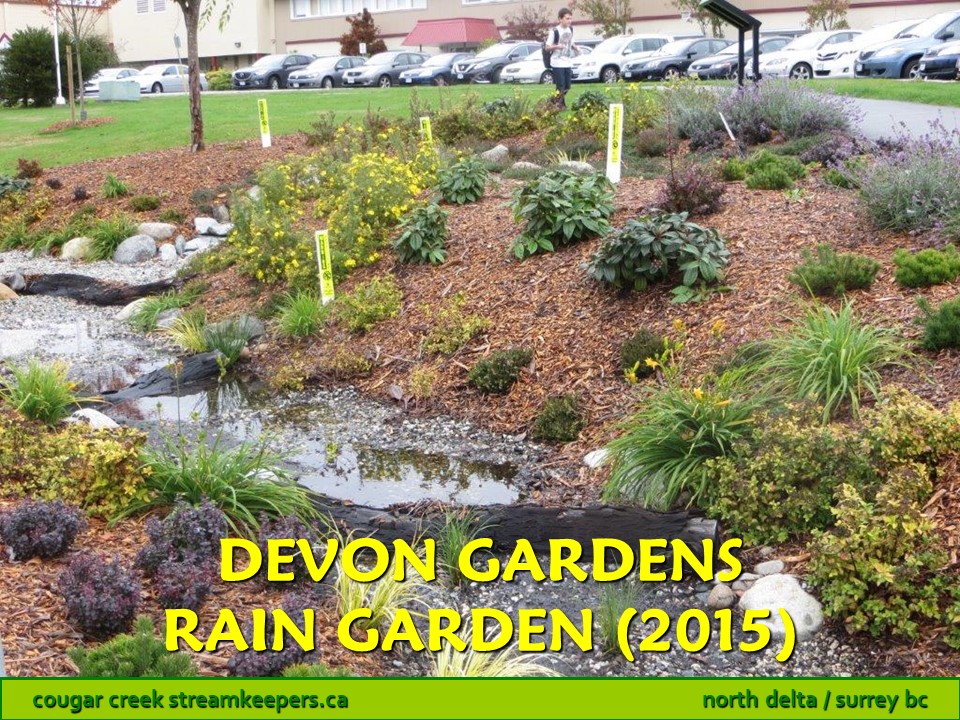
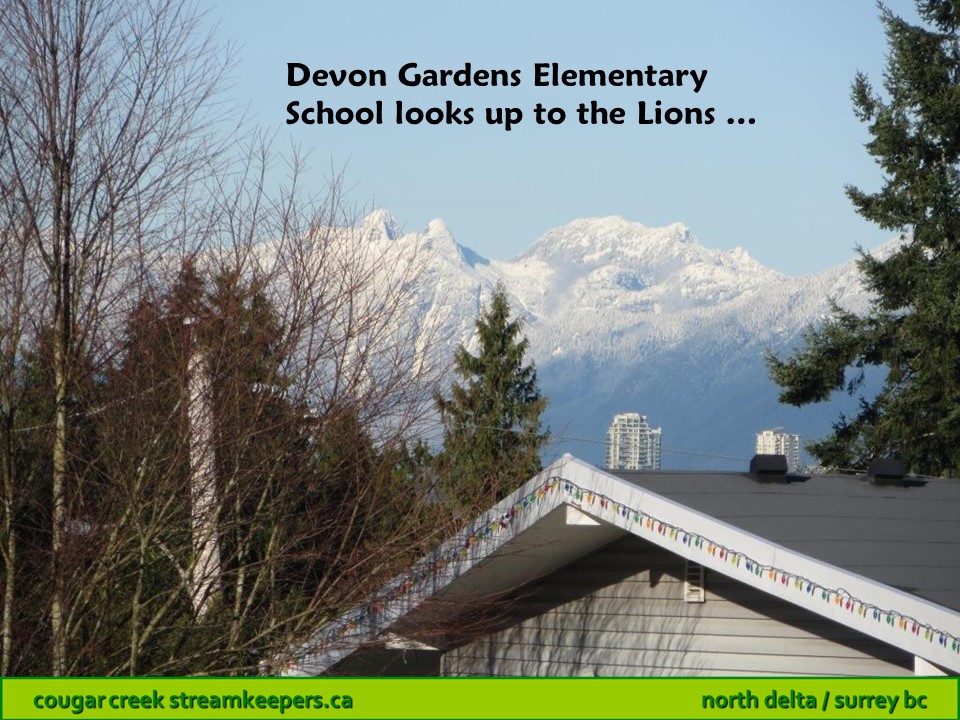

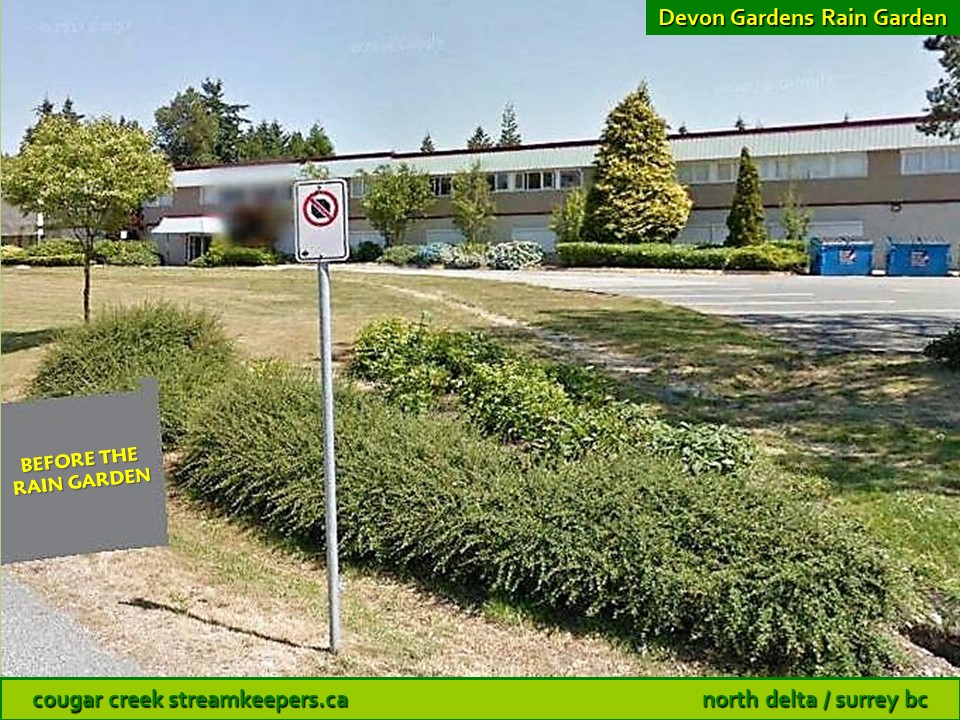


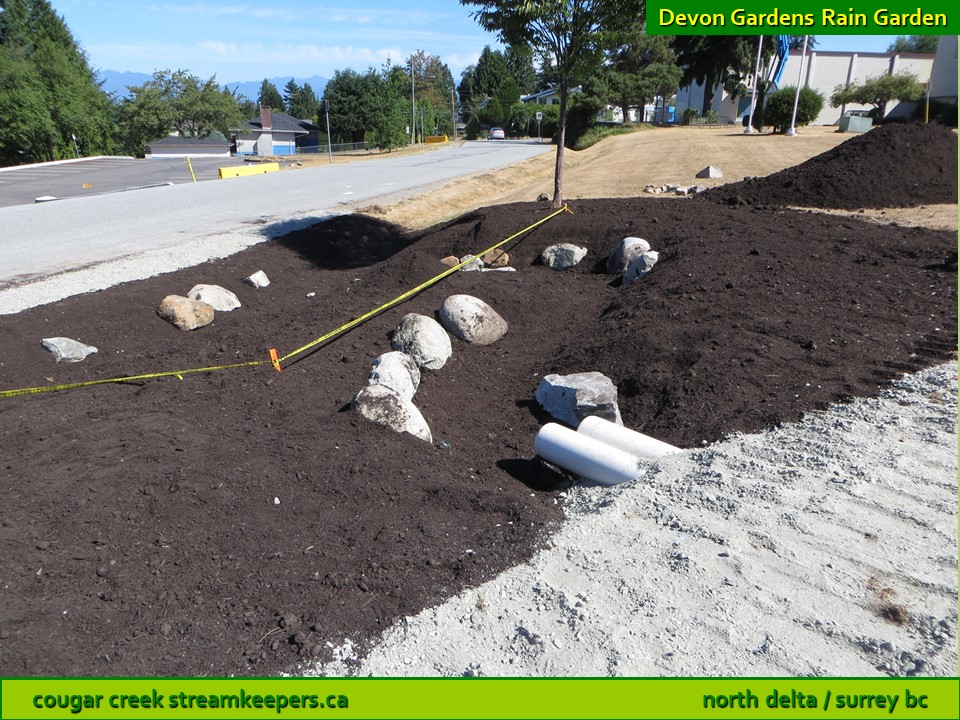
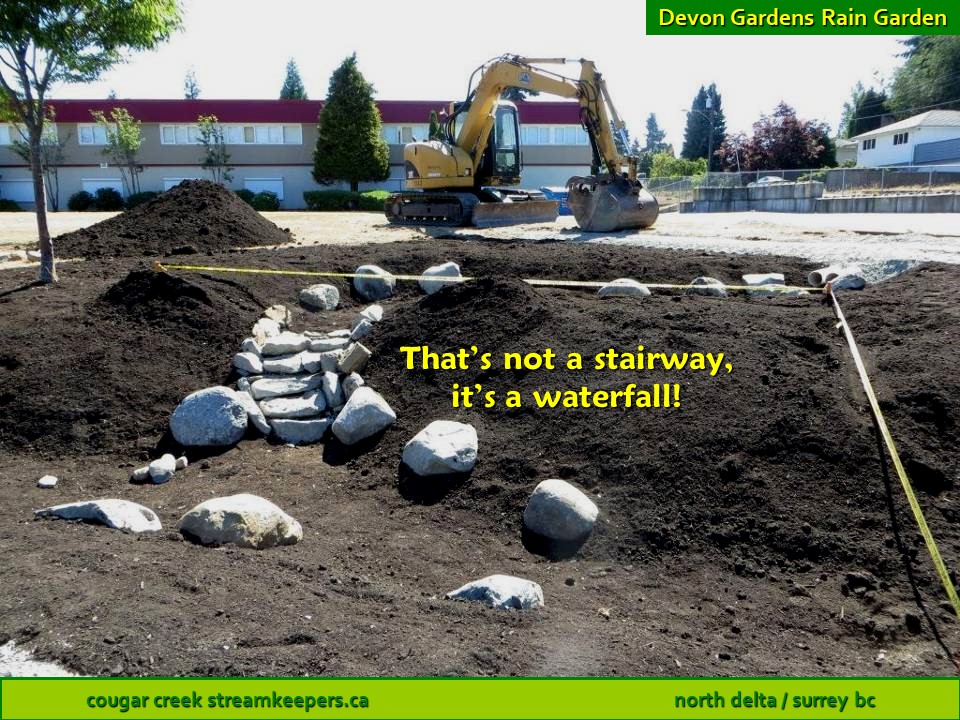

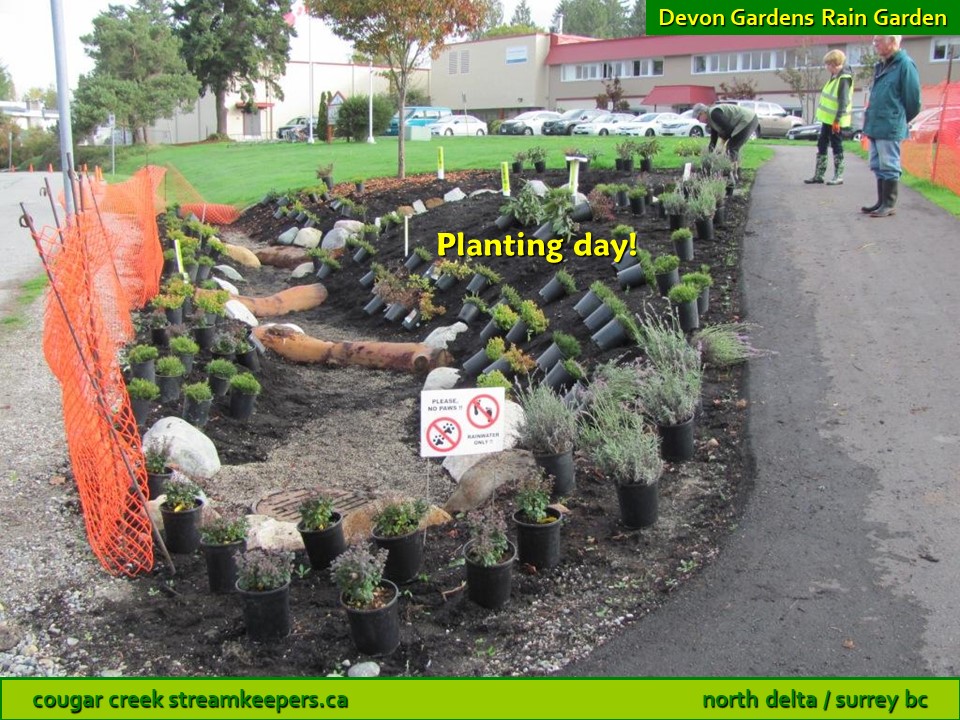


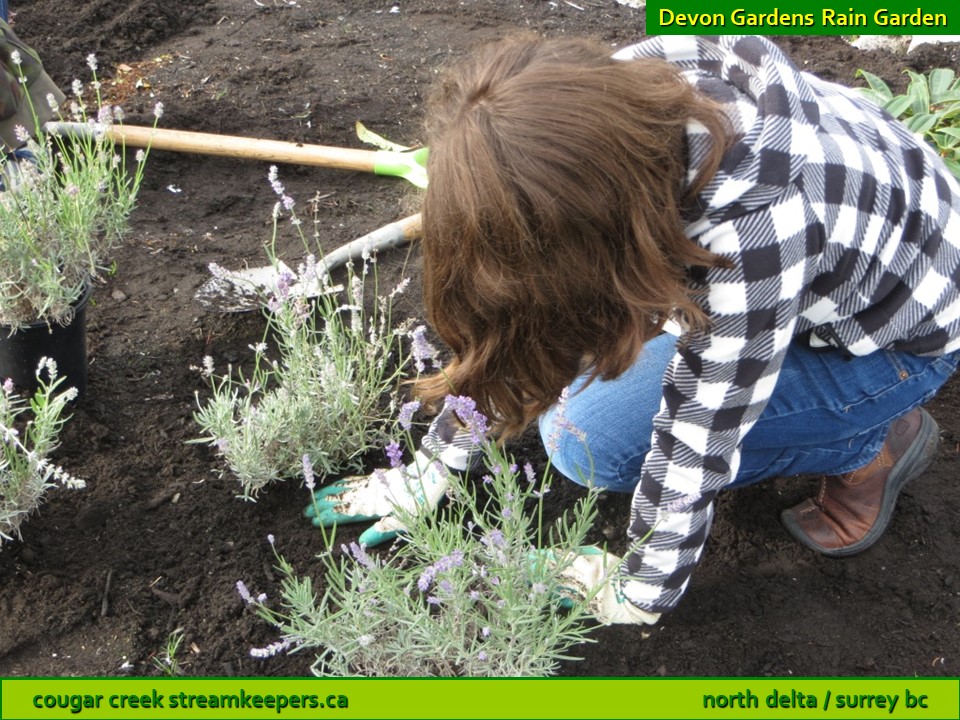

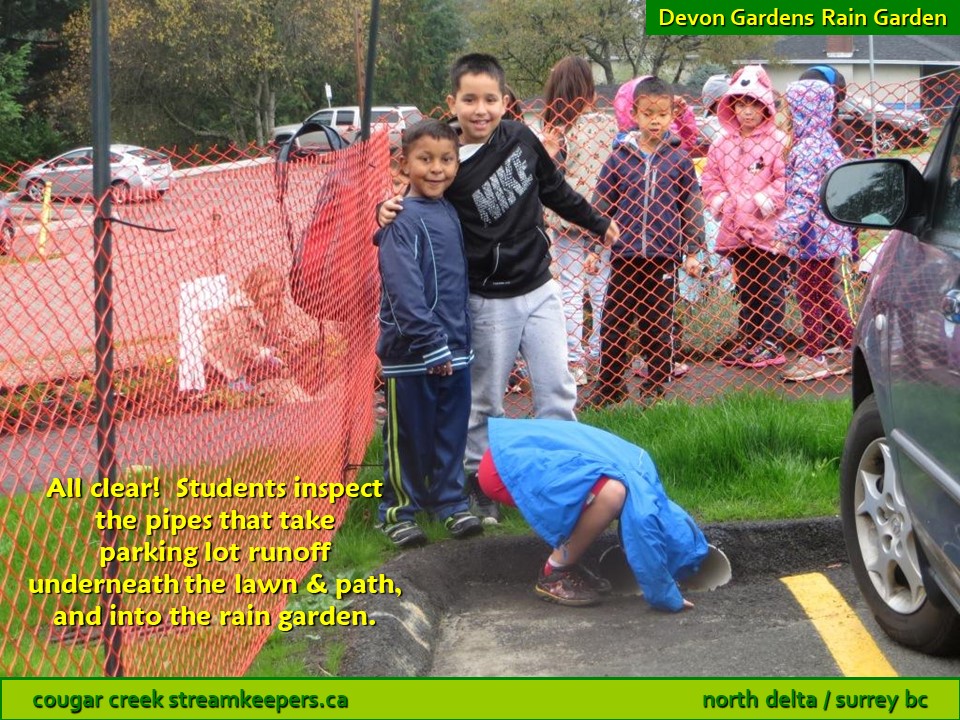
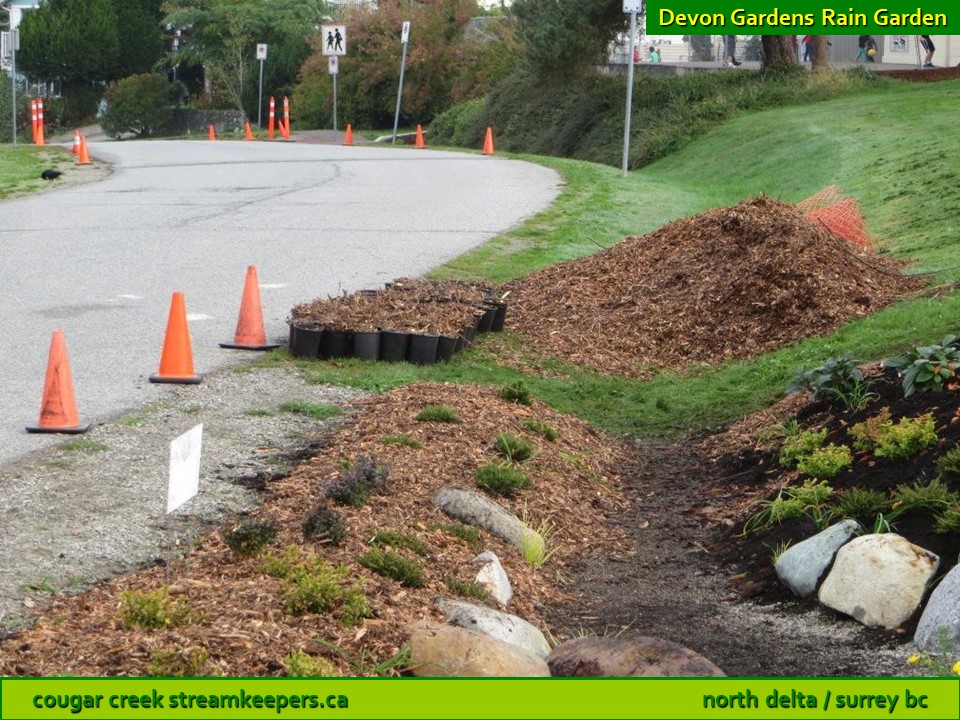



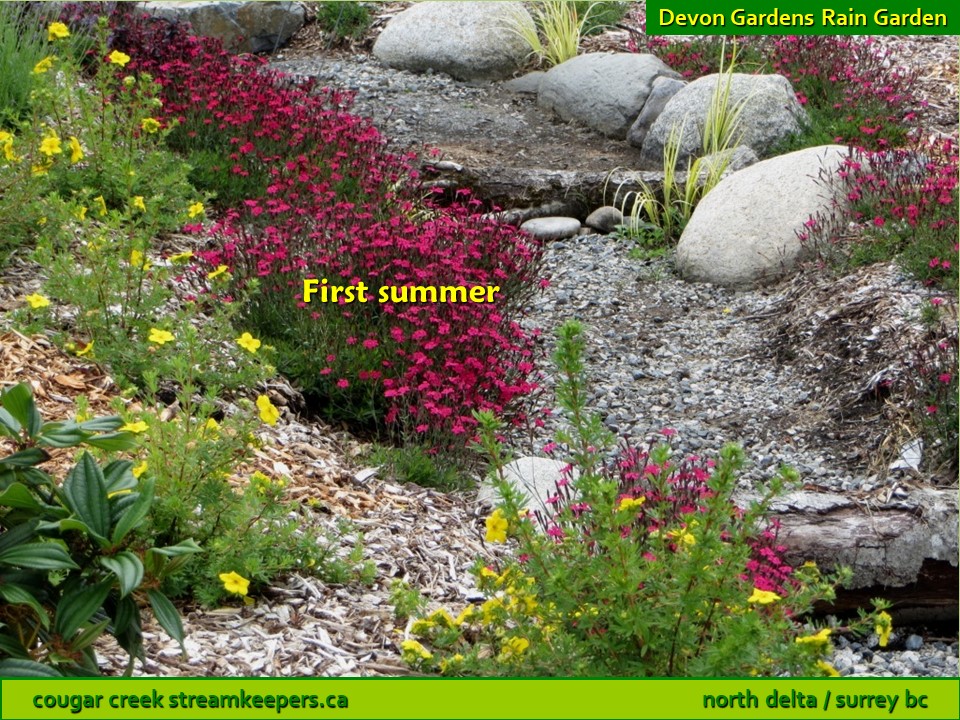

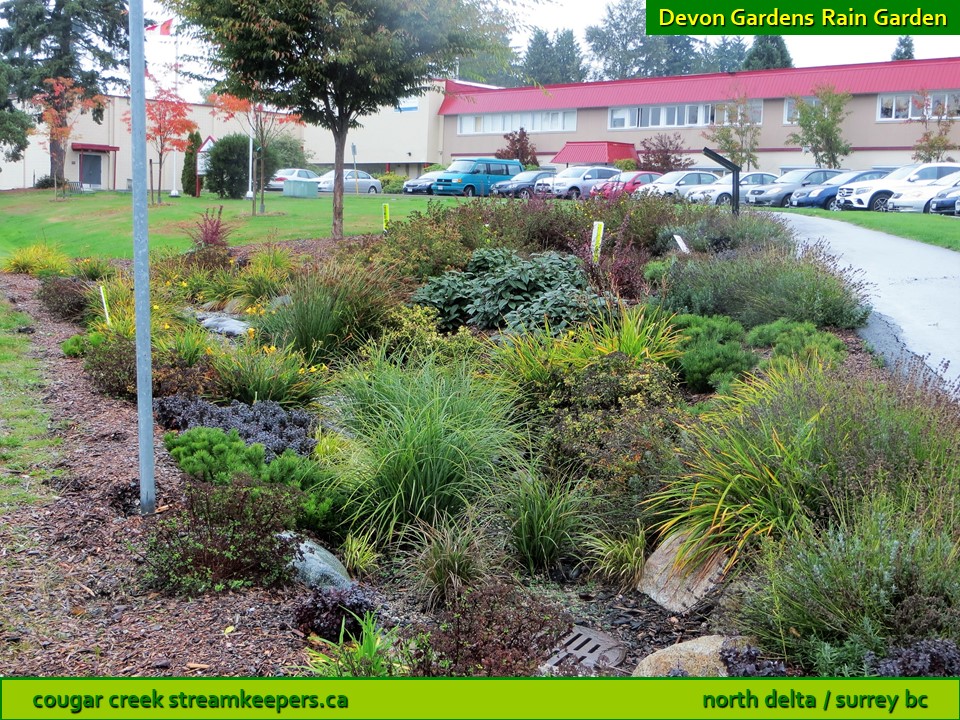

North Delta’s second most productive salmon stream
Every autumn, Streamkeepers regularly patrol Cougar Creek in search of coho and chum salmon spawners (95 sightings in 2015, 271 in 2016, 130 in 2017, 192 in 2018, 209 in 2019). McAdam Creek, in whose watershed Devon Gardens Elementary School is located, had not been patrolled in decades, if ever.
“Are there still salmon in McAdam Creek?”, we wondered, as plans took shape for a rain garden that would receive about 580,000 litres of runoff annually from the school parking lot ….
“Yes!” we learned, thanks to a few casual visits to the creek by Streamkeeper David Smith and Hemmera environmental consultant Jim Roberts. Between them, they logged 9 chum spawner sightings in just 3 visits – which means there were no doubt a lot more. In autumn 2016, David sighted 24 spawners in just two visits to McAdam.
This discovery “spawned” more than salmon fry, it also spawned the interest of some school staff and students, in learning more about McAdam. Principal David Hope and several Grade 7 volunteers explored the ravine, examined remains of a long-abandoned mink farm, picked up litter, removed invasive English ivy … and passed the word around that Devon Gardens has its own salmon stream just around the corner and down River Road.
Hopefully this beautiful little creek will benefit from additional rain gardens throughout its watershed.
Delta Nature Reserve underneath Alex Fraser Bridge, North Delta

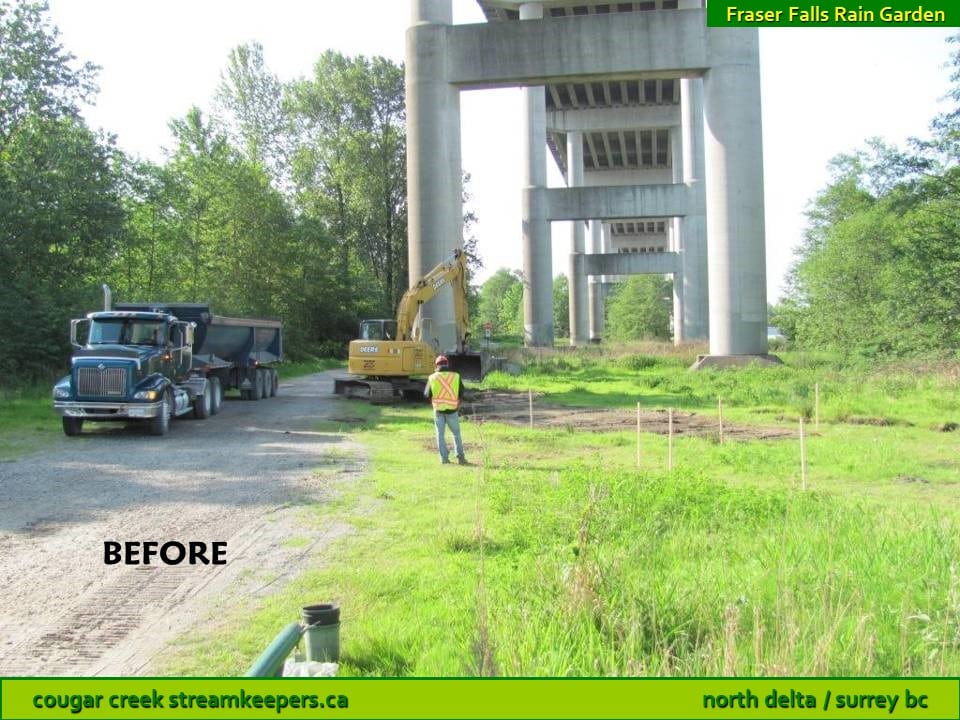
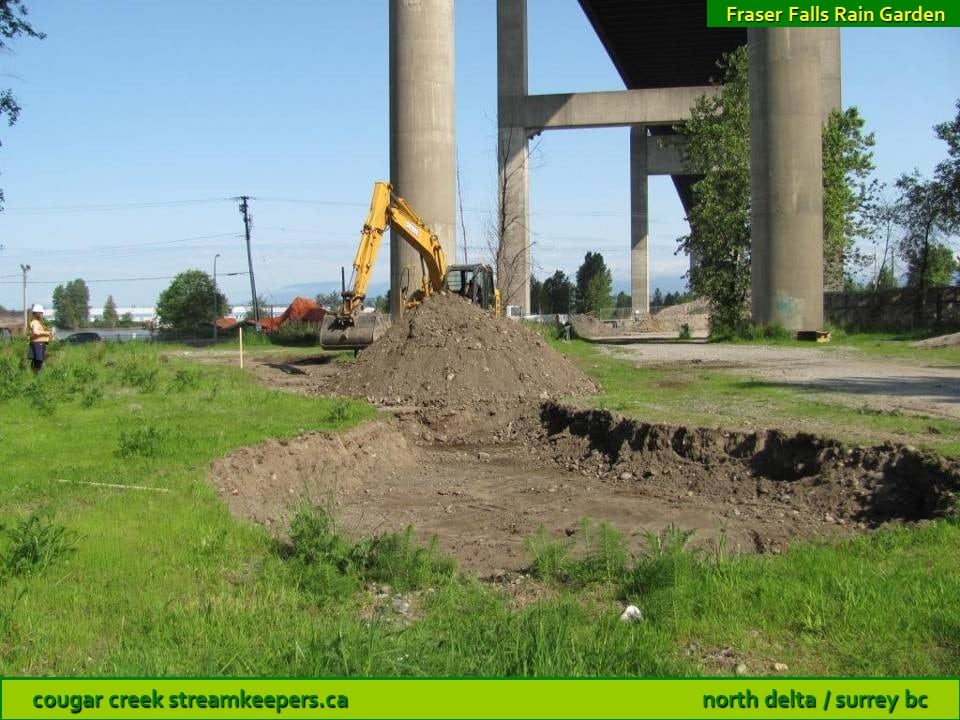

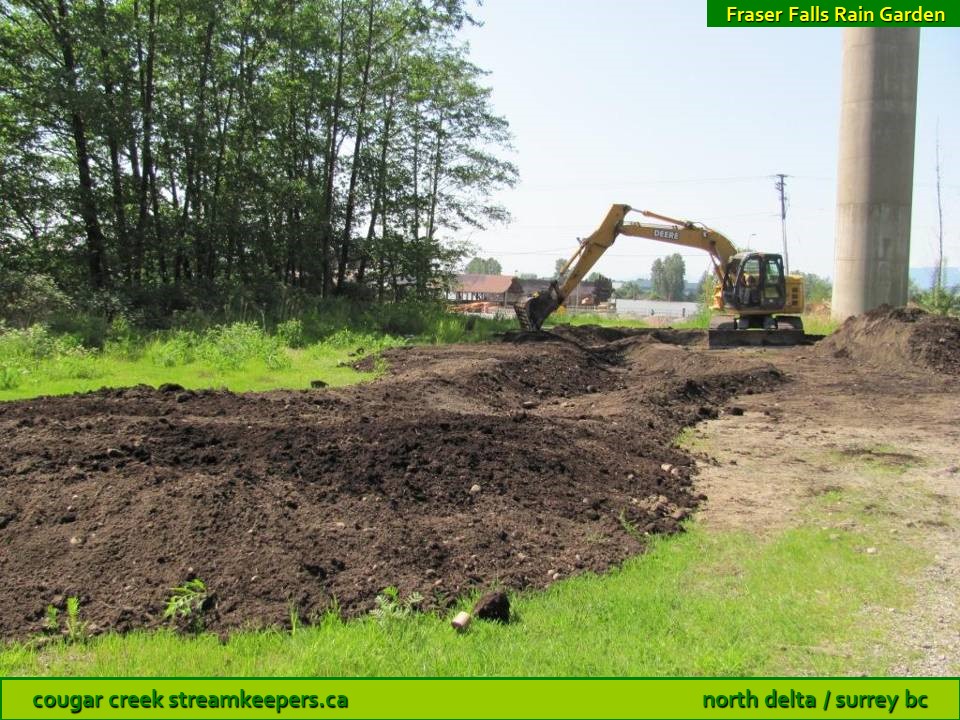

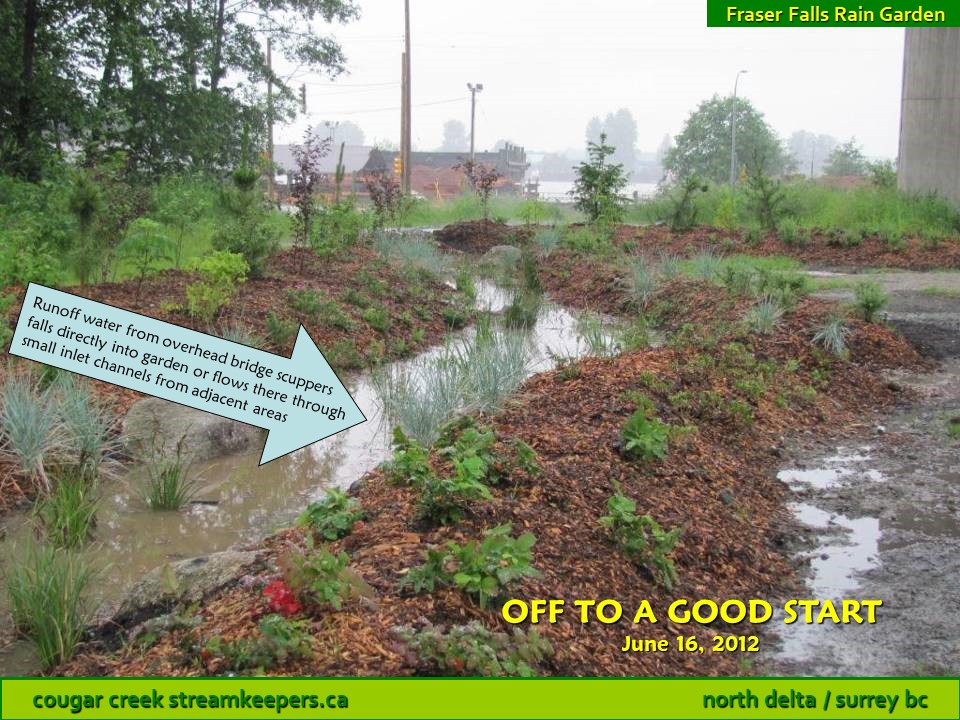
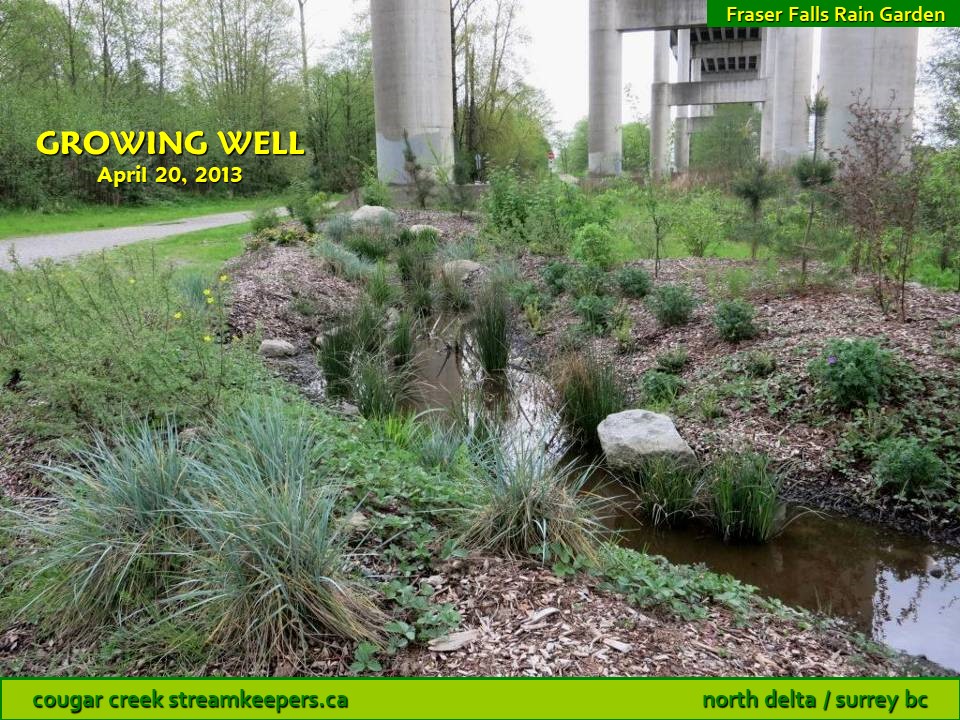
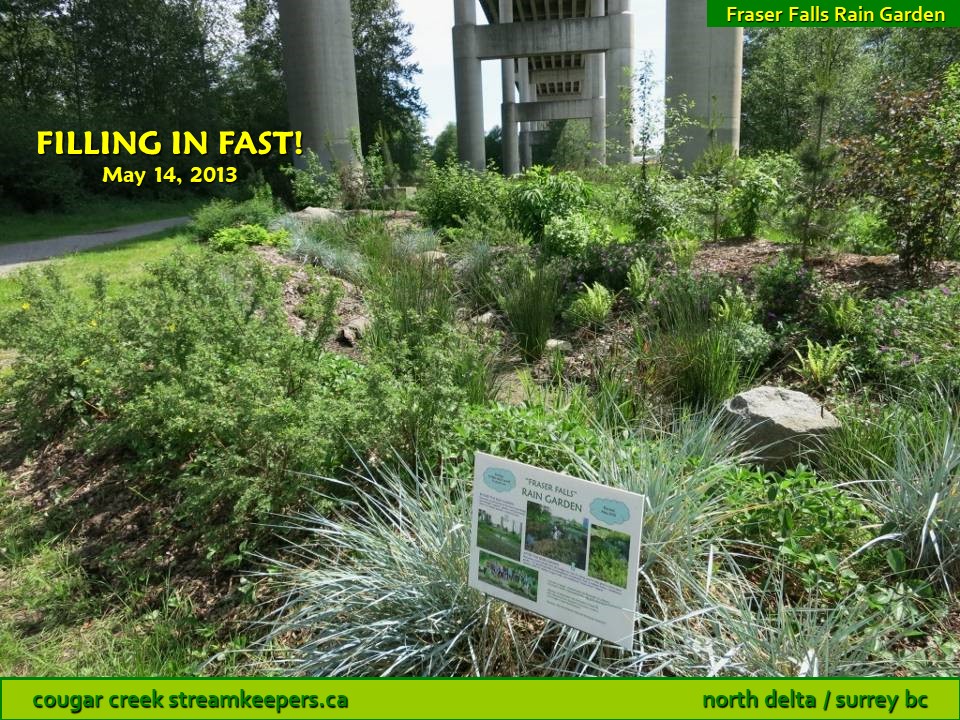




Burnsview Secondary students take on SFPR mitigation projects: Phase 1
Students of Danick Benoit’s Environmental Science class at Burnsview Secondary School in North Delta suggested the creation of a park on the Fraser River shoreline, just east of the Alex Fraser Bridge, as an environmental mitigation measure for the South Fraser Perimeter Road (Highway 17). The site they had in mind had in fact already been earmarked for just such a park, the St. Mungo Recognifition Site (honouring First Nations and fisheries history).
So instead, the students took on a 2-phase rain garden project, financed by SFPR and with technical assistance from Cougar Creek Streamkeepers.
Phase I was dubbed “Fraser Falls” Rain Garden by the students, because this garden uses rainwater runoff that plummets down from open pipes on the underside of the Alex Fraser Bridge Approach high above. From 1986 when the bridge was built, until 2012 when the rain garden was planted, the only vegetation benefitting from this water were blackberries, reed canary grass and a few tansies. Now, hundreds of native plants — including trees, shrubs, ferns, groundcovers and sedges — are growing vigourously underneath the south end of the bridge.
Fraser Falls Rain Garden filters contaminants from bridge deck runoff, and also provides much-needed riparian vegetation for adjacent Cougar Creek as it flows through this industrialized area and out to the Fraser River. The garden also serves to welcome walkers and cyclists to a superb trail system that connects the Fraser River to Boundary Bay, passing many environmental treasures along the way.
Read about Phase II of the Burnsview students’ mitigation efforts under Tidewaters Rain Garden.
11451 – 90 Avenue, North Delta











Once a forest, now a roundabout
Like nearby Annieville and Delview schools, Gibson Elementary occupies a site that was once densely-forested. Many of North Delta’s salmon streams had their headwaters in this and nearby areas — including McAdam, Collings, Norum, Honeymushroom, Kendale and Knudson creeks.
Nowadays, stormwater from Gibson’s roof and parking lot is piped into Honeymushroom Creek. Honeymushroom flows mostly in a culvert – the sad fate of many salmon streams – except for a short but potentially productive stretch just before it empties into the Fraser River.
The roundabout in front of the school offered a good opportunity to trap some of this stormwater runoff in a new rain garden, which would reduce pollutant loads and add to the natural groundwater flow to the creek.
Where there’s a will, there’s a way
It took 2 years of negotiations and planning, but Delta Engineering at last overcame 2 hurdles: first, negotiating a drainage right-of-way so that municipal crews could work on School Board property; and second, designing a spillway that would bring additional water into the rain garden from 90th Avenue.
Here’s how that design works:
Runoff from 90th Avenue crosses the sidewalk in a trench drain, then flows down a spillway, into a small storm drain, underneath the pedestrian walkway, and through another trench drain into the rain garden. Whew!
Planting time
After Delta had added 5 new trees to the roundabout, it was the turn of older students to plant shrubs, grasses, rushes and groundcovers. Primary grades then mulched the entire garden with woodchips, which maximize water absorption and also protect against soil compaction, erosion and weeds.
We use arborist woodchips (from tree pruning or removal), which contain a “potluck” of wood types, leaves and needles. Gardens thrive with this mulch.
Stunning ensemble
We knew that the existing roundabout trees – already quite large — would “anchor” the new rain garden nicely. However, until just a month before earthwork began, we had no idea that the blank wall behind these trees was to receive an impressive “wild BC” mural. Delta rain garden designer Sarah Howie chose plants that beautifully complement the mood of this mural.
As with all densely-planted rain gardens, this one has become increasingly efficient at soaking up water, thanks to the growth of plant canopies, roots and soil organisms.
0855 – 80 Avenue, North Delta















11364 – 72 Avenue, North Delta
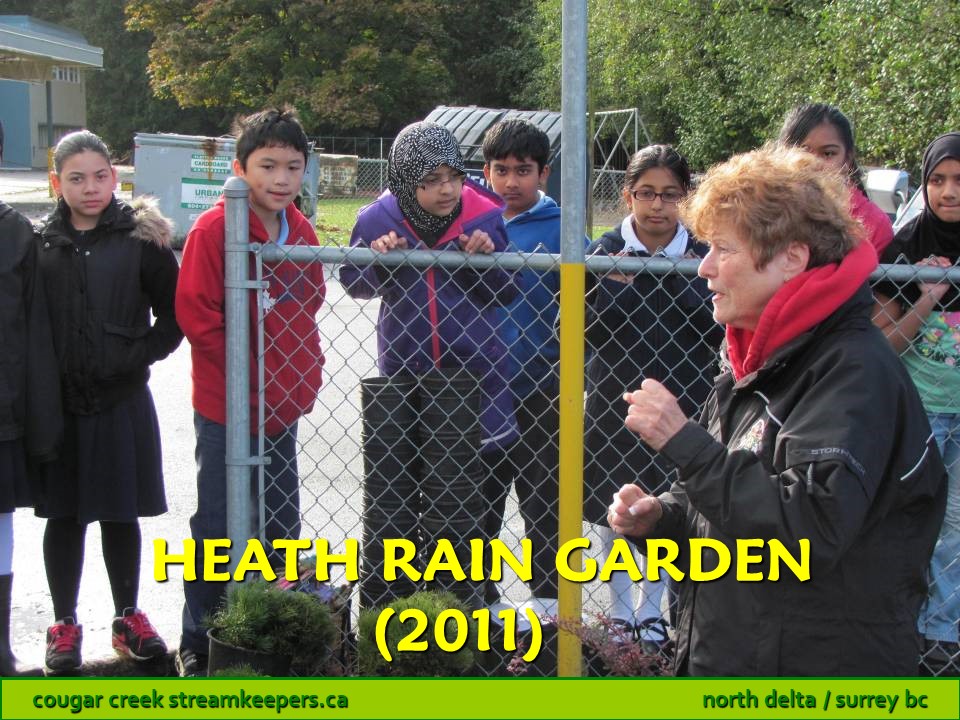
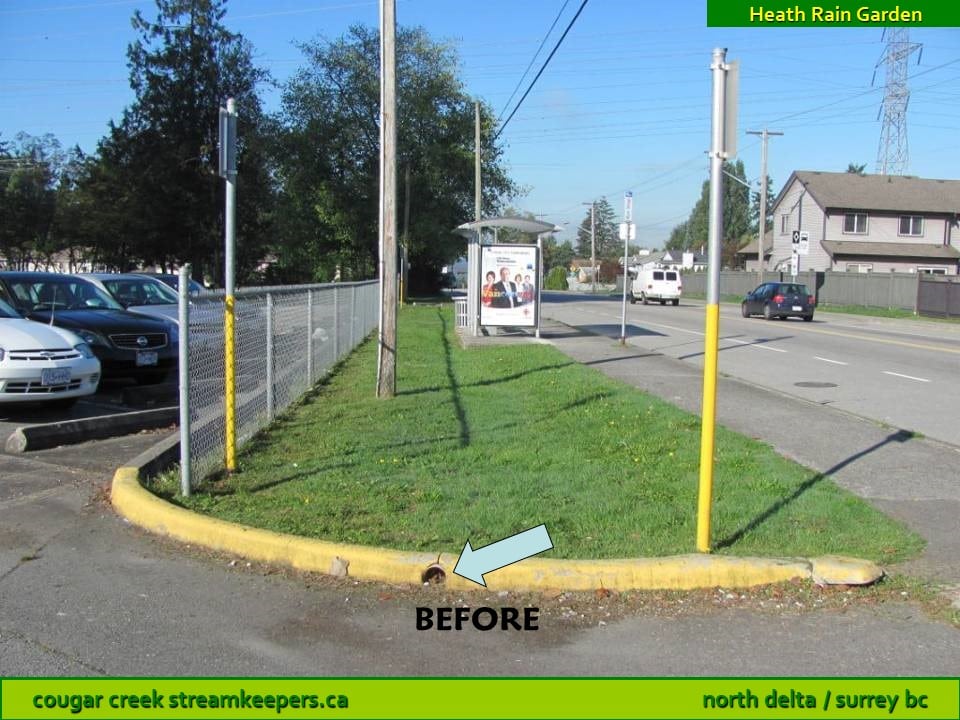





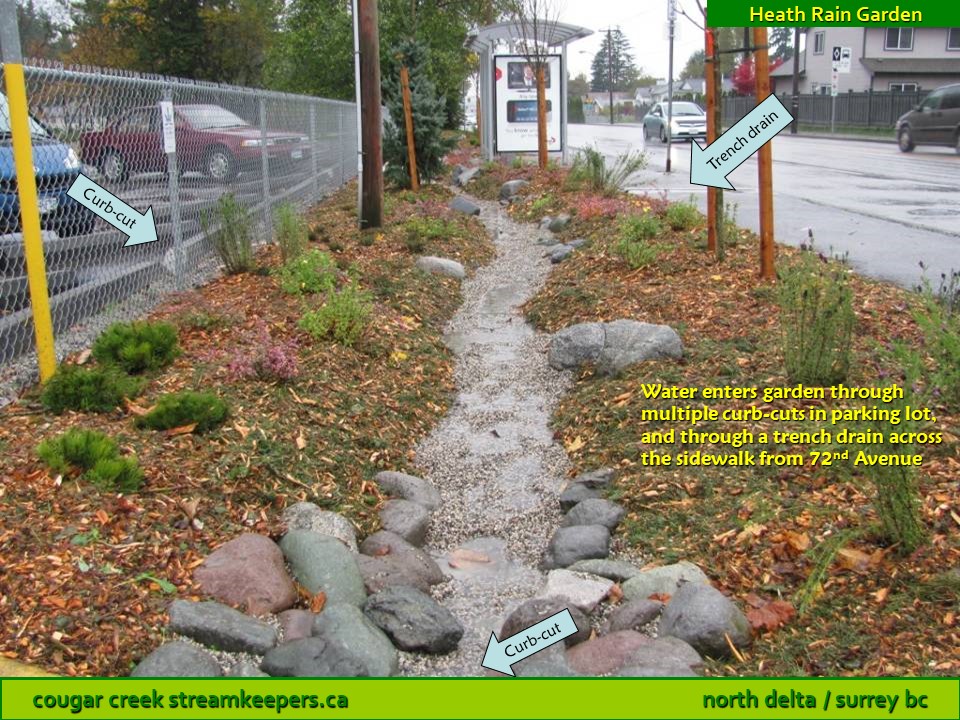
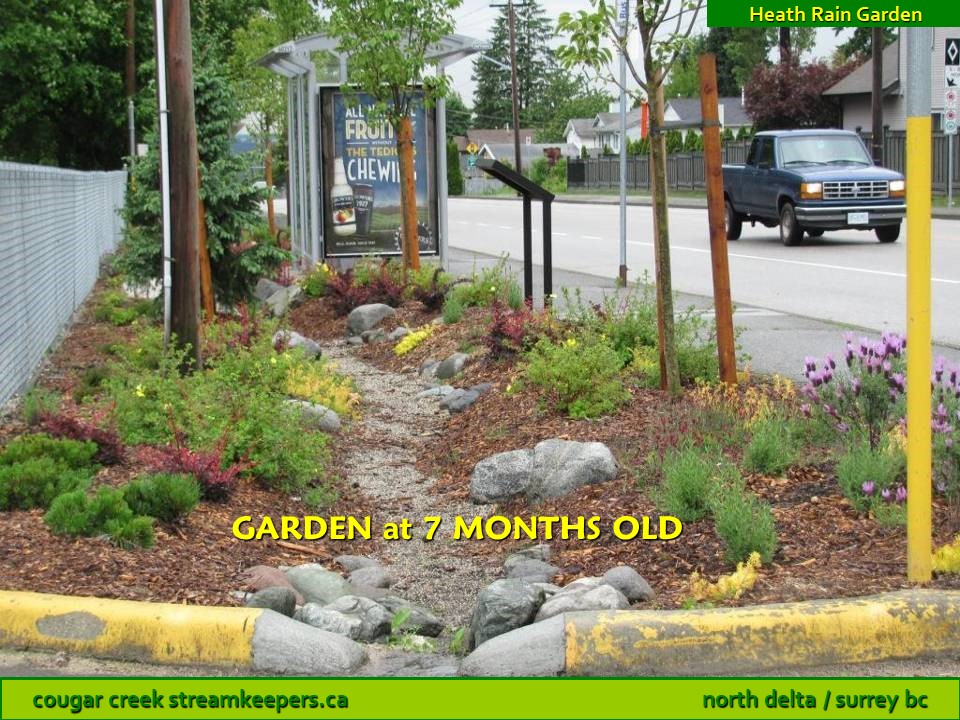





Prominent location
Commuters slow to 30 kph as they drive past Heath Traditional Elementary School on 72nd Avenue at 113th Street. With Cougar Creek directly behind the school – deep in its beautiful canyon – and a busy thoroughfare directly in front, Heath seemed like the perfect location to advertise rain gardens. A bus shelter, right in the middle of the proposed site, offered even more exposure.
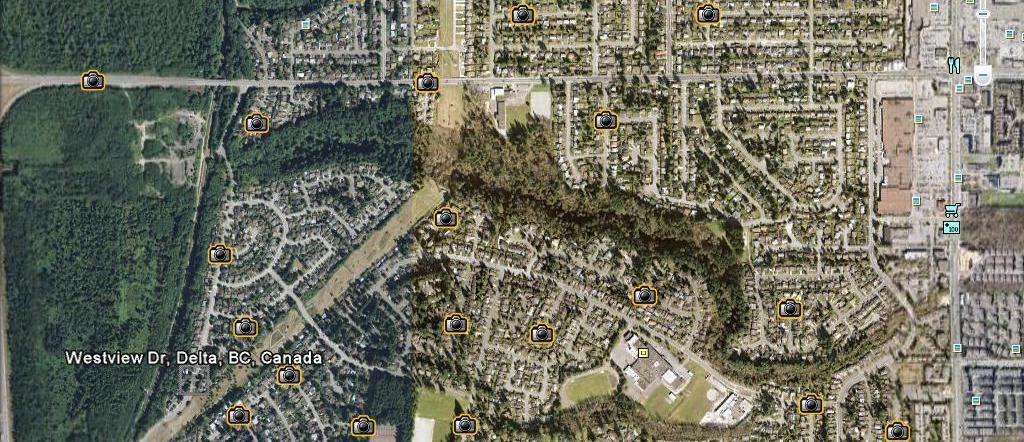
One small problem
The only problem was that much of the runoff from the west parking lot was already infiltrating into either the grass boulevard or the Hydro right-of-way. How could we justify the expense of a rain garden, when the site was already functioning as one (albeit not a very attractive one)?
Delta Engineering figured out how: by diverting runoff from 72nd Avenue itself, as well as enlarging the pre-existing intake from the school driveway in order to more effectively trap runoff.
The result has been a garden perfectly-sized for the runoff it’s receiving – capable of absorbing all the water, yet wet enough in heavy rains to clearly demonstrate its purpose and function.
Planting days
Delta Mayor Lois Jackson came to thank the students for their contribution, as they set to work planting 350 shrubs, ferns and groundcovers on November 3, 2011. By the end of the next day, all plants were in the ground, and the entire garden had been mulched with woodchips.
Even at just a few months old, Heath Rain Garden proved itself to be not only highly valuable to Cougar Creek (it absorbs an estimated half million litres of water annually), but also one of our most well-known rain gardens.
Almost all North Deltans, and seemingly half of Surreyites as well, drive by this site at one time or another, if not daily. Interpretive signage near the bus shelter help educates the public (or at least some bored transit riders) about the important role that rain gardens can play in restoring salmon habitat and reducing the pollution of our creeks, rivers and oceans.
11655 – 86 Avenue, North Delta
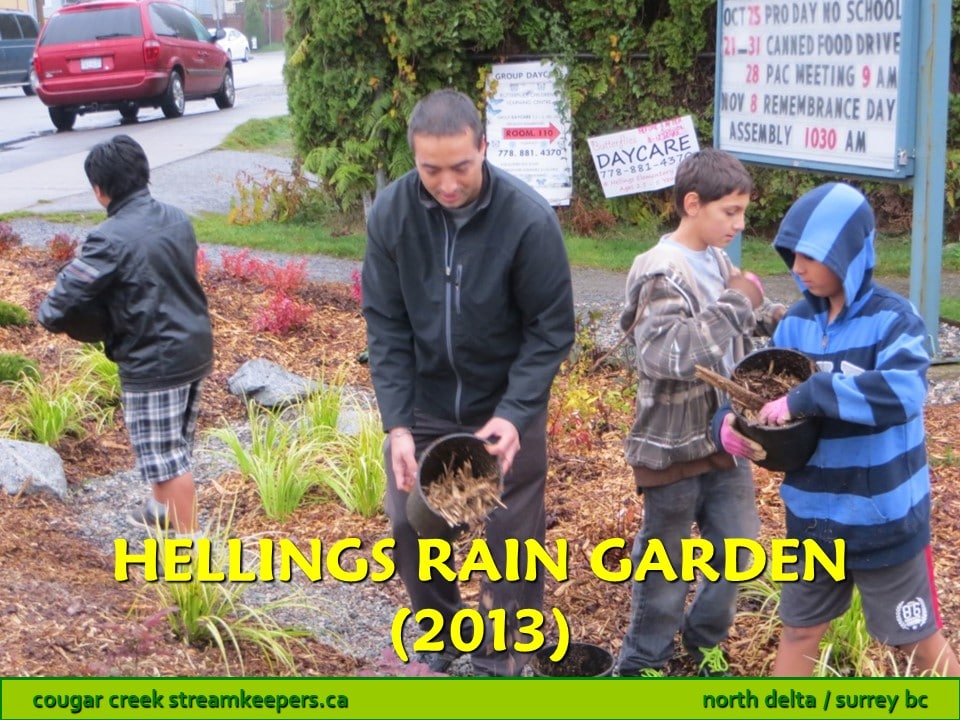
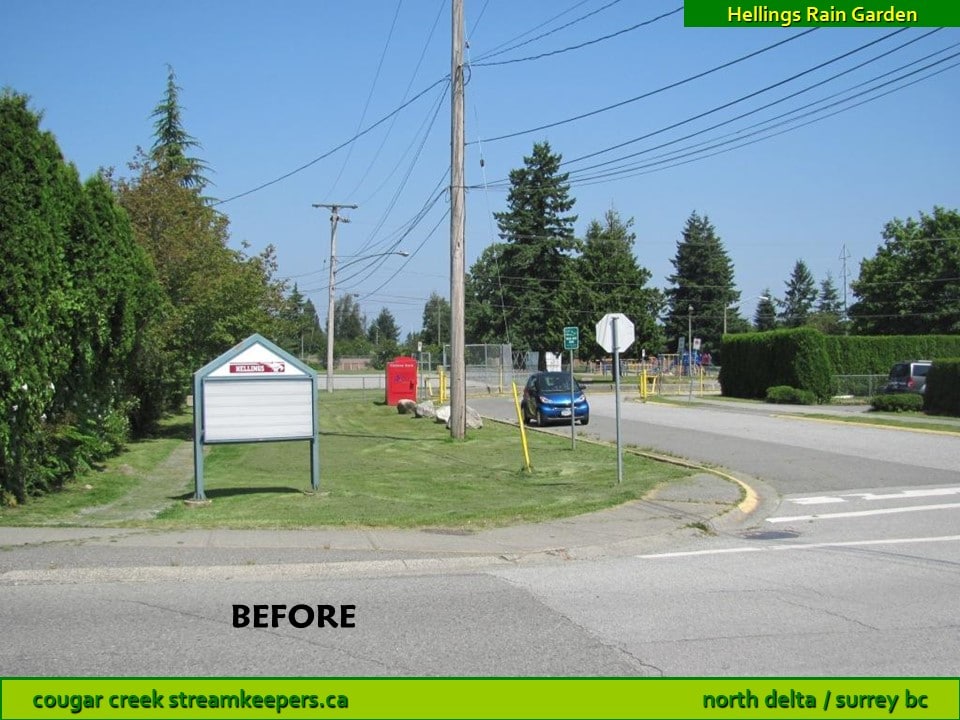










Rain garden raises school profile
“I never noticed there was a school here before,” remarked a passing neighbourhood resident to Hellings Elementary School principal Taj Reel, shortly after students planted their rain garden at the entrance to the school driveway.
Indeed, the entrance from 86th Avenue was not very eyecatching, and the school itself is set so far back as to be barely visible. The rain garden has focussed more attention on Hellings Elementary, and in addition, it makes a small contribution to the health of Bear Creek in Surrey.
Water doesn’t respect municipal boundaries – it simply flows downhill, whether in creeks, or as groundwater (underground water) or in storm sewers. Although Bear Creek is largely associated with Surrey (especially the beautiful stretches in Bear Creek Park), the Bear Creek Watershed extends into Delta and includes Hellings School.
Similarly, Cougar Creek is largely associated with North Delta, but a great deal of the water in the creek actually comes from the Surrey portion of its watershed.
7670 – 118 Street, North Delta










Where paved no-parking zones once dominated the school entrance, Jarvis Elementary now boasts two rain gardens (one on either side of the entrance driveway), planted with a wide variety of low shrubs, ferns, flowering plants and groundcovers. An existing mature ‘Akebono’ cherry tree – a cloud of pale pink in spring – is the focal point of one of the gardens. A second young ‘Akebono’ has now joined it, in the garden on the other side of the driveway.
Four curb cuts guide about 665,000 litres of parking lot runoff per year into the rain gardens. There’s some overflow during the heaviest rains, down 2 pre-existing storm drains that are now surrounded by landscaping – but much of the parking lot runoff soaks into the ground where it can seep gradually to Blake Creek.
And of course, the school entrance looks so much better!
11532 – 80 Avenue, North Delta
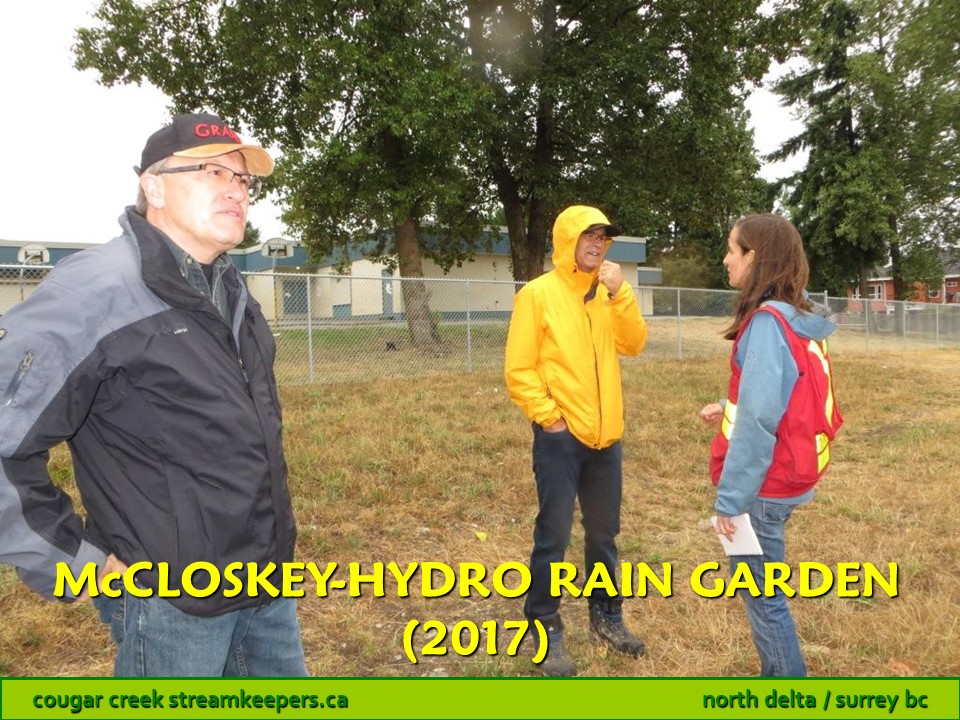
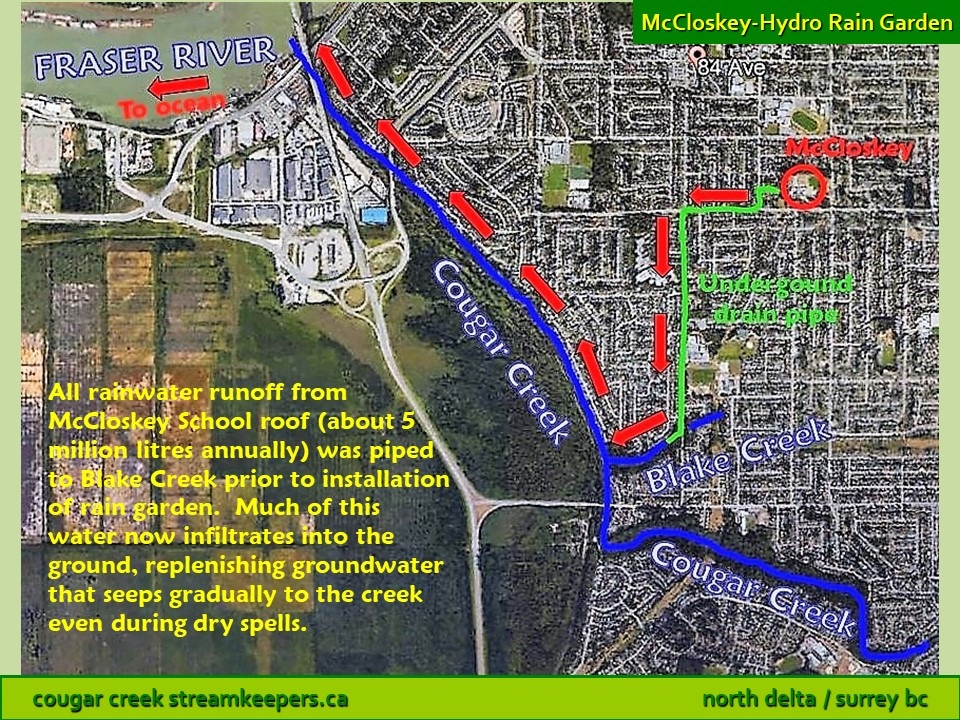
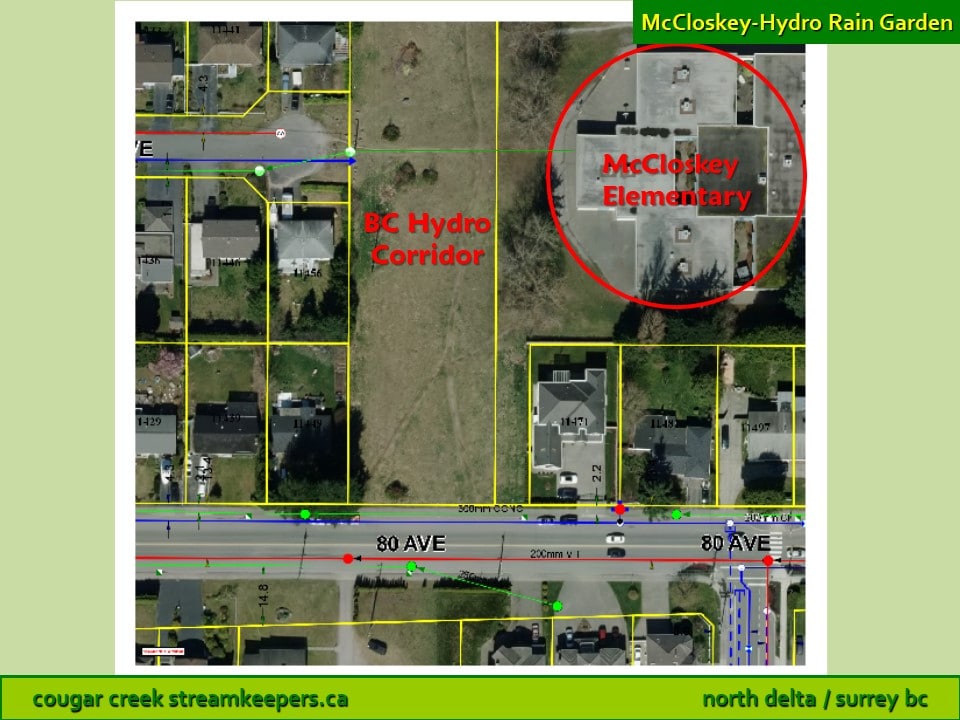
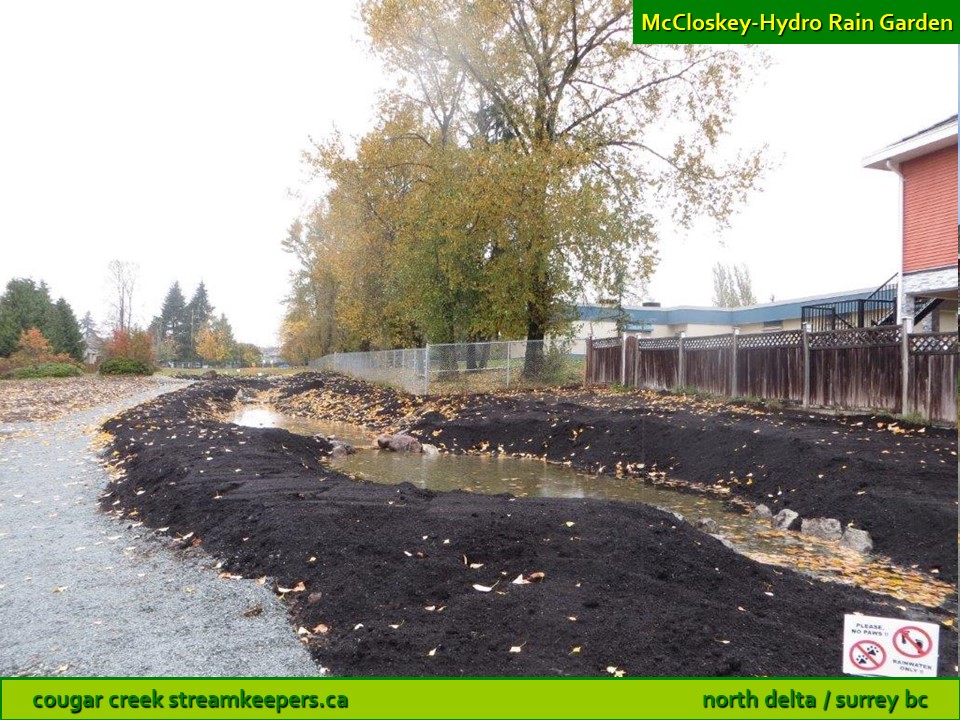

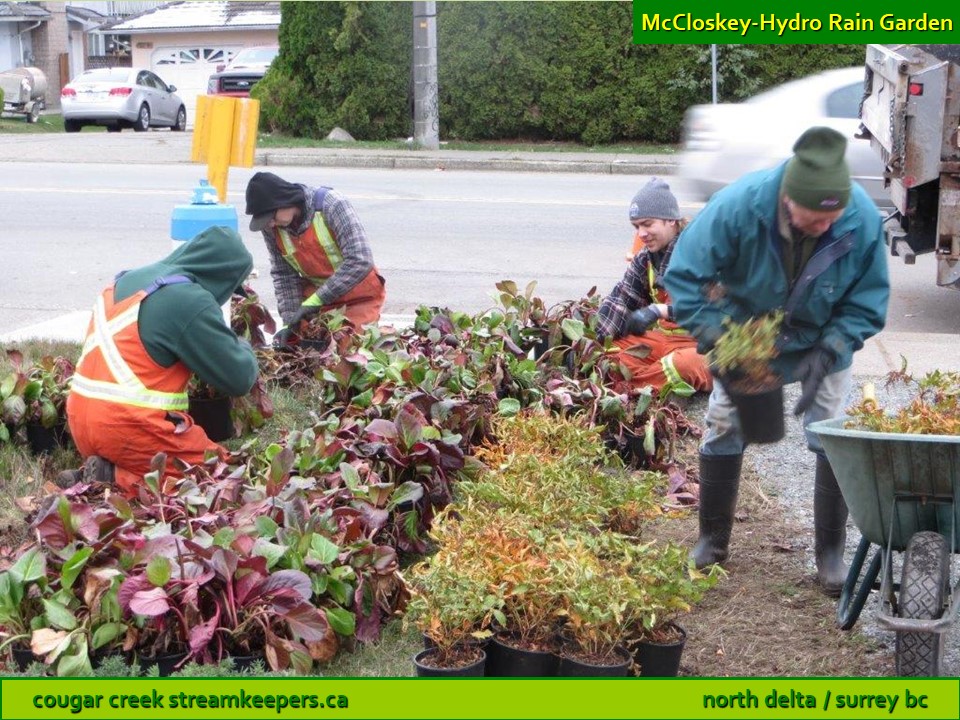


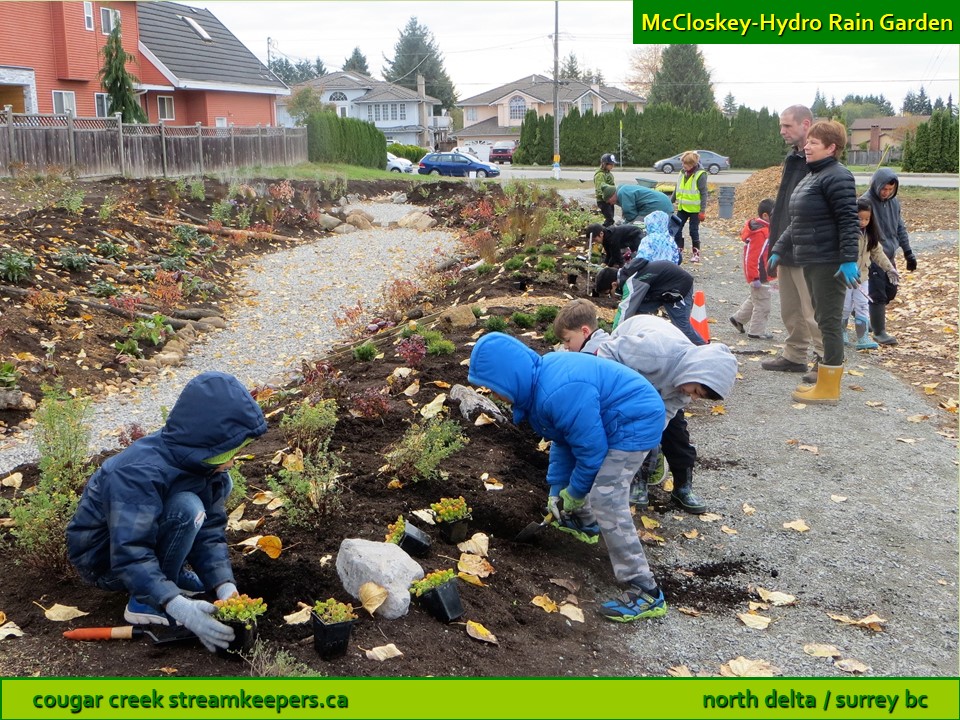
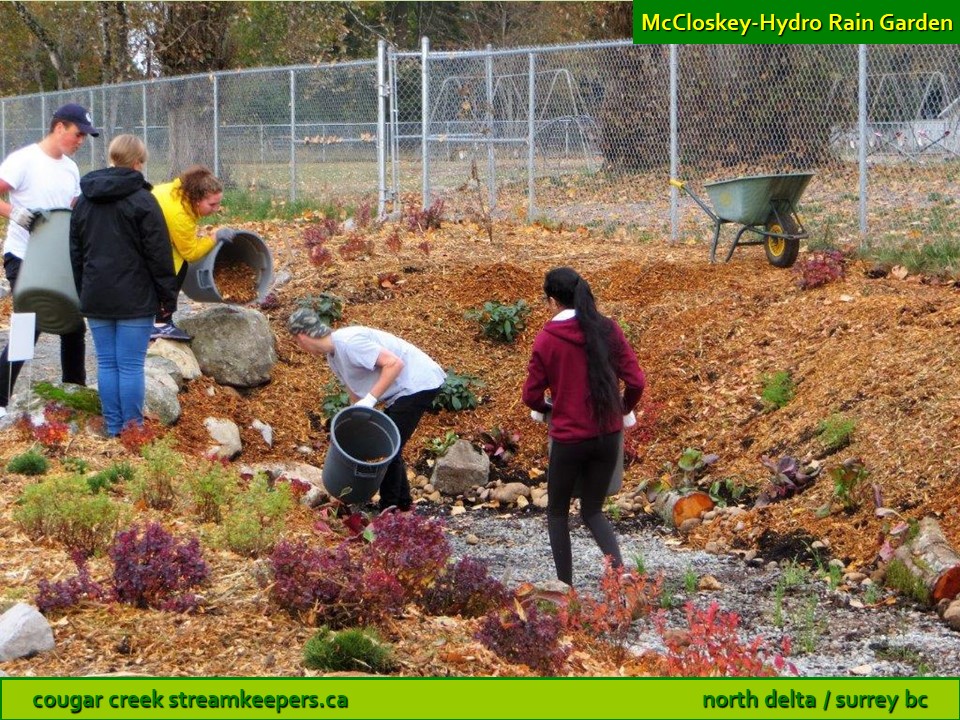
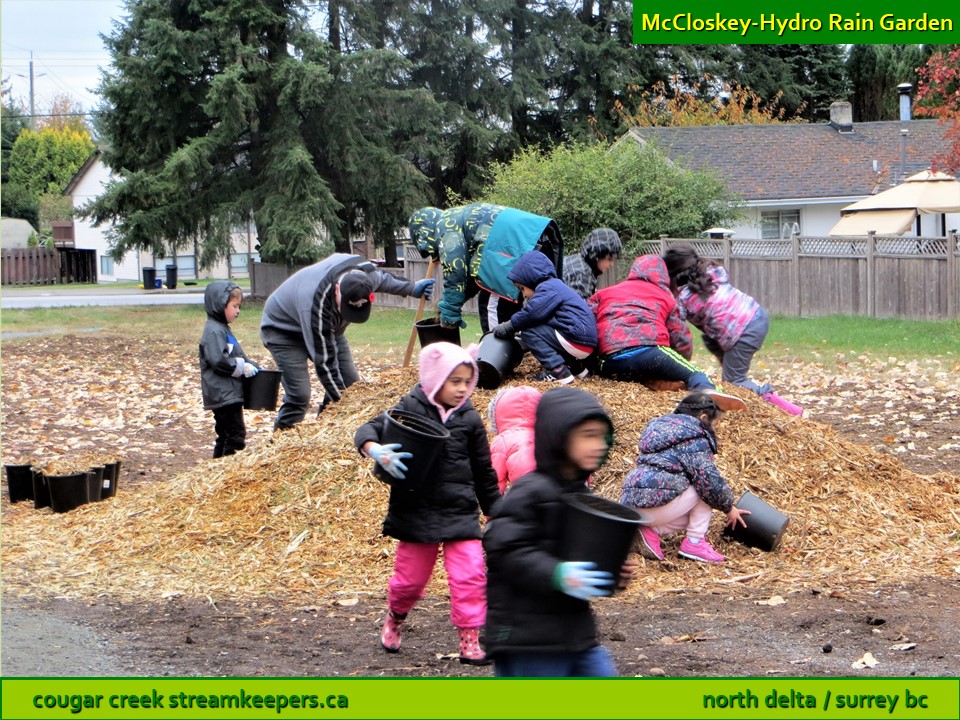

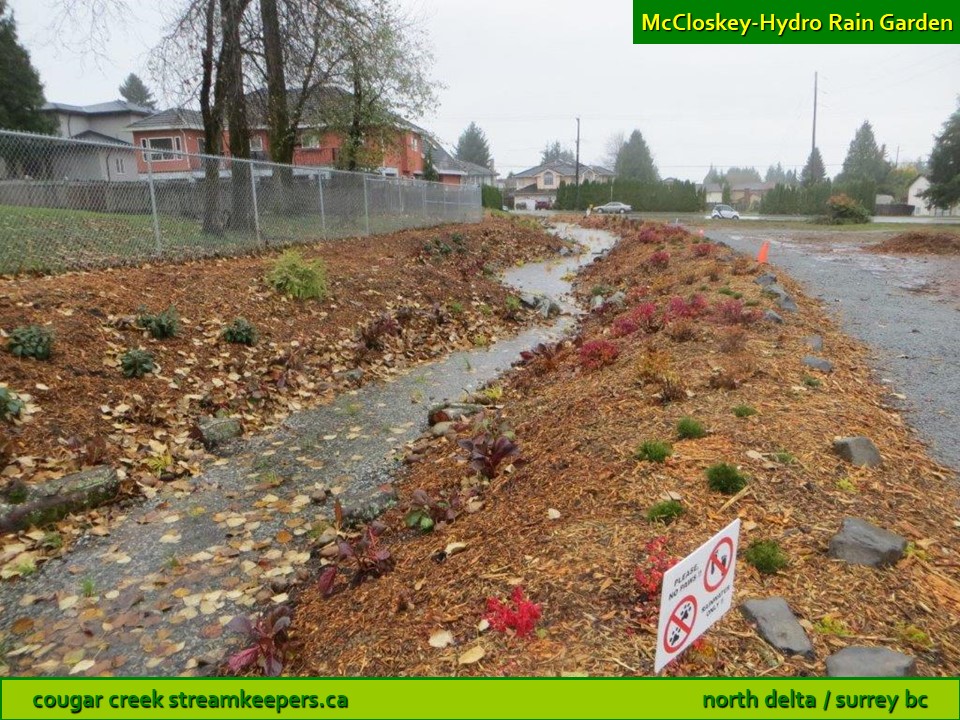



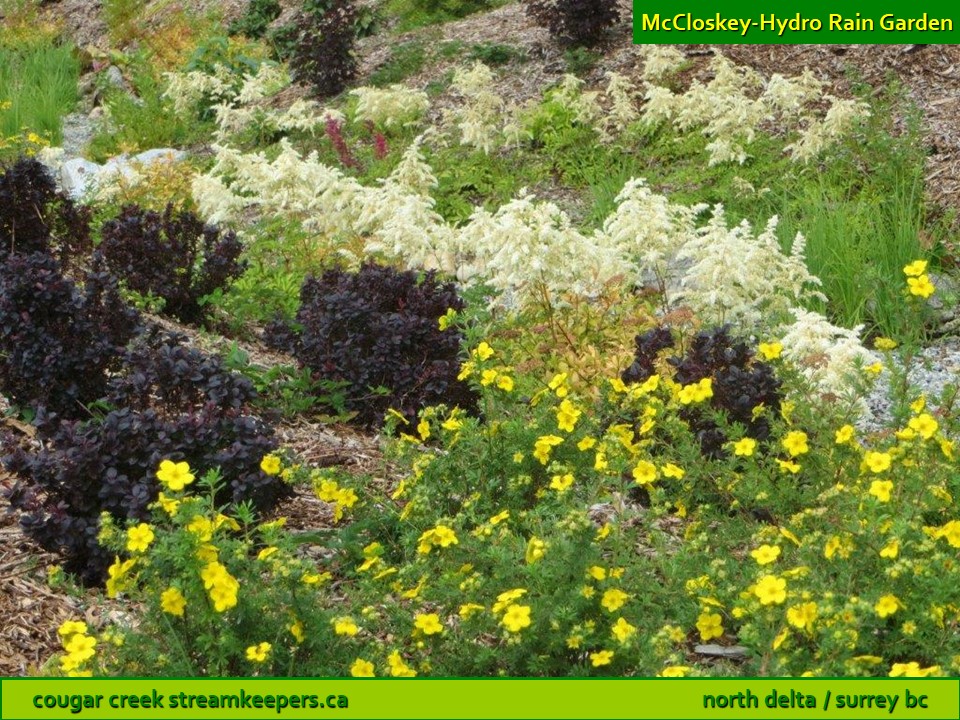
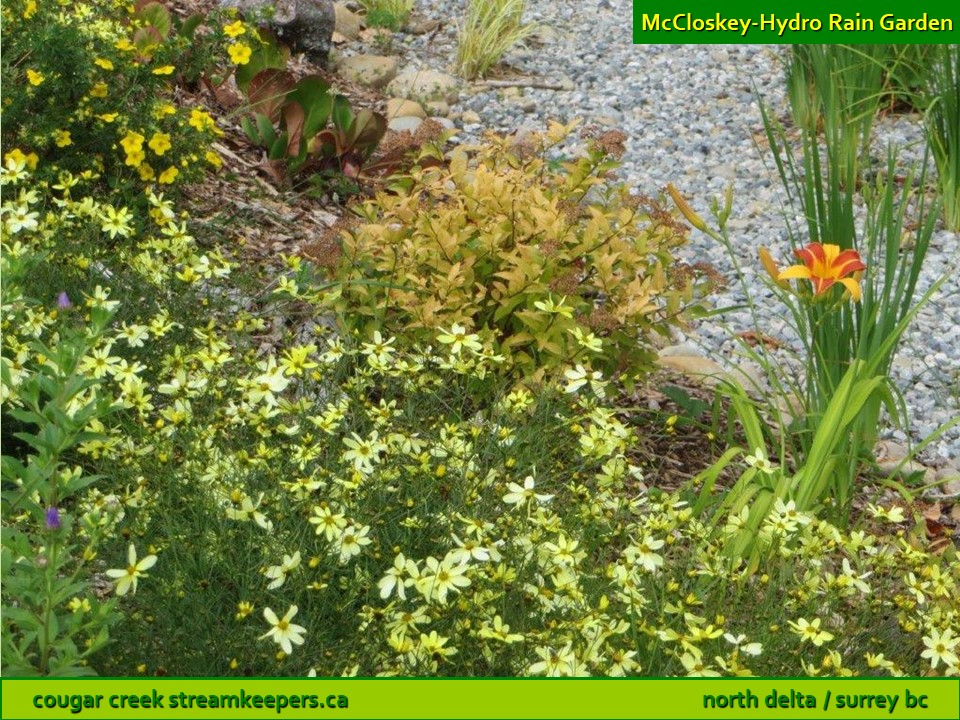
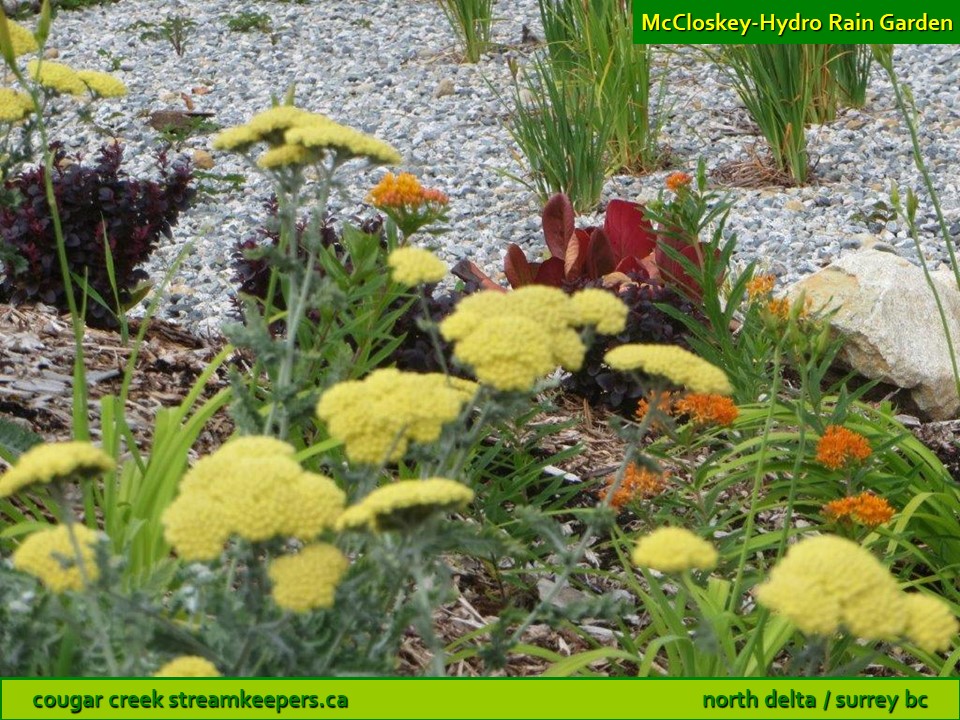




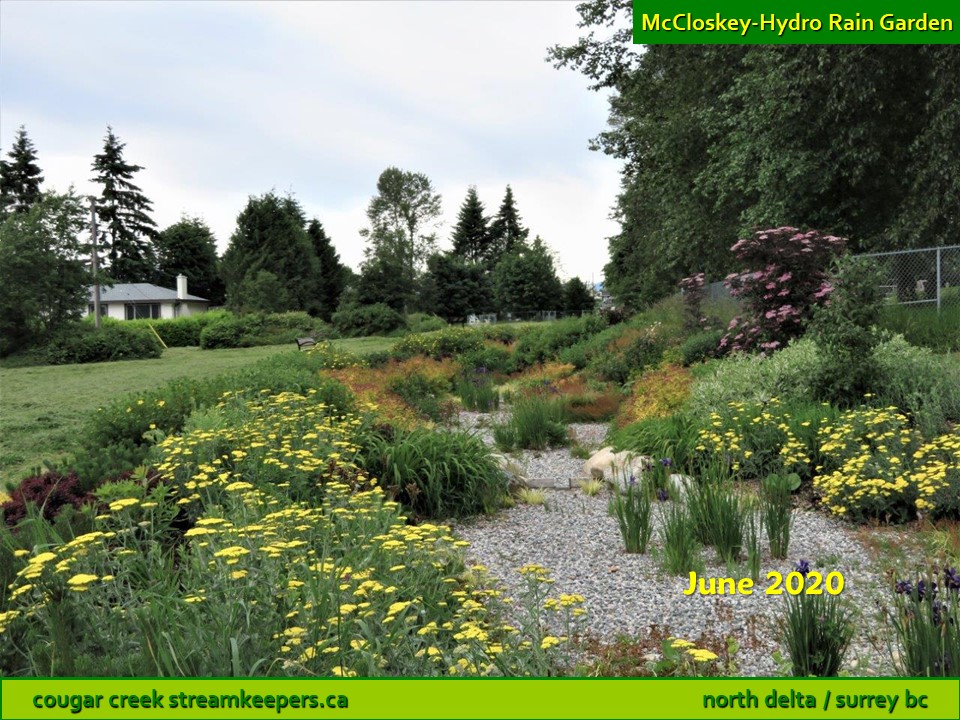

11415 – 84 Avenue, North Delta
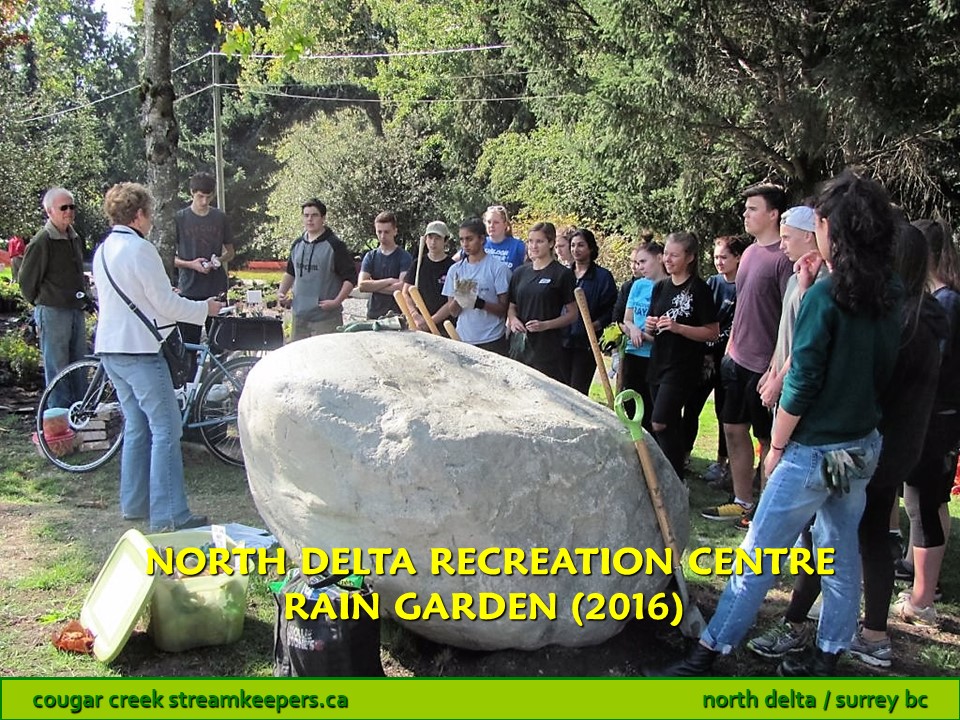
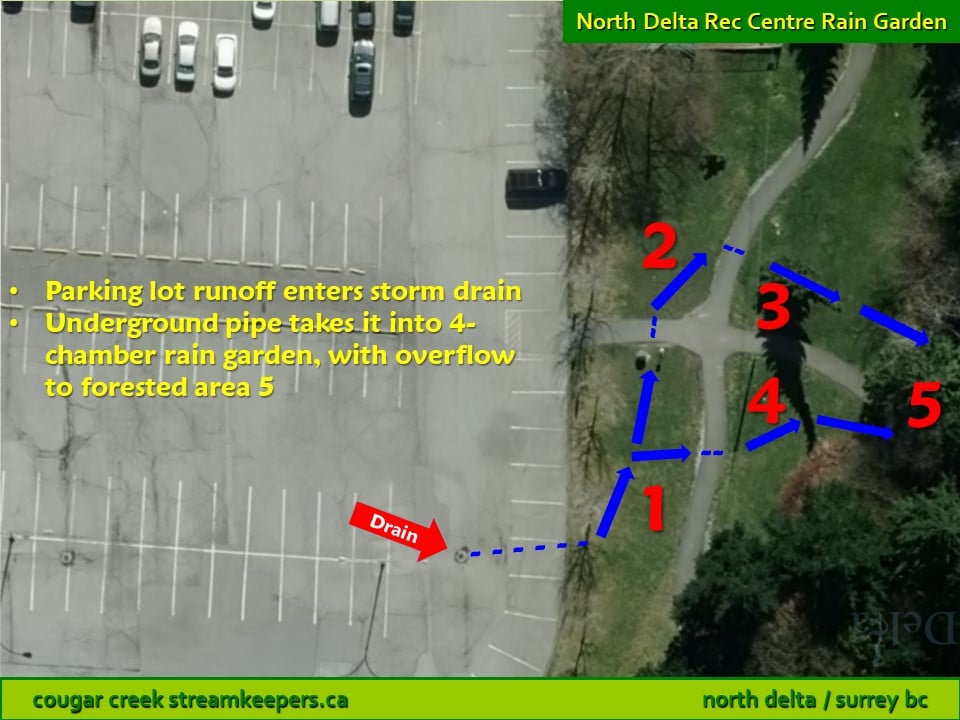

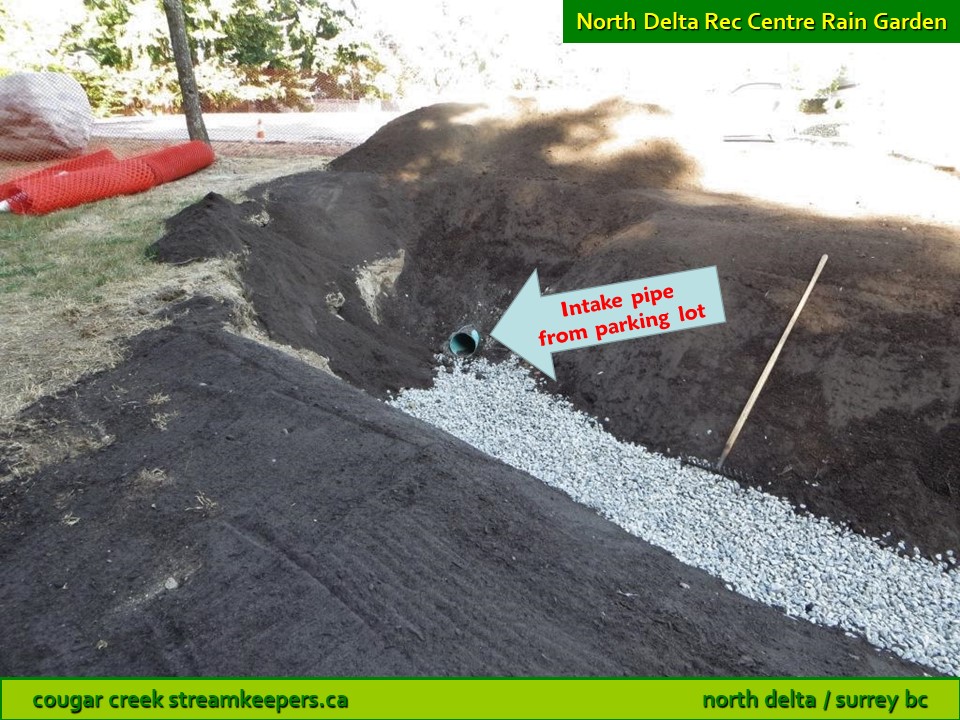
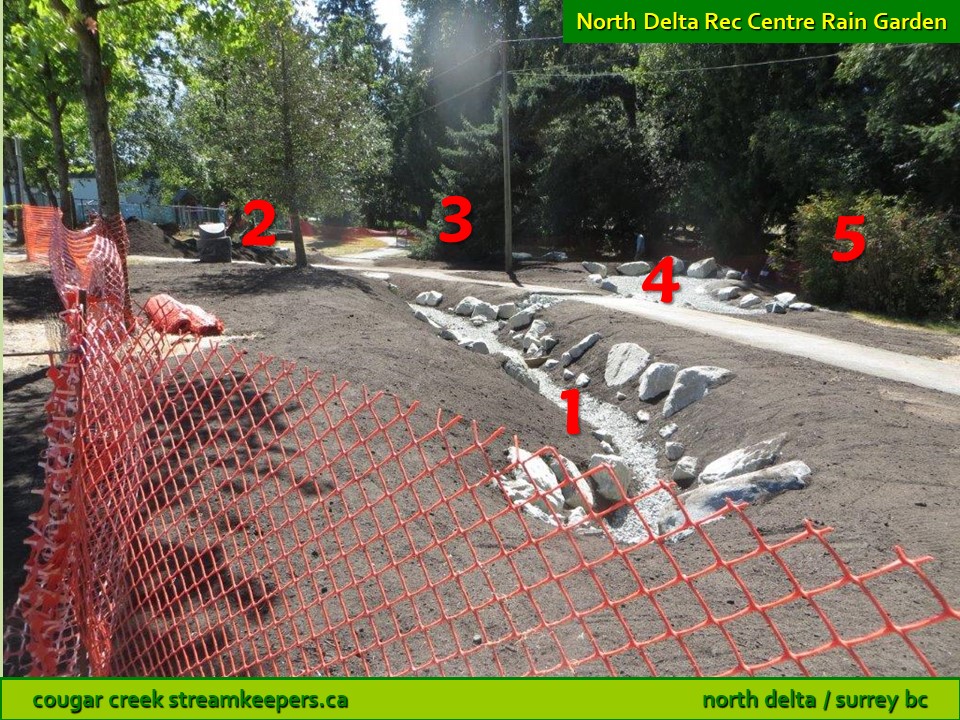
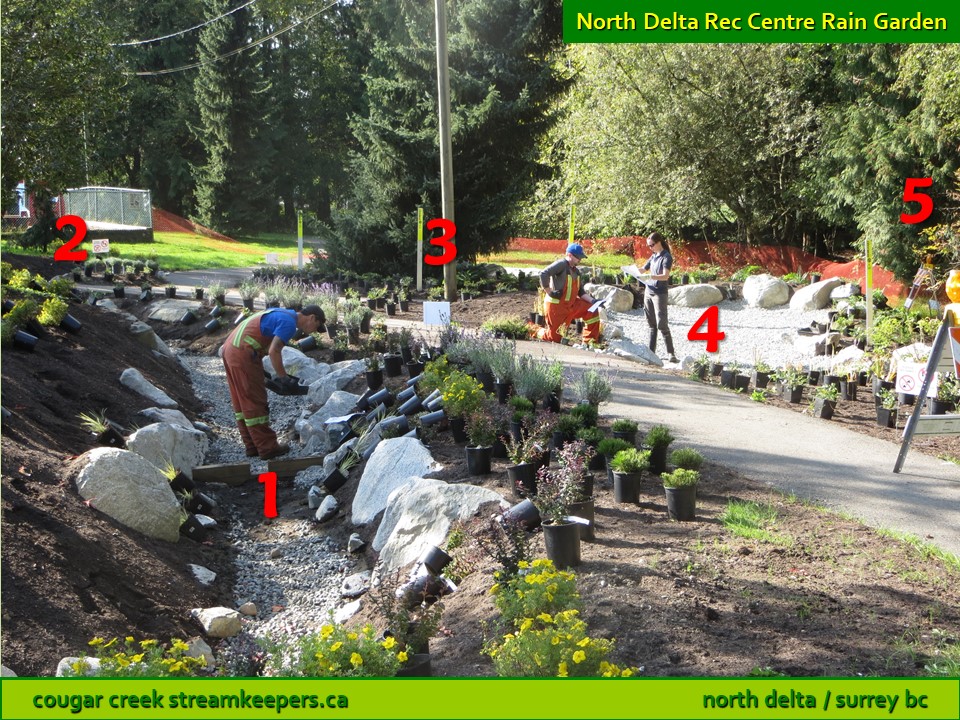

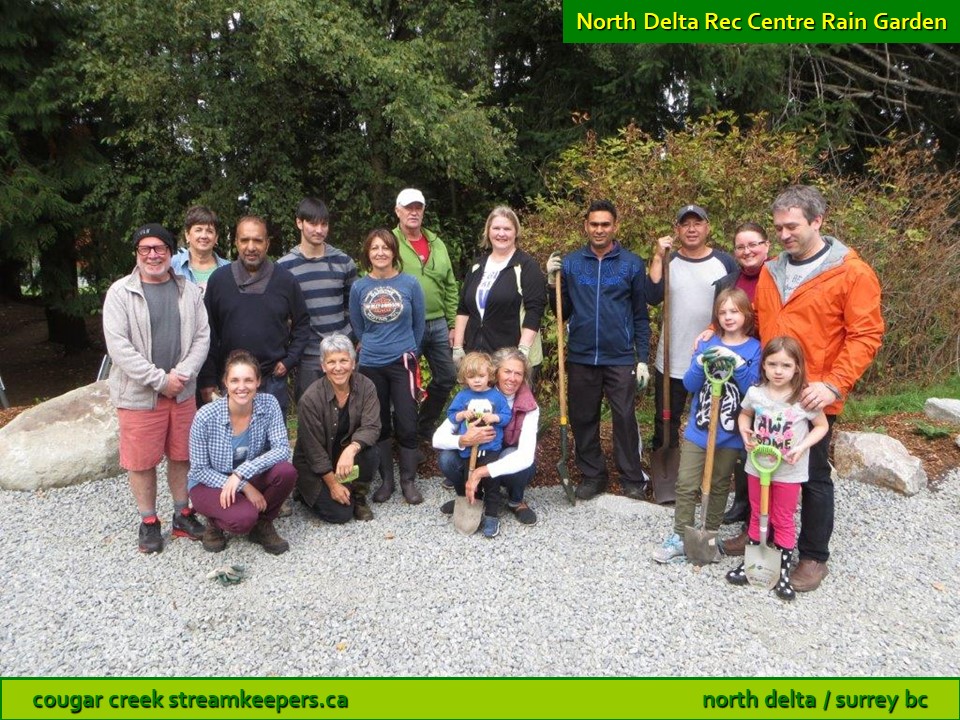
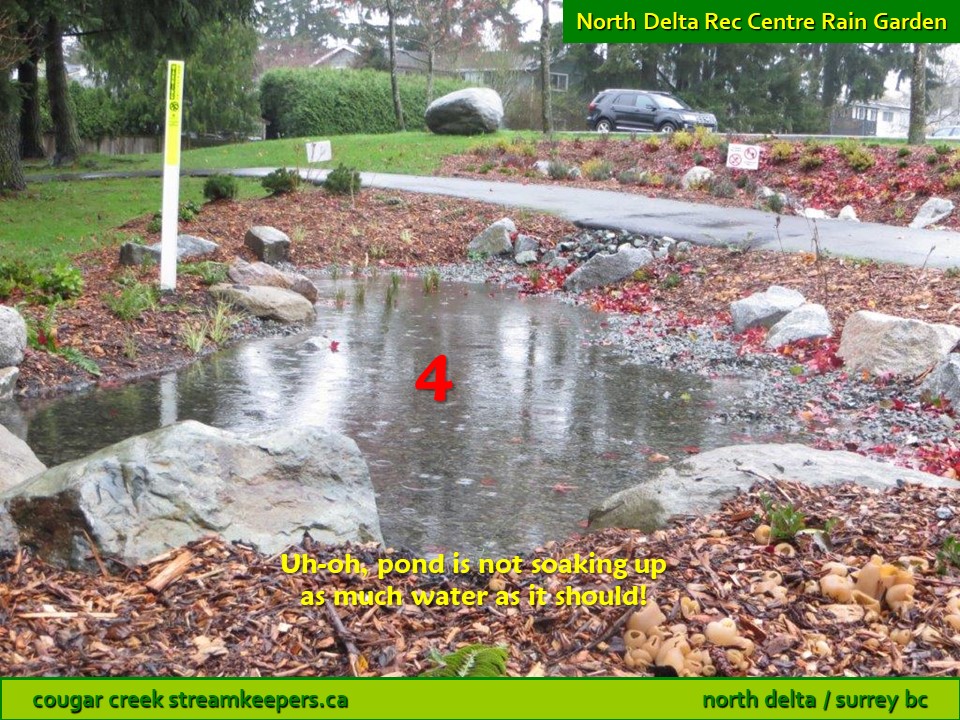
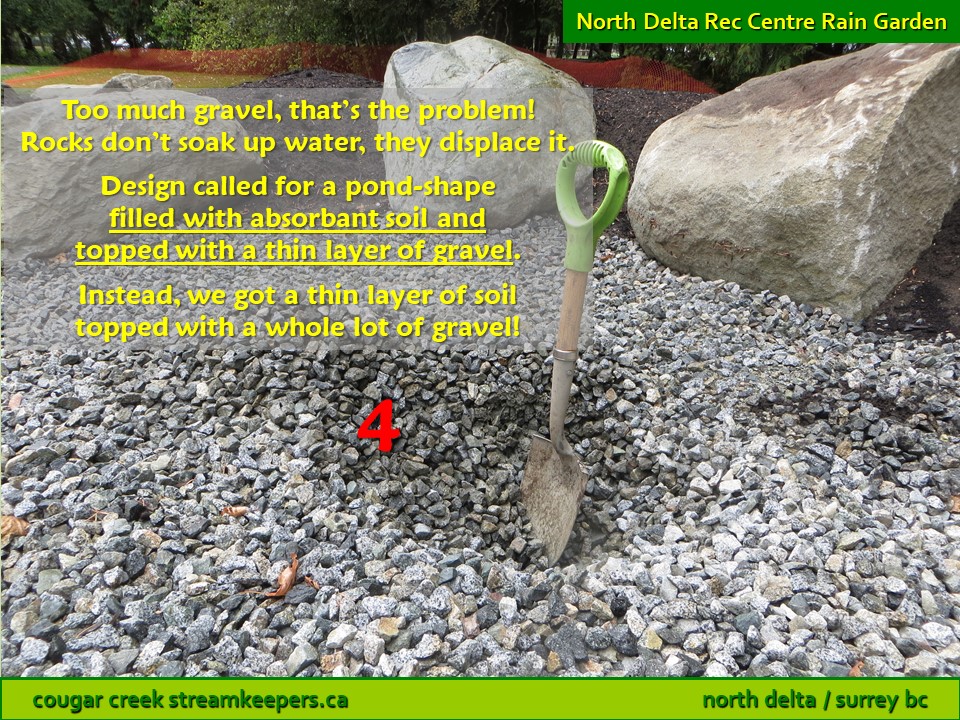
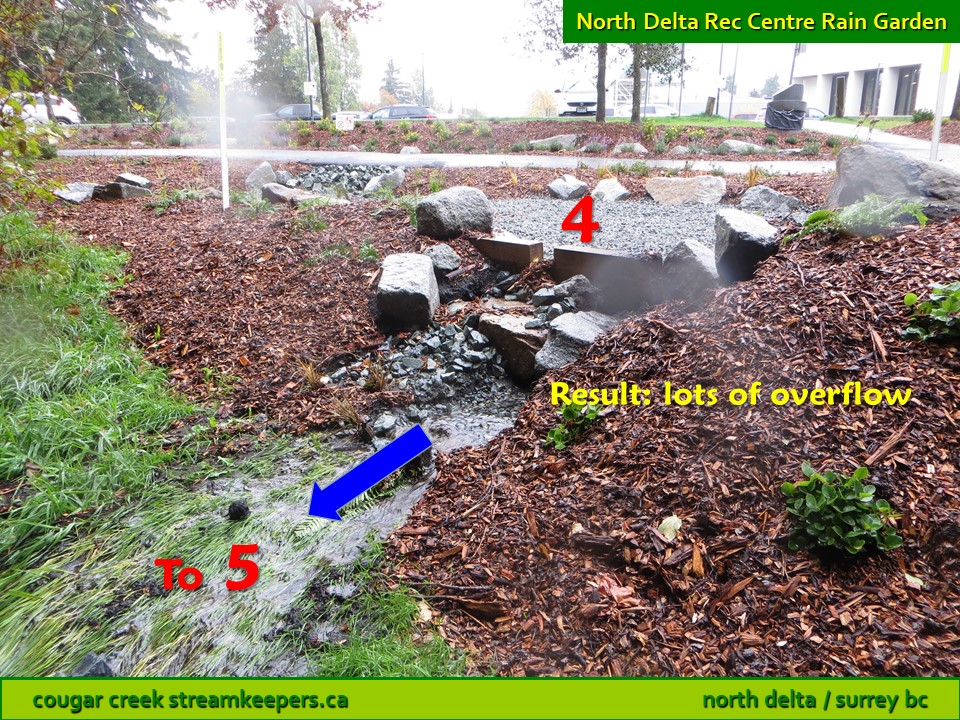


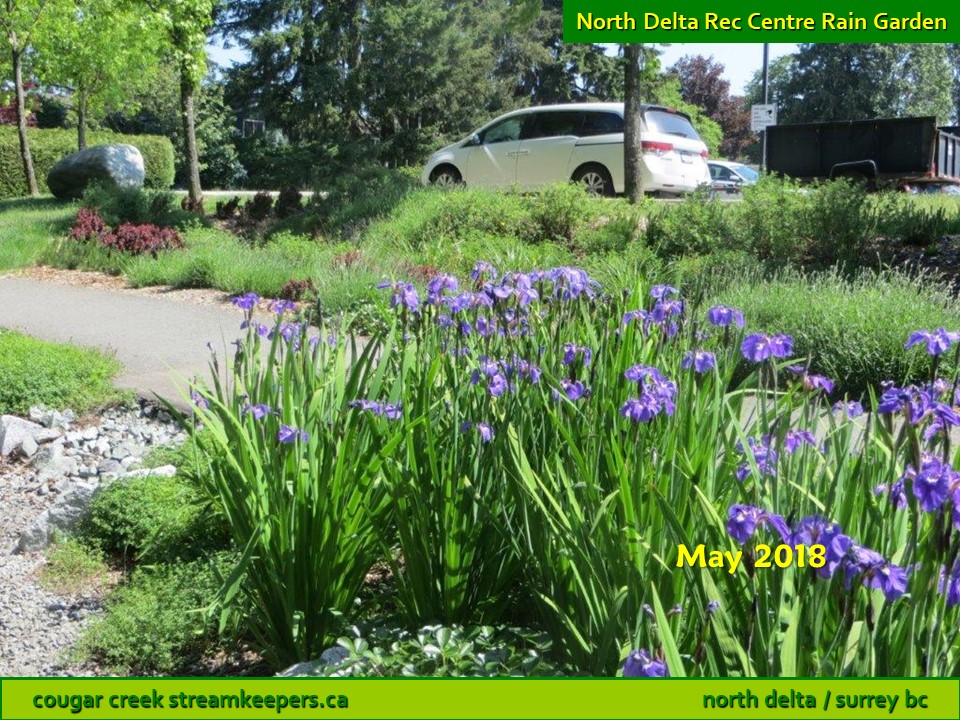



11447 – 82 Avenue, North Delta (garden on 83)
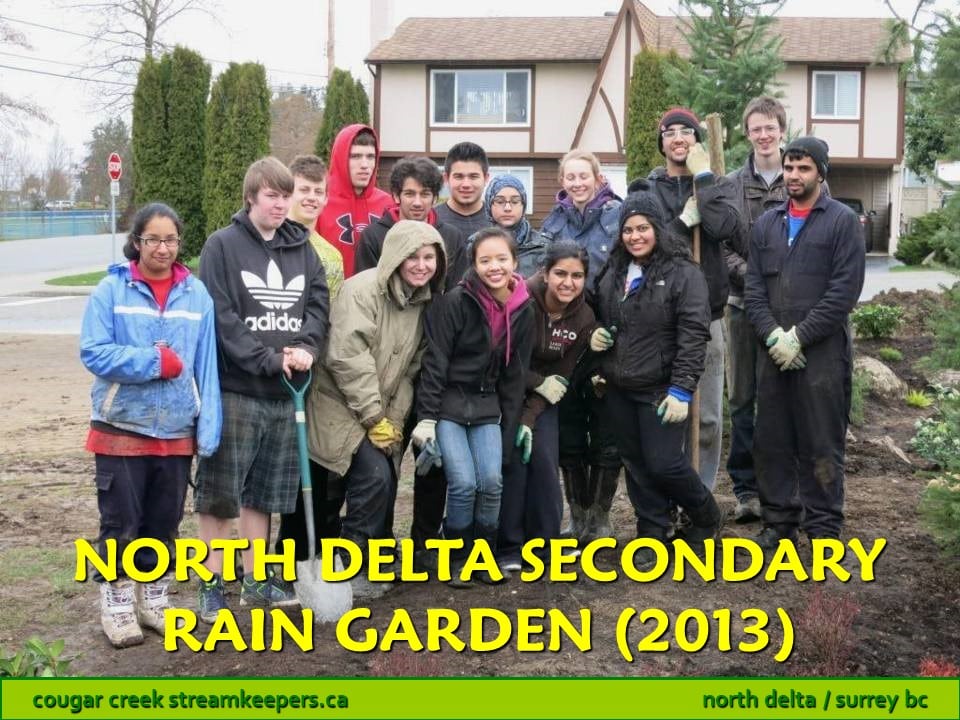
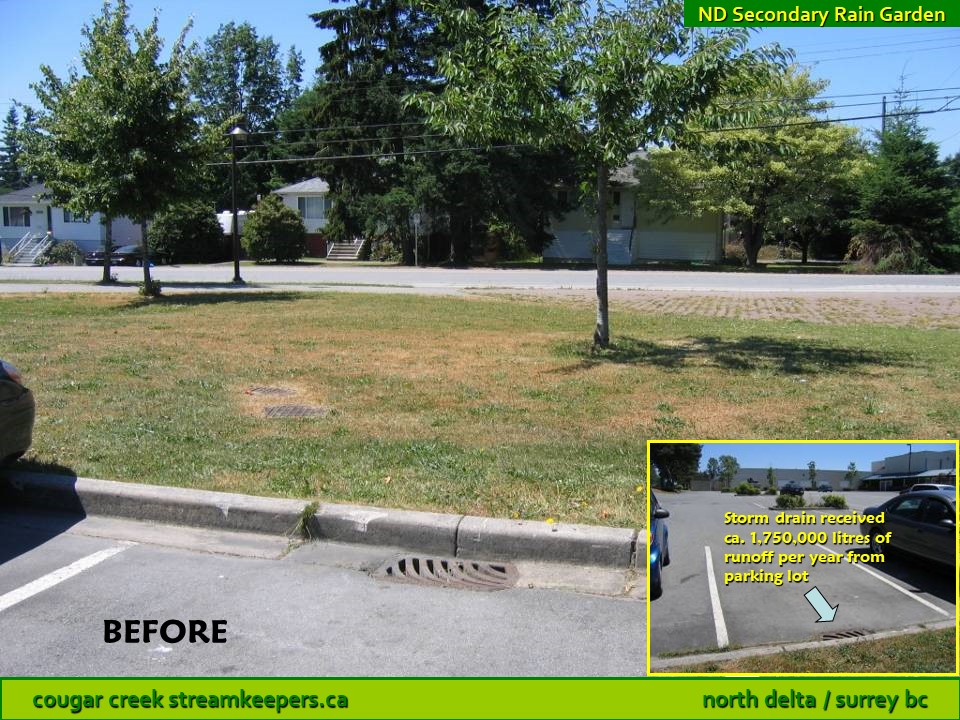



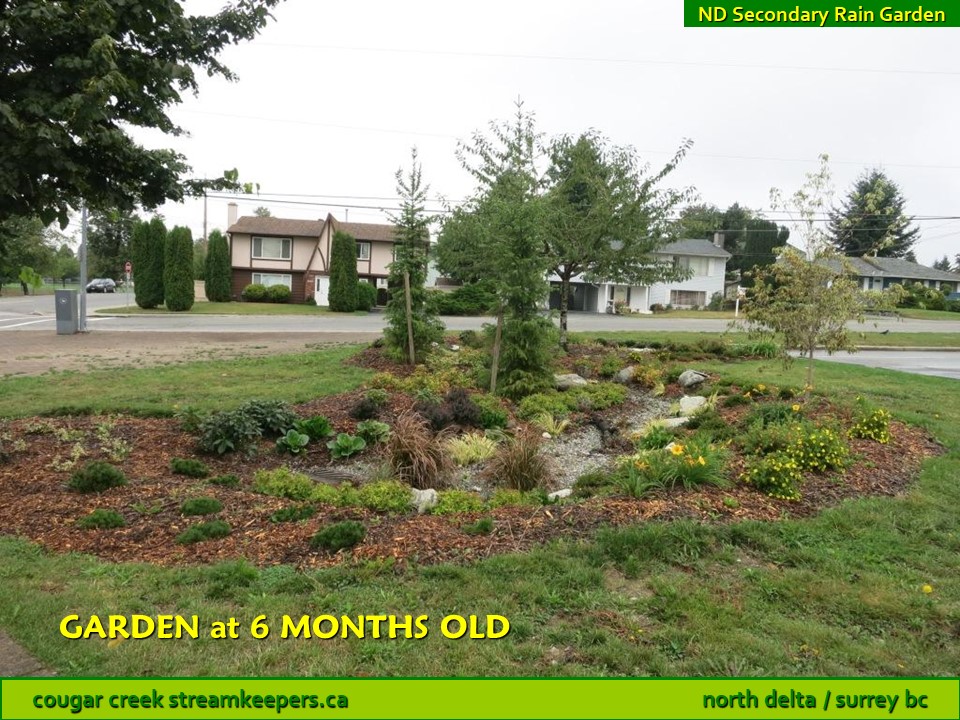


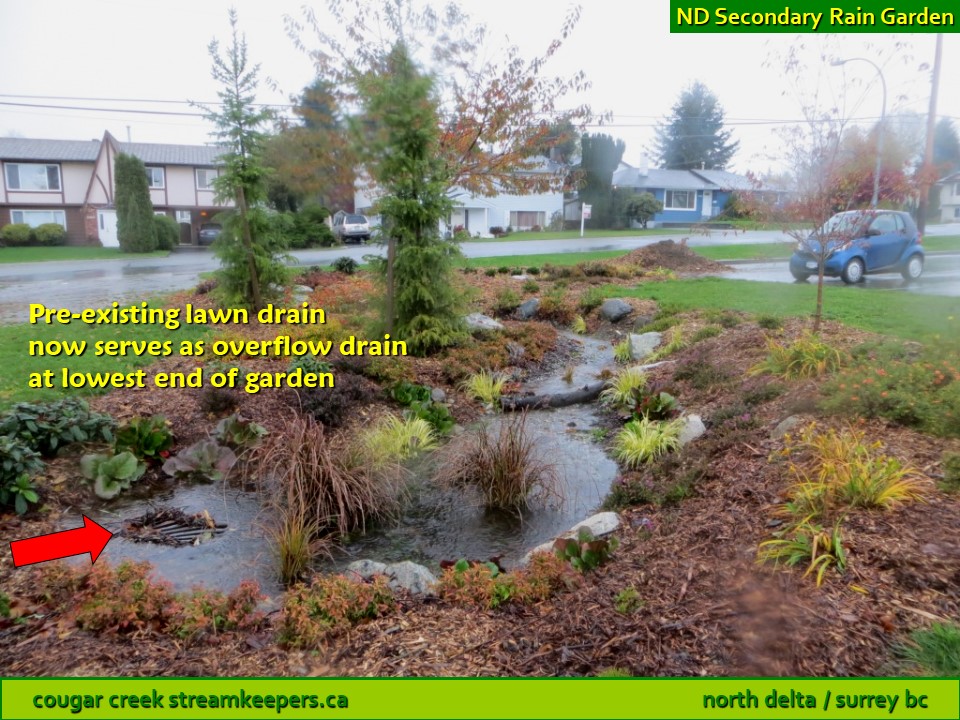
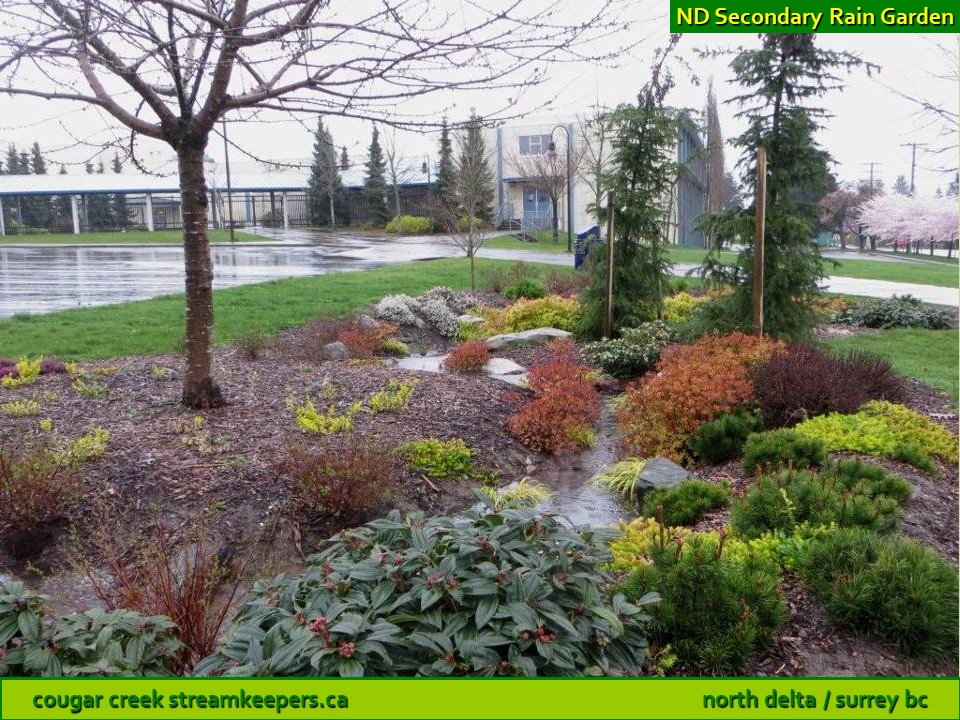
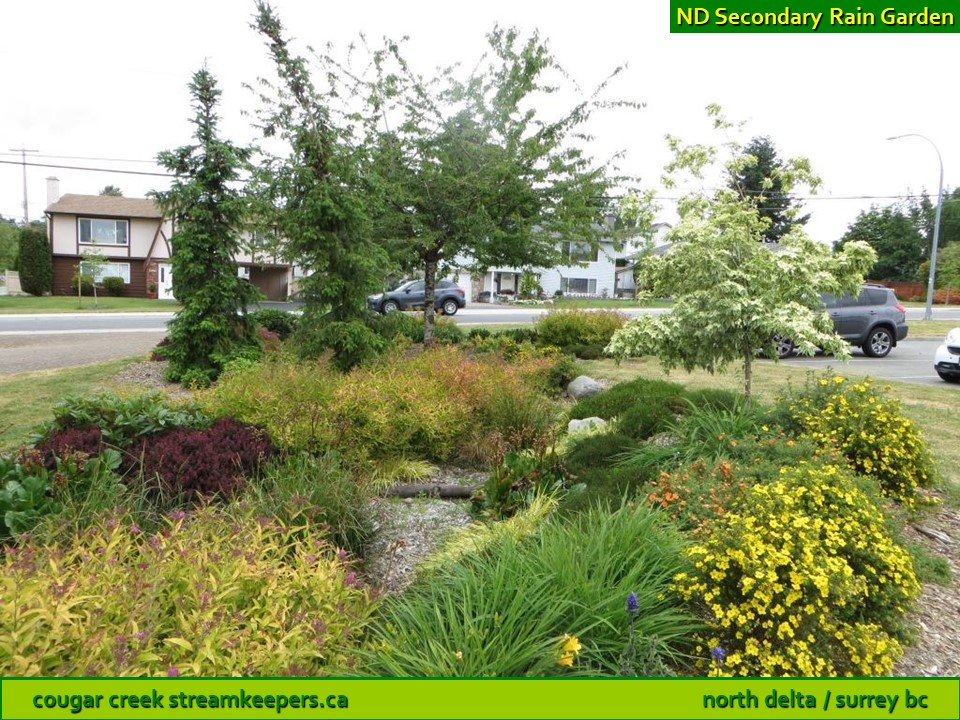
Perfect location, enthusiastic students
It’s rare that a rain garden “retrofit” meets with such ideal circumstances as at North Delta Secondary. There, almost the entire 83rd Avenue parking lot tilts to one corner of the lot, which just happened to abut a large expanse of grass, which just happened to have a storm drain already located within it. Perfect recipe for a meandering rain garden, with curb cut water intake at the highest end and the pre-existing storm drain at the lowest end, for emergency overflow if needed.
Enthusiastic student members of the school’s environmental club, and their equally enthusiastic advisor Robert Buchanan, applied for and received a Nature Trust Rain Garden Grant, negotiated with Delta School District to do the excavation and rough earthwork, did additional earthwork themselves, and then planted and mulched the garden in record time.
During heavy and/or extended rainfall, the young garden took in more parking lot runoff than it could absorb; much excess water overflowed down the storm drain. As it has matured, it has performed better and better – a feature of rain gardens that is in marked contrast to “built” infrastructure, which tends to decline over time. And of course the garden provides beauty and habitat as well, which no stormwater pipe can do.
11300 – 84 Avenue, North Delta
















“Youth Explosion”
Every summer for many years, North Delta Evangelical Free Church (now called Northside Community Church) organized a “Youth Explosion” week, during which young church members performed various social and environmental services throughout the community. In 2009, Cougar Creek Streamkeepers gave each NDEFC youth volunteer a copy of our book Lawrence and the Rain Garden, in thanks for their help with litter pickup and invasive plant removal along the creek.
The next spring, they were planning a rain garden of their own, in the church parking lot!
Perfect location
As luck would have it, the NDEFC parking lot offered a near-perfect setting for a rain garden. The entire lot drains to a single corner immediately adjacent to a wide boulevard strip that slopes gently downhill for a long block.
An existing storm drain wasn’t managing to capture all the parking lot runoff anyway, due to uneven settling of pavement, so the corner had become a rather ugly and puddly affair – but that drain could at least serve as a safety overflow in a new rain garden.
Dig-it-yourself project
Delta Engineering was not in a position to spend public funds on a project on private property (the parking lot is entirely church-owned, though the boulevard strip is Delta’s). The youth group applied for and received a small grant from The Nature Trust of BC’s Rain Garden Fund.
Then — flexing their muscles from summer’s Youth Explosion week — the kids did all the work themselves over 3 wet days in March 2010.
They jackhammered blacktop and excavated with shovels. They screened rocks from the excavated soil, then mixed that soil with trucked-in composted green waste from the landfill. They backfilled the excavation with the improved soil mixture, and used screened rock as top dressing for the garden.
And they planted. That was the easy part!
Delta Eng Ops helps out
The garden proved to be a great success, but far too small in proportion to the size of the parking lot. Water could safely overflow right down Delta’s grassy boulevard, where it was soon absorbed without a trace. Still, an expanded garden would look and perform better …. right?
Happily, Delta agreed. In August, Engineering Operations (Eng Ops or “N Jops” as we call them) sent out a crew and heavy equipment, to enlarge the excavation and bring in more landfill compost.
NDEFC youth – spared any jackhammering or excavating – were only too happy to do the planting. Their enlarged garden also encompassed a pre-existing boulevard tree that pulled together the whole “look”.
Over the years, some plants have perished in summer drought or winter cold, but overall, the garden has performed extremely well — in fact, better and better every year. (Drains and pipes deteriorate over time; rain gardens ameliorate.) Church members and passersby enjoy the improved appearance of the property, and many still recall the impressive accomplishments of the Youth Group of 2010.
11777 Pinewood Drive, North Delta



















11339 – 83 Avenue, North Delta







“Necessity is the mother of invention” — Aesop
In 2010, Richardson’s Vice Principal – who had previously served as Vice Principal at Chalmers Elementary during installation of the rain garden there – asked Delta and the Streamkeepers to consider a rain garden for Richardson. Space was very limited, but Delta rain garden designer Sarah Howie set to work on shoe-horning an effective garden into one tiny corner of the south parking lot.
She created a spiral design that maximizes the amount of soil-water contact in the garden, despite the tight space. Runoff enters from 2 curbs cuts in the parking lot, and makes its way gradually around the spiral (including a “holding” pond). If the water gets deep enough, it heads down an overflow drain at the very end of the spiral route – but already, sediments and grit will have had a good chance to settle out into the garden (rather than getting dumped into fish habitat).
Planting day
Despite its small size, Richardson Rain Garden easily accommodated the 110 plants provided by Delta. Grade 5s did the planting in mid-October 2011, with help and encouragement from Streamkeepers, Delta rain garden designer Sarah Howie and special guest Delta Mayor Lois Jackson. In no time at all, the garden was finished and ready for action.
A model for commercial parking lots
Even in the absence of trees and large shrubs (not feasible due to garden size and sightlines), Richardson Rain Garden absorbs virtually all the parking lot runoff that enters it; there’s rarely if ever any overflow down the pre-existing parking lot storm drain that is now surrounded by vegetation. It’s an excellent example of what can be done with small spaces. Rather than barricading their landscape islands behind solid curbs, high and dry, designers of commercial parking lots can easily make use of small pockets of landscaping for stormwater infiltration.
Another obvious advantage is that plants do well without need of irrigation or sprinking, because they receive not only the rain that falls directly on them, but also the parking lot runoff. A generous layer of woodchips (3-4 inches) helps retain soil moisture through dry spells.
11584 Lyon Road, North Delta























11584 Lyon Road, North Delta



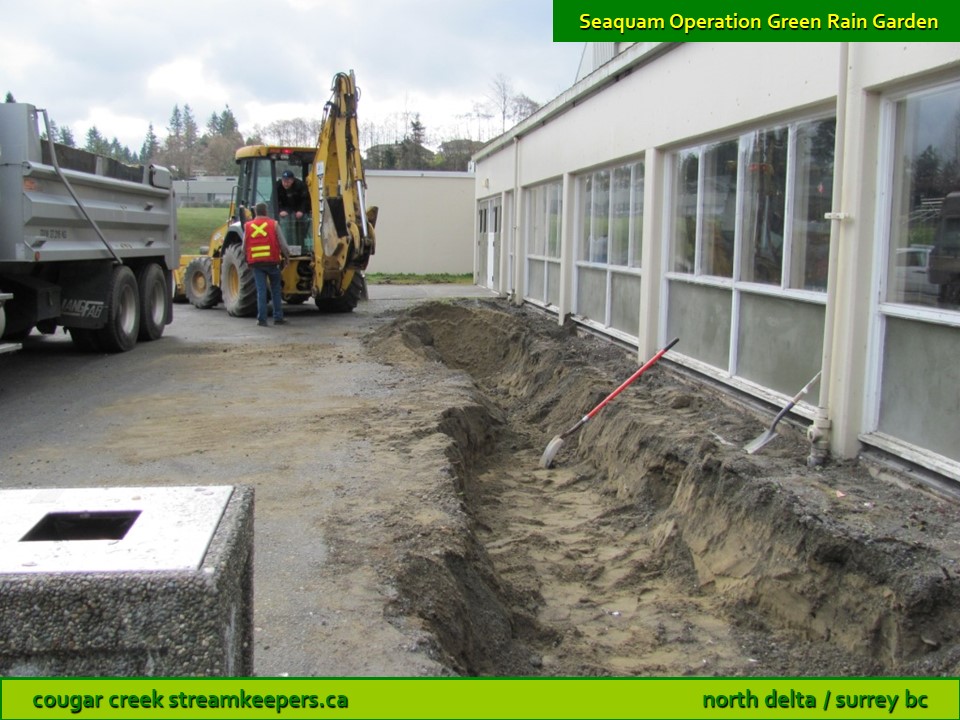
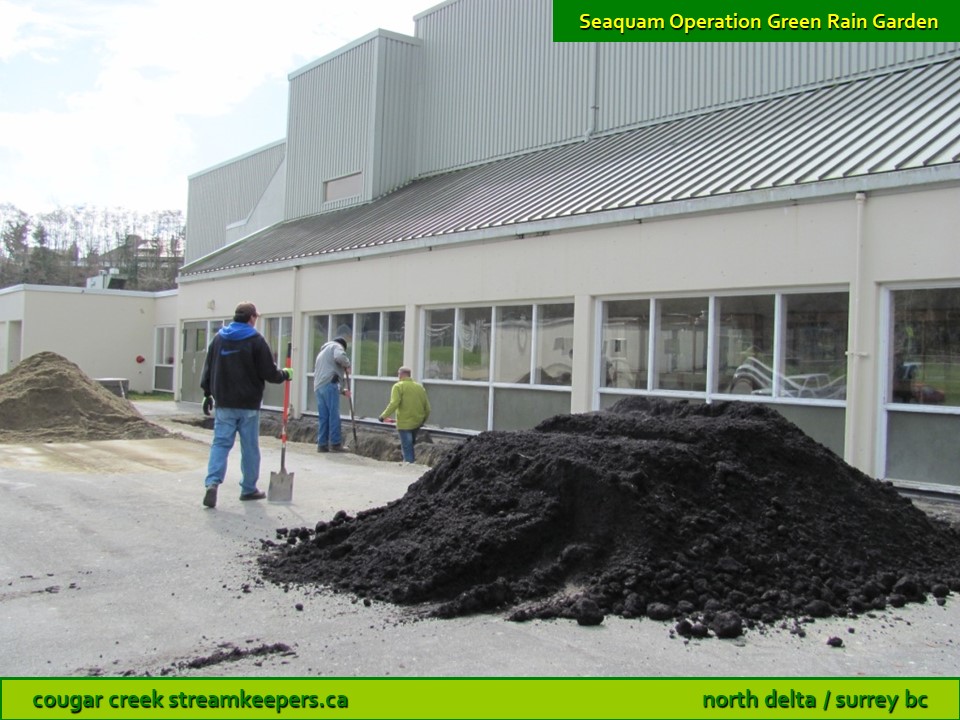




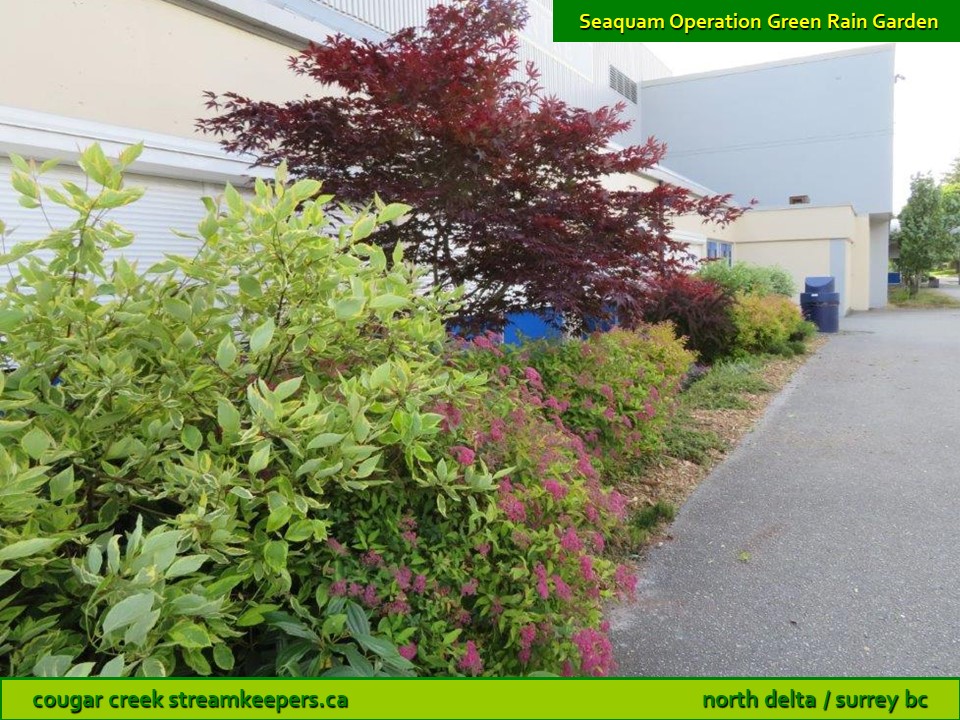
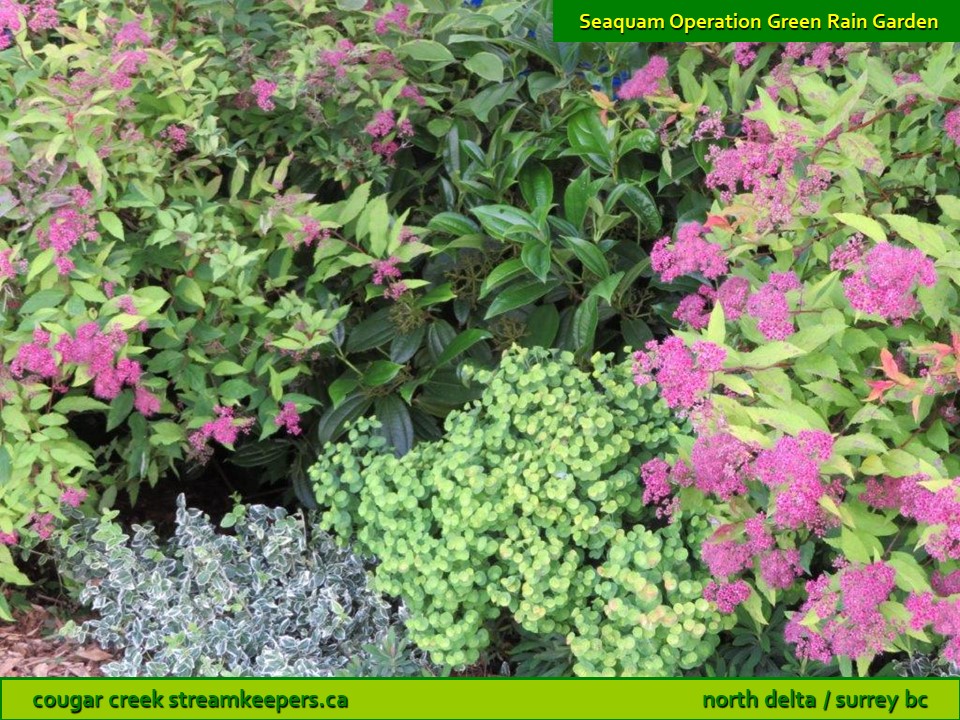
Cougar Canyon alumni plan another rain garden
In Autumn 2010, Seaquam Secondary environmental club “Operation Green” approached Cougar Creek Streamkeepers about creating a rain garden at Seaquam. Some club members were graduates of Cougar Canyon Elementary School (just next door), and were inspired by having planted and maintained the rain garden there.
Excellent site for a “downspout” rain garden
The sloping roof of the Seaquam Athletic Centre foyer offered a perfect opportunity for creating a “downspout” rain garden. The two downspouts from that roof could easily be disconnected from the storm sewer system and aimed into a new sunken garden – which would also serve to beautify a rather industrial–looking façade.
With such an ideal site, and the enthusiastic support of both the Vice Principal and the Operation Green club advisor, Operation Green was able to secure a Nature Trust of BC Rain Garden Grant of $1000 for plants and materials.
Playing in the dirt
A Delta School District crew took charge of excavation and earth work, quickly creating a slightly sunken garden which students then planted, in April 2011.
Looking good … but not (yet) a rain garden
Spring gave way to summer, and then summer to fall, as the garden grew and thrived. However, it was a rain garden in name only – because the roof downspouts remained firmly attached to the storm sewer system that empties directly into Cougar Creek.
Downspouts diverted – now officially a rain garden
Six months after the garden was planted, the understaffed Delta School District facilities maintenance department at last installed 2 classy new black downspouts, with elbows at the bottom to carry roof runoff right into the garden.
As expected, the garden has proven ample for absorbing all the runoff from the roof of the Athletic Centre foyer – nearly 100,000 litres per year. Any water not used by the garden itself soaks down into the groundwater table and seeps slowly underground to the creek, as nature intended.
7815 – 112 Street, North Delta

















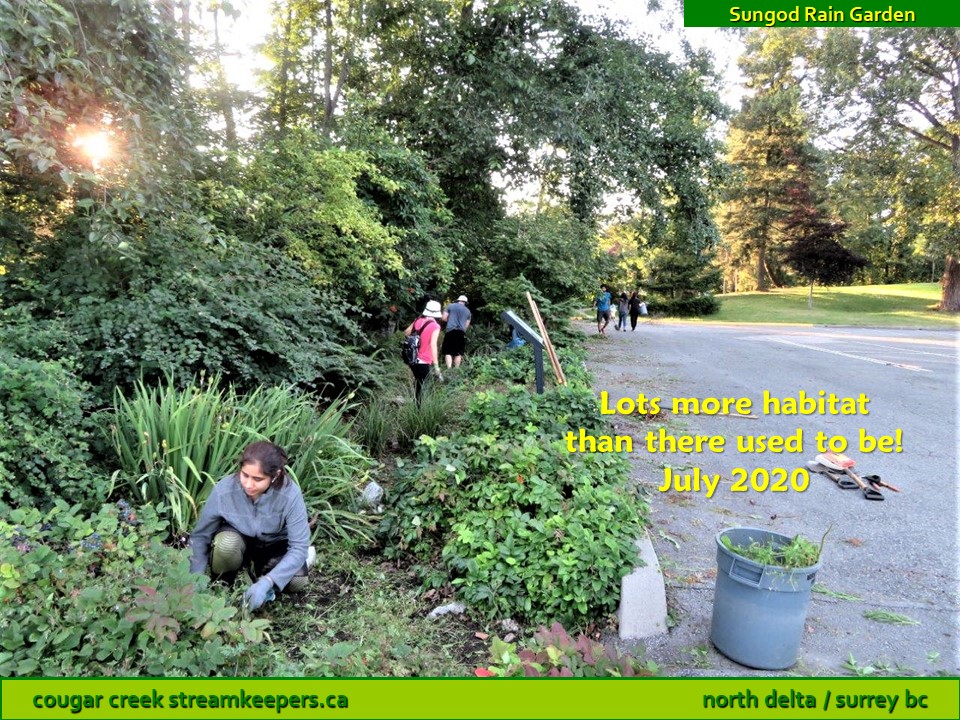
“Why should kids have all the fun planting rain gardens? Let’s get some adults in on the action too!” And thus was born the idea of offering an autumn Saturday morning course in rain gardens, as part of Delta’s Sustainable Gardening series for 2014.
The course consisted of an hour-long colour slide show introduction to the “what, why and how” of rain gardens, followed by planting one alongside the parking lot of Sungod Recreation Centre (where the course was offered).
Delta Engineering had previously completed the excavation and earthwork. While the classroom portion of the course was underway, Delta’s rain garden designer Sarah Howie – with assistance from other Delta staff and Cougar Creek Streamkeepers — positioned the plants in the garden. All that remained was for the 9 course attendees to troop outside and plant.
They went to work with enthusiasm, finishing the job in just a little over an hour. And that included mulching the entire garden with woodchips!
Sungod Rain Garden features all native plants, to blend in with the existing natural vegetation on the perimeter of the parking lot. Prior to development, this area of North Delta was forested wetland – a perfect location for a native-plant rain garden to enhance the health and functioning of the remnant ecosystem adjacent to it.
11285 Bond Boulevard, North Delta

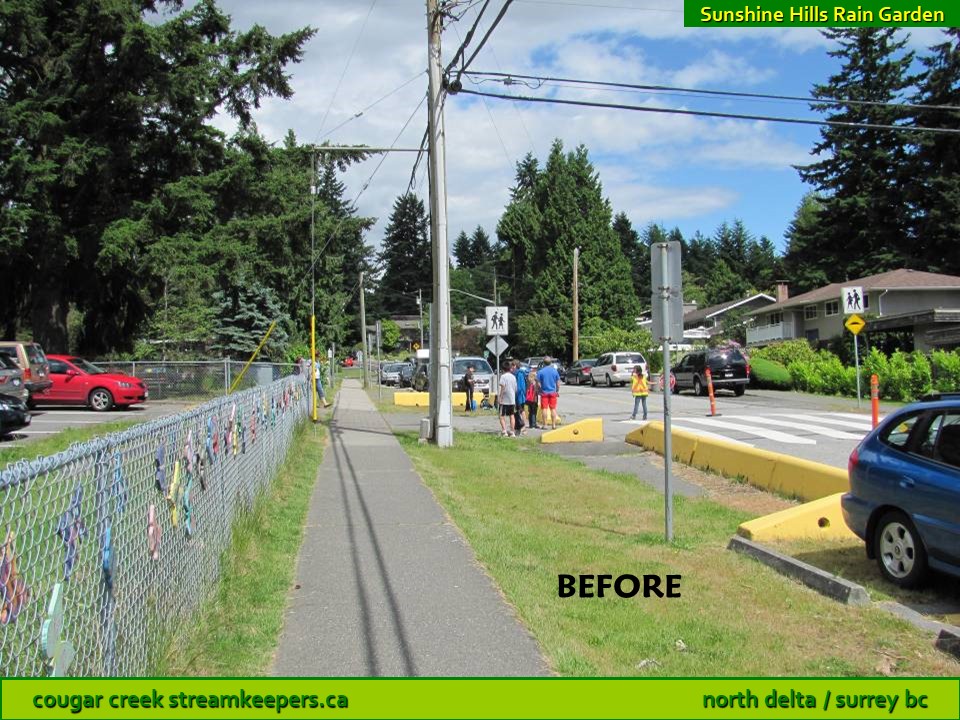
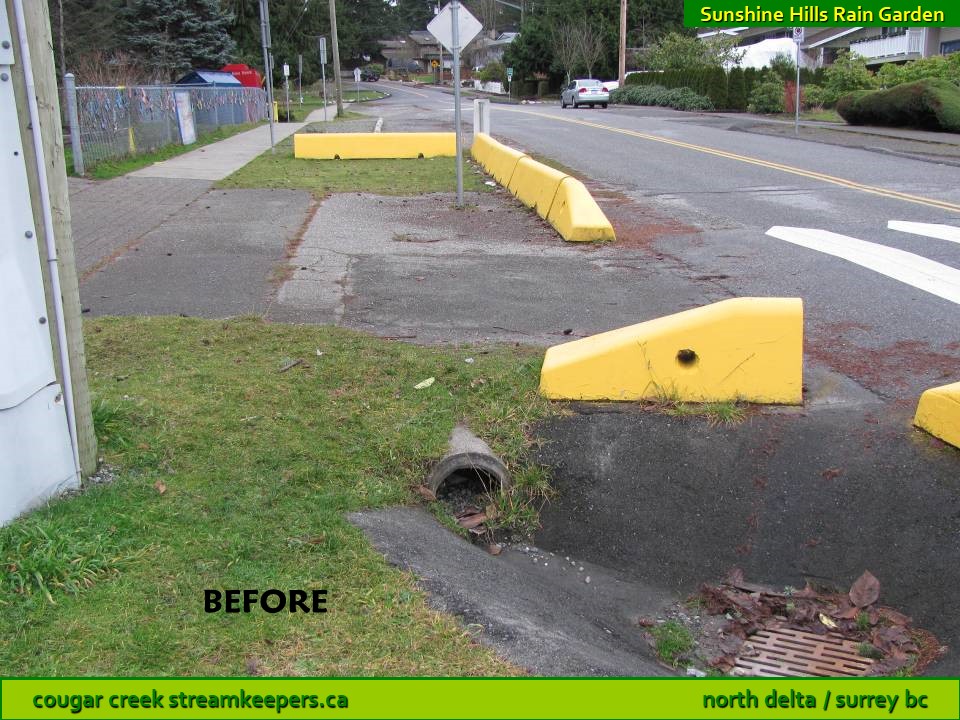



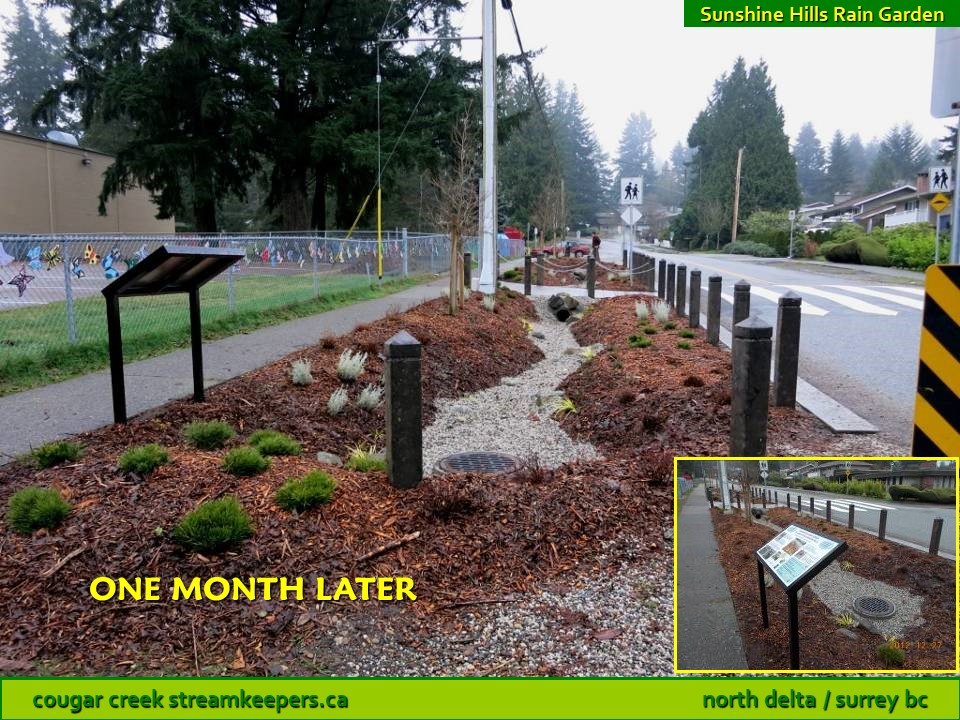





Sunshine Hills Elementary School drains to Watershed Creek – where hundreds of North Delta families gather annually on a Sunday in April, to release chum salmon.
The school’s 2-part rain garden not only contributes to better water quality in Watershed Creek, but has also greatly improved the appearance of the Bond Boulevard entrance to the school. Students, staff and visitors are no longer greeted by an ugly patchwork of drains and concrete traffic barriers, but instead by a tapestry of mugo pines, lavenders, potentillas, pinks, dwarf berberis and more.
A generous and imaginative neighbour has volunteered as “Rain Garden Team Captain” for the 4-student teams that take turns maintaining the garden. From weeding to bug-watching to aromatherapy, the students are learning the joys of gardening and nature – as well as a practical and inexpensive way to manage some of the large volume of stormwater runoff generated by Bond Boulevard.
River Road at Alex Fraser Bridge, North Delta








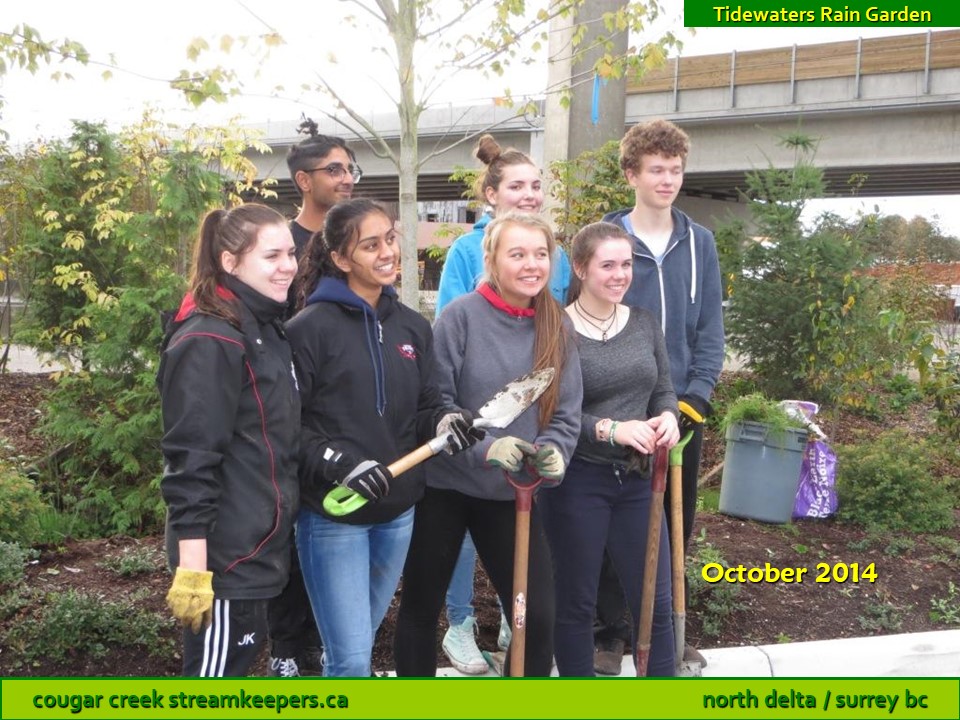

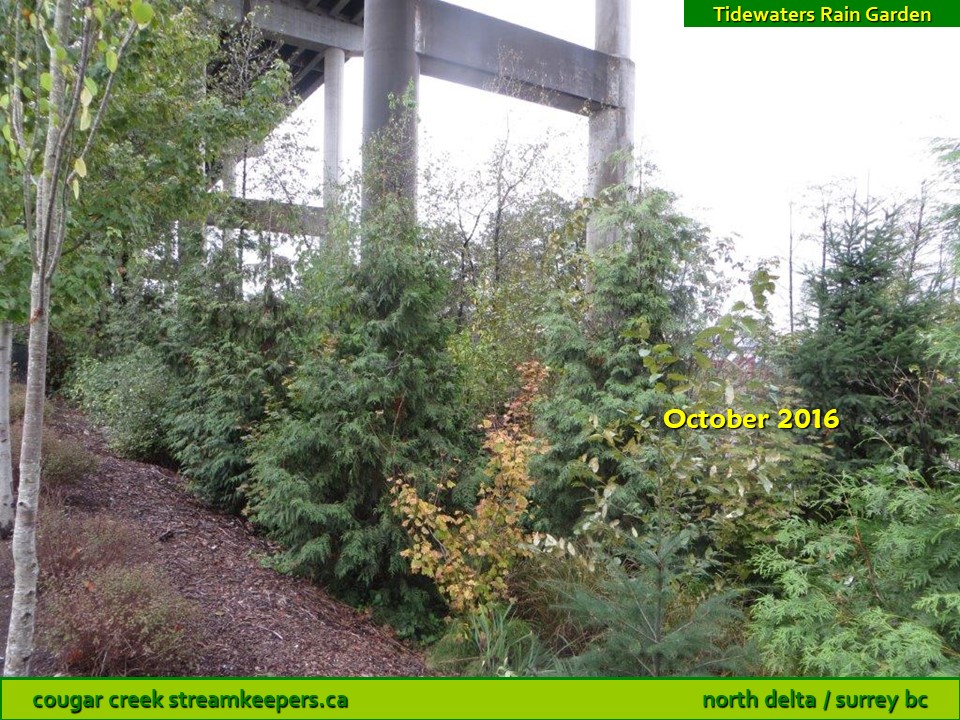





Burnsview Secondary students take on SFPR mitigation projects: Phase 2
Students of Danick Benoit’s Environmental Science class at Burnsview Secondary School in North Delta suggested the creation of a park on the Fraser River shoreline, just east of the Alex Fraser Bridge, as an environmental mitigation measure for the South Fraser Perimeter Road (Highway 17). The site they had in mind had in fact already been earmarked for just such a park, the St. Mungo Recognifition Site (honouring First Nations and fisheries history).
So instead, the students took on a 2-phase rain garden project, financed by SFPR and with technical assistance from Cougar Creek Streamkeepers.
Phase II, Tidewaters Rain Garden, takes its name from a popular neighbourhood pub that occupies the private property adjacent to the garden.
Redevelopment of that property (after a fire that destroyed the old pub) provided an opportunity to drain runoff from the building and the parking lot into a long linear rain garden on the adjacent BC Ministry of Transportation property.
Ideally, Tidewaters Rain Garden should have received water via “sheet flow” – that is, water simply flowing off an adjacent pavement (through multiple curb cuts) and directly into a shallow swale.This method of water intake allows for maximum contact between runoff and garden soils & plants, resulting in maximum absorption and filtration. Cougar Canyon Elementary School Rain Garden is an excellent example of this.
Unfortunately, building standards and permits still tend to roll along on auto-pilot – with the result that, in this case, all runoff got piped as usual into a storm sewer designed to link with the municipal storm sewer in River Road. Mayor Lois Jackson and the Delta Engineering Department intervened to get much of that water diverted, via a pipe, back into the rain garden. Very convoluted, and not nearly as effective as sheet flow, since the water enters at a single low point in the garden, rather than seeping in all along the garden banks ….
Nonetheless, as it grows into a small native forest with a lush understory, Tidewaters Rain Garden is making a significant contribution to the health of the lowest reaches of Cougar Creek. In addition, along with its sister project Fraser Falls Rain Garden, Tidewaters has greatly improved the appearance of the Delta Nature Reserve trailhead at River Road – the entrance to an excellent recreational trail system that connects many environmental treasures: Lower Cougar Creek, Burns Bog, Watershed Park, Serpentine Fen, Boundary Bay dikes, Boundary Bay Park in Tsawwassen, and more.
11040 River Road, North Delta

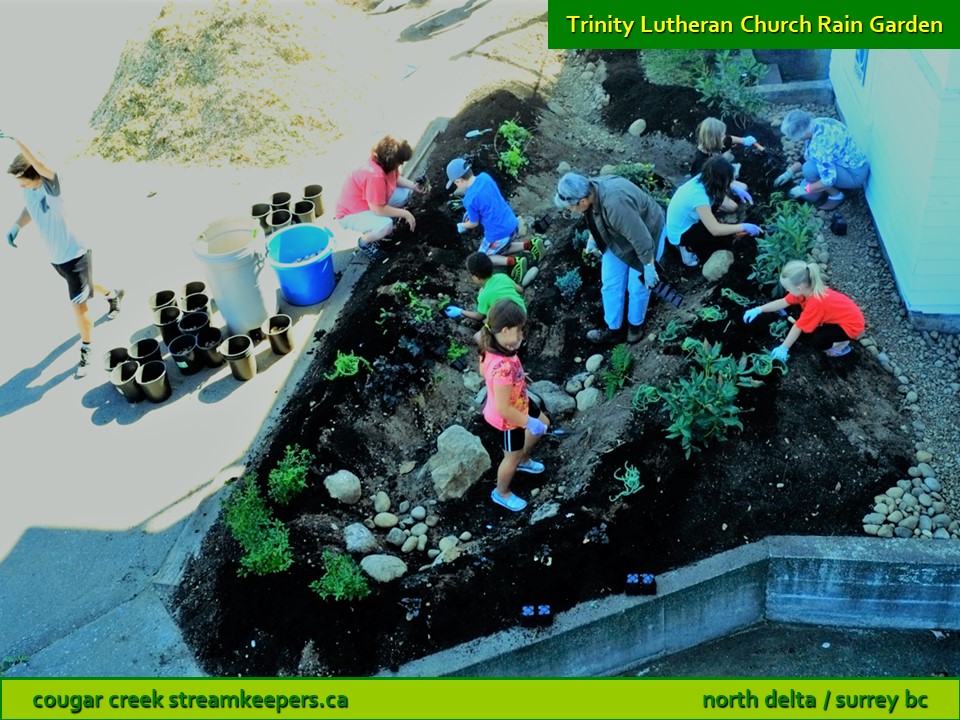
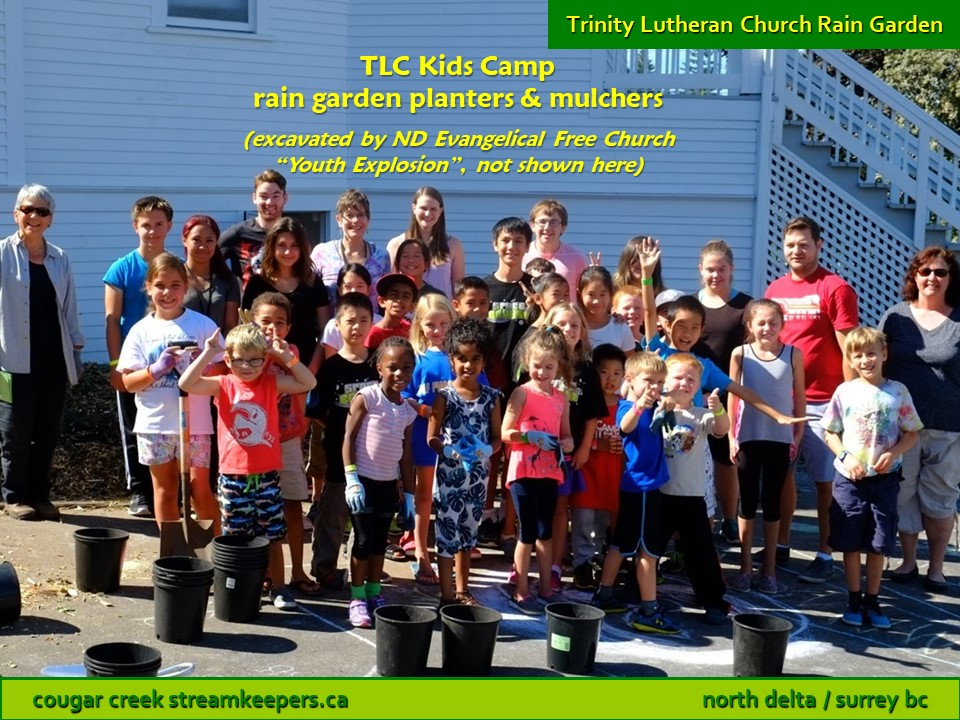
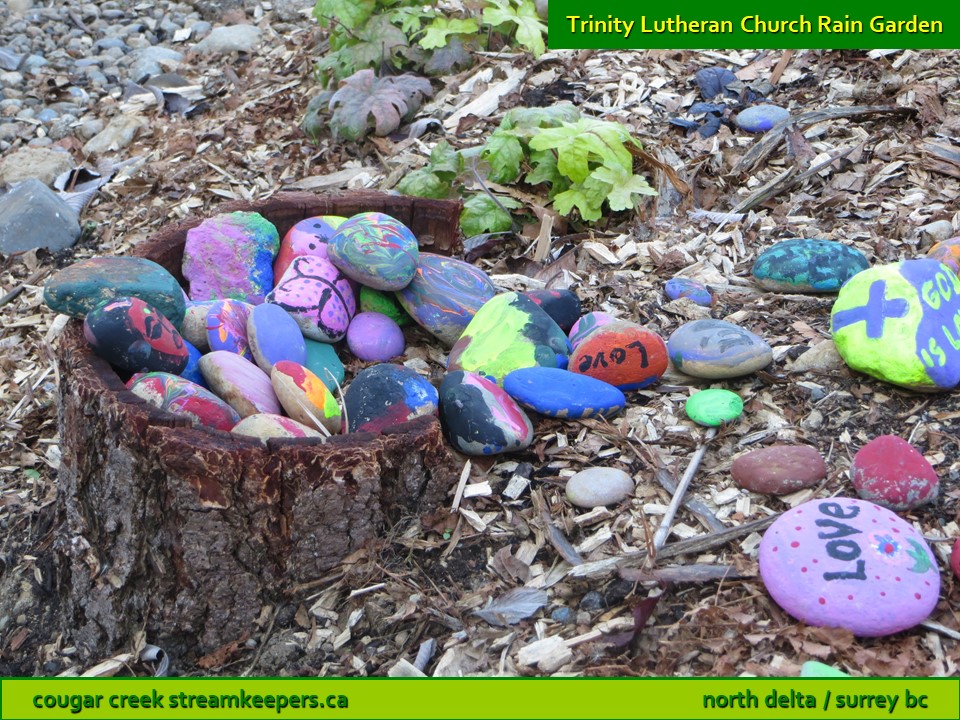
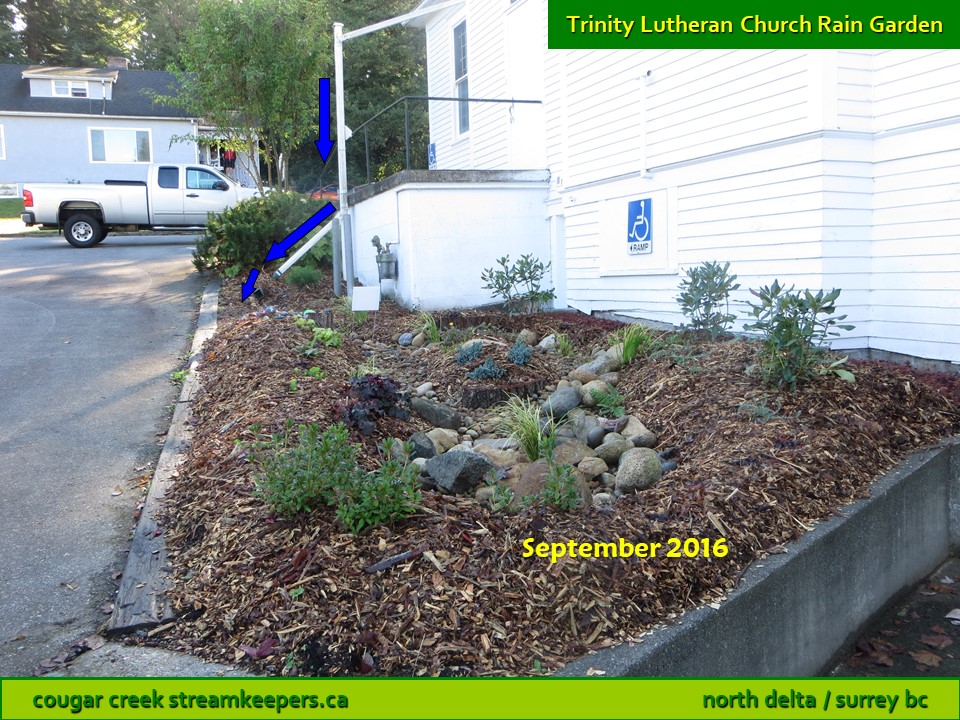





Westview Drive at Cougar Creek, North Delta
















Road to nowhere
On North Delta’s Westview Drive, about a block south of 72 Avenue, a stretch of pavement heads west only to end abruptly at the banks of Cougar Creek. This is what remains of an old service road that used to cross the creek and the Burlington Northern & Santa Fe (BNSF) railroad tracks, providing maintenance-vehicle access to trails, the GVRD’s (now Metro Vancouver’s) sanitary sewer lines and the site of the old Westview Peat Plant.
When no longer needed, the road was literally “chopped off” at the creek’s edge, the culvert removed, and the creek opened up to a more natural condition – a great improvement for fish habitat, but not very attractive.
The site has become an informal parking area, for walkers who access popular creekside trails and the Delta Nature Reserve from this trailhead.
Large-scale engineering and environmental improvements may eventually have to be undertaken in this area, but meanwhile, it cried out for an immediate facelift and some stormwater mitigation, however modest.
A creekside rain garden
No matter where a rain garden may be located, it always serves to remove pollutants and replenish groundwater that eventually makes its way, underground, to a creek.
Westview Drive Rain Garden is Delta’s first immediately-creekside project, whose benefits to Cougar Creek are clearly visible in “real time” during every rainfall.
Large volumes of rainwater runoff from the nearby stretch of Westview Drive used to pour into a standard storm drain, which then fed directly via storm sewer into the creek. Other runoff flowed (and still does) between and under concrete traffic barriers and into the creek.
The old storm drain still receives some runoff, but most is now diverted into one or another of 2 rain garden intakes. Right away, large amounts of sediments are trapped at the intake zones, that otherwise would have gone straight into the creek. (In just 3 winter months, Streamkeepers removed 6 gallons of sediments from the intake zones.)
The runoff then flows through several metres of rain garden, where there’s more sediment/pollutant removal and an opportunity for the water to soak into the ground.
Initially, only small rain events were completely absorbed; heavier rains produced lots of surface overflow into Cougar Creek. Over the years, as spongy sediments built up in the garden, and plant roots became established, water retention improved dramatically. Now only the heaviest rainfalls send so much street runoff into the garden that there’s some visible overflow into the creek.
Many hands make light work
As with Delta’s large roster of school rain gardens, Westview Drive Rain Garden is a product of cooperation:
-
Delta Engineering designed the garden and interpretive signage
-
Engineering Operations did the earthwork and installed bollard-&-chain fencing and new, graffiti-free traffic barriers
-
Pacific Salmon Foundation provided a grant for purchasing plants and signage
-
Streamkeepers coordinated and supervised the planting, mulched with woodchips afterwards and have monitored and maintained the garden ever since.
-
Seaquam Secondary School’s “Operation Green” did the planting – 300 plants in about 1½ hours.
-
Seaquam woodworking students under their teacher Bill Ng, and with financial assistance from Quadra Inc, provided an information kiosk for the trailhead — a welcome addition for bewildered non-locals wanting to explore Delta Nature Reserve.
Countless walkers, many with their canine pals, now pass between the upper and lower chambers of Westview Drive Rain Garden, on their way to the Delta Nature Reserve. Many have complimented the great improvement in aesthetics, and are pleased to learn that it’s an environmental improvement as well.
Visit Westview Drive Rain Garden in the rain! Watch how it functions, read the interpretive signage, and imagine how you too might retain and infiltrate rainwater on your own property, to help reduce pollution and erosion of local creeks such as Cougar.



